Proxim Wireless AP700 Wireless Access Device User Manual APs UG
Proxim Wireless Corporation Wireless Access Device APs UG
Contents
manual 1

ORiNOCO AP-700
User Guide

AP-700 User Guide
2
Copyright
© 2007 Proxim Wireless Corporation. All rights reserved. Covered by one or more of the following U.S. patents: 5,231,634; 5,875,179;
6,006,090; 5,809,060; 6,075,812; 5,077,753. This User Guide and the software described in it are copyrighted with all rights reserved. No part
of this publication may be reproduced, transmitted, transcribed, stored in a retrieval system, or translated into any language in any form by any
means without the written permission of Proxim Wireless Corporation.
Trademarks
ORiNOCO and Proxim are registered trademarks, and the Proxim logo is a trademark, of Proxim Wireless Corporation.
Acrobat Reader is a registered trademark of Adobe Systems Incorporated.
Ekahau is a trademark of Ekahau, Inc.
HyperTerminal is a registered trademark of HilGraeve, Incorporated.
Microsoft and Windows are a registered trademarks of Microsoft Corporation.
Netscape is a registered trademark of Netscape Communications Corporation.
SolarWinds is a registered trademark of SolarWinds.net.
All other trademarks mentioned herein are the property of their respective owners.
OpenSSL License Note
This product contains software developed by the OpenSSL Project for use in the OpenSSL Toolkit (http://www.openssl.org/) and that is subject
to the following copyright and conditions:
Copyright (c) 1998-2002 The OpenSSL Project. All rights reserved.
The names "OpenSSL Toolkit" and "OpenSSL Project" must not be used to refer to, endorse, or promote the products or for any other purpose
related to the products without prior written permission. For written permission, please contact openssl-core@openssl.org.
This software is provided by the OpenSSL Project “as is” and any expressed or implied warranties, including, but not limited to, the implied
warranties of merchantability and fitness for a particular purpose are disclaimed. In no event shall the OpenSSL Project or its contributors be
liable for any direct, indirect, incidental, special, exemplary, or consequential damages (including, but not limited to, procurement of substitute
goods or services; loss of use, data, or profits; or business interruption) however caused and on any theory of liability, whether in contract,
strict liability, or tort (including negligence or otherwise) arising in any way out of the use of this software, even if advised of the possibility of
such damage.
ORiNOCO AP-700 User Guide
Software v3.4
P/N 73285/1 June 2007
IMPORTANT!
Before installing and using this product, see the
Safety and Regulatory Compliance Guide located on the product CD.

AP-700 User Guide
3
Contents
1 Introduction . . . . . . . . . . . . . . . . . . . . . . . . . . . . . . . . . . . . . . . . . . . . . . . . . . . . . . . . . . . . . . . . . . 8
Introduction to Wireless Networking . . . . . . . . . . . . . . . . . . . . . . . . . . . . . . . . . . . . . . . . . . . . . . . . . . . . . . . 8
Guidelines for Roaming . . . . . . . . . . . . . . . . . . . . . . . . . . . . . . . . . . . . . . . . . . . . . . . . . . . . . . . . . . . . . . . . 8
Management and Monitoring Capabilities . . . . . . . . . . . . . . . . . . . . . . . . . . . . . . . . . . . . . . . . . . . . . . . . . . 9
HTTP/HTTPS Interface . . . . . . . . . . . . . . . . . . . . . . . . . . . . . . . . . . . . . . . . . . . . . . . . . . . . . . . . . . . . . . . . . . . . . . 9
Command Line Interface . . . . . . . . . . . . . . . . . . . . . . . . . . . . . . . . . . . . . . . . . . . . . . . . . . . . . . . . . . . . . . . . . . . . . 9
SNMP Management . . . . . . . . . . . . . . . . . . . . . . . . . . . . . . . . . . . . . . . . . . . . . . . . . . . . . . . . . . . . . . . . . . . . . . . . 10
SSH (Secure Shell) Management . . . . . . . . . . . . . . . . . . . . . . . . . . . . . . . . . . . . . . . . . . . . . . . . . . . . . . . . . . . . . 10
2 Installation and Initialization . . . . . . . . . . . . . . . . . . . . . . . . . . . . . . . . . . . . . . . . . . . . . . . . . . . 12
AP-700 Hardware Description . . . . . . . . . . . . . . . . . . . . . . . . . . . . . . . . . . . . . . . . . . . . . . . . . . . . . . . . . . 13
Overview. . . . . . . . . . . . . . . . . . . . . . . . . . . . . . . . . . . . . . . . . . . . . . . . . . . . . . . . . . . . . . . . . . . . . . . . . . . . . . . . . 13
LED Indicators . . . . . . . . . . . . . . . . . . . . . . . . . . . . . . . . . . . . . . . . . . . . . . . . . . . . . . . . . . . . . . . . . . . . . . . . . . . . 13
Power-over-Ethernet (PoE) . . . . . . . . . . . . . . . . . . . . . . . . . . . . . . . . . . . . . . . . . . . . . . . . . . . . . . . . . . . . . . . . . . 14
Antennas . . . . . . . . . . . . . . . . . . . . . . . . . . . . . . . . . . . . . . . . . . . . . . . . . . . . . . . . . . . . . . . . . . . . . . . . . . . . . . . . 14
Prerequisites . . . . . . . . . . . . . . . . . . . . . . . . . . . . . . . . . . . . . . . . . . . . . . . . . . . . . . . . . . . . . . . . . . . . . . . 16
System Requirements . . . . . . . . . . . . . . . . . . . . . . . . . . . . . . . . . . . . . . . . . . . . . . . . . . . . . . . . . . . . . . . . 16
Product Package . . . . . . . . . . . . . . . . . . . . . . . . . . . . . . . . . . . . . . . . . . . . . . . . . . . . . . . . . . . . . . . . . . . . 17
Hardware Installation . . . . . . . . . . . . . . . . . . . . . . . . . . . . . . . . . . . . . . . . . . . . . . . . . . . . . . . . . . . . . . . . . 18
Attach Cables . . . . . . . . . . . . . . . . . . . . . . . . . . . . . . . . . . . . . . . . . . . . . . . . . . . . . . . . . . . . . . . . . . . . . . . . . . . . . 18
Install the Security Cover (Optional). . . . . . . . . . . . . . . . . . . . . . . . . . . . . . . . . . . . . . . . . . . . . . . . . . . . . . . . . . . . 20
Mount the AP-700. . . . . . . . . . . . . . . . . . . . . . . . . . . . . . . . . . . . . . . . . . . . . . . . . . . . . . . . . . . . . . . . . . . . . . . . . . 20
Power On the Unit . . . . . . . . . . . . . . . . . . . . . . . . . . . . . . . . . . . . . . . . . . . . . . . . . . . . . . . . . . . . . . . . . . . . . . . . . 21
Install External Antennas (Professional Installation Required). . . . . . . . . . . . . . . . . . . . . . . . . . . . . . . . . . . . . . . . 22
Initialization . . . . . . . . . . . . . . . . . . . . . . . . . . . . . . . . . . . . . . . . . . . . . . . . . . . . . . . . . . . . . . . . . . . . . . . . . 25
Using ScanTool. . . . . . . . . . . . . . . . . . . . . . . . . . . . . . . . . . . . . . . . . . . . . . . . . . . . . . . . . . . . . . . . . . . . . . . . . . . . 25
Logging In. . . . . . . . . . . . . . . . . . . . . . . . . . . . . . . . . . . . . . . . . . . . . . . . . . . . . . . . . . . . . . . . . . . . . . . . . . . . . . . . 27
Using the Setup Wizard . . . . . . . . . . . . . . . . . . . . . . . . . . . . . . . . . . . . . . . . . . . . . . . . . . . . . . . . . . . . . . . . . . . . . 28
Installing the Software . . . . . . . . . . . . . . . . . . . . . . . . . . . . . . . . . . . . . . . . . . . . . . . . . . . . . . . . . . . . . . . . . . . . . . 30
3 System Status . . . . . . . . . . . . . . . . . . . . . . . . . . . . . . . . . . . . . . . . . . . . . . . . . . . . . . . . . . . . . . . 34
4 Advanced Configuration . . . . . . . . . . . . . . . . . . . . . . . . . . . . . . . . . . . . . . . . . . . . . . . . . . . . . . 35
System . . . . . . . . . . . . . . . . . . . . . . . . . . . . . . . . . . . . . . . . . . . . . . . . . . . . . . . . . . . . . . . . . . . . . . . . . . . . 37
Dynamic DNS Support . . . . . . . . . . . . . . . . . . . . . . . . . . . . . . . . . . . . . . . . . . . . . . . . . . . . . . . . . . . . . . . . . . . . . . 38
Network . . . . . . . . . . . . . . . . . . . . . . . . . . . . . . . . . . . . . . . . . . . . . . . . . . . . . . . . . . . . . . . . . . . . . . . . . . . 39
IP Configuration . . . . . . . . . . . . . . . . . . . . . . . . . . . . . . . . . . . . . . . . . . . . . . . . . . . . . . . . . . . . . . . . . . . . . . . . . . . 39
DHCP Server . . . . . . . . . . . . . . . . . . . . . . . . . . . . . . . . . . . . . . . . . . . . . . . . . . . . . . . . . . . . . . . . . . . . . . . . . . . . . 40
DHCP Relay Agent. . . . . . . . . . . . . . . . . . . . . . . . . . . . . . . . . . . . . . . . . . . . . . . . . . . . . . . . . . . . . . . . . . . . . . . . . 42
Link Integrity . . . . . . . . . . . . . . . . . . . . . . . . . . . . . . . . . . . . . . . . . . . . . . . . . . . . . . . . . . . . . . . . . . . . . . . . . . . . . . 43

AP-700 User Guide
4
SNTP (Simple Network Time Protocol) . . . . . . . . . . . . . . . . . . . . . . . . . . . . . . . . . . . . . . . . . . . . . . . . . . . . . . . . . 44
Interfaces . . . . . . . . . . . . . . . . . . . . . . . . . . . . . . . . . . . . . . . . . . . . . . . . . . . . . . . . . . . . . . . . . . . . . . . . . . 47
Operational Mode. . . . . . . . . . . . . . . . . . . . . . . . . . . . . . . . . . . . . . . . . . . . . . . . . . . . . . . . . . . . . . . . . . . . . . . . . . 47
Wireless A (802.11a/b/g Radio) . . . . . . . . . . . . . . . . . . . . . . . . . . . . . . . . . . . . . . . . . . . . . . . . . . . . . . . . . . . . . . . 51
Ethernet . . . . . . . . . . . . . . . . . . . . . . . . . . . . . . . . . . . . . . . . . . . . . . . . . . . . . . . . . . . . . . . . . . . . . . . . . . . . . . . . . 59
Management . . . . . . . . . . . . . . . . . . . . . . . . . . . . . . . . . . . . . . . . . . . . . . . . . . . . . . . . . . . . . . . . . . . . . . . 61
Passwords . . . . . . . . . . . . . . . . . . . . . . . . . . . . . . . . . . . . . . . . . . . . . . . . . . . . . . . . . . . . . . . . . . . . . . . . . . . . . . . 61
IP Access Table . . . . . . . . . . . . . . . . . . . . . . . . . . . . . . . . . . . . . . . . . . . . . . . . . . . . . . . . . . . . . . . . . . . . . . . . . . . 62
Services . . . . . . . . . . . . . . . . . . . . . . . . . . . . . . . . . . . . . . . . . . . . . . . . . . . . . . . . . . . . . . . . . . . . . . . . . . . . . . . . . 62
Automatic Configuration (AutoConfig) . . . . . . . . . . . . . . . . . . . . . . . . . . . . . . . . . . . . . . . . . . . . . . . . . . . . . . . . . . 68
Hardware Configuration Reset (CHRD) . . . . . . . . . . . . . . . . . . . . . . . . . . . . . . . . . . . . . . . . . . . . . . . . . . . . . . . . . 70
Filtering . . . . . . . . . . . . . . . . . . . . . . . . . . . . . . . . . . . . . . . . . . . . . . . . . . . . . . . . . . . . . . . . . . . . . . . . . . . 73
Ethernet Protocol . . . . . . . . . . . . . . . . . . . . . . . . . . . . . . . . . . . . . . . . . . . . . . . . . . . . . . . . . . . . . . . . . . . . . . . . . . 73
Static MAC . . . . . . . . . . . . . . . . . . . . . . . . . . . . . . . . . . . . . . . . . . . . . . . . . . . . . . . . . . . . . . . . . . . . . . . . . . . . . . . 74
Advanced . . . . . . . . . . . . . . . . . . . . . . . . . . . . . . . . . . . . . . . . . . . . . . . . . . . . . . . . . . . . . . . . . . . . . . . . . . . . . . . . 77
TCP/UDP Port . . . . . . . . . . . . . . . . . . . . . . . . . . . . . . . . . . . . . . . . . . . . . . . . . . . . . . . . . . . . . . . . . . . . . . . . . . . . 79
Alarms . . . . . . . . . . . . . . . . . . . . . . . . . . . . . . . . . . . . . . . . . . . . . . . . . . . . . . . . . . . . . . . . . . . . . . . . . . . . 82
Groups . . . . . . . . . . . . . . . . . . . . . . . . . . . . . . . . . . . . . . . . . . . . . . . . . . . . . . . . . . . . . . . . . . . . . . . . . . . . . . . . . . 82
Syslog . . . . . . . . . . . . . . . . . . . . . . . . . . . . . . . . . . . . . . . . . . . . . . . . . . . . . . . . . . . . . . . . . . . . . . . . . . . . . . . . . . 86
Rogue Scan . . . . . . . . . . . . . . . . . . . . . . . . . . . . . . . . . . . . . . . . . . . . . . . . . . . . . . . . . . . . . . . . . . . . . . . . . . . . . . 89
Bridge . . . . . . . . . . . . . . . . . . . . . . . . . . . . . . . . . . . . . . . . . . . . . . . . . . . . . . . . . . . . . . . . . . . . . . . . . . . . . 93
Spanning Tree . . . . . . . . . . . . . . . . . . . . . . . . . . . . . . . . . . . . . . . . . . . . . . . . . . . . . . . . . . . . . . . . . . . . . . . . . . . . 93
Storm Threshold. . . . . . . . . . . . . . . . . . . . . . . . . . . . . . . . . . . . . . . . . . . . . . . . . . . . . . . . . . . . . . . . . . . . . . . . . . . 94
Intra BSS . . . . . . . . . . . . . . . . . . . . . . . . . . . . . . . . . . . . . . . . . . . . . . . . . . . . . . . . . . . . . . . . . . . . . . . . . . . . . . . . 95
Packet Forwarding . . . . . . . . . . . . . . . . . . . . . . . . . . . . . . . . . . . . . . . . . . . . . . . . . . . . . . . . . . . . . . . . . . . . . . . . . 95
QoS . . . . . . . . . . . . . . . . . . . . . . . . . . . . . . . . . . . . . . . . . . . . . . . . . . . . . . . . . . . . . . . . . . . . . . . . . . . . . . 96
Wi-Fi Multimedia (WMM)/Quality of Service (QoS) Introduction . . . . . . . . . . . . . . . . . . . . . . . . . . . . . . . . . . . . . . 96
Policy . . . . . . . . . . . . . . . . . . . . . . . . . . . . . . . . . . . . . . . . . . . . . . . . . . . . . . . . . . . . . . . . . . . . . . . . . . . . . . . . . . . 96
Priority Mapping . . . . . . . . . . . . . . . . . . . . . . . . . . . . . . . . . . . . . . . . . . . . . . . . . . . . . . . . . . . . . . . . . . . . . . . . . . . 98
Enhanced Distributed Channel Access (EDCA) . . . . . . . . . . . . . . . . . . . . . . . . . . . . . . . . . . . . . . . . . . . . . . . . . . 99
Radius Profiles . . . . . . . . . . . . . . . . . . . . . . . . . . . . . . . . . . . . . . . . . . . . . . . . . . . . . . . . . . . . . . . . . . . . . 102
RADIUS Servers per Authentication Mode and per VLAN. . . . . . . . . . . . . . . . . . . . . . . . . . . . . . . . . . . . . . . . . . 102
Configuring Radius Profiles . . . . . . . . . . . . . . . . . . . . . . . . . . . . . . . . . . . . . . . . . . . . . . . . . . . . . . . . . . . . . . . . . 103
MAC Access Control Via RADIUS Authentication . . . . . . . . . . . . . . . . . . . . . . . . . . . . . . . . . . . . . . . . . . . . . . . . 105
802.1x Authentication using RADIUS . . . . . . . . . . . . . . . . . . . . . . . . . . . . . . . . . . . . . . . . . . . . . . . . . . . . . . . . . 105
RADIUS Accounting. . . . . . . . . . . . . . . . . . . . . . . . . . . . . . . . . . . . . . . . . . . . . . . . . . . . . . . . . . . . . . . . . . . . . . . 106
SSID/VLAN/Security . . . . . . . . . . . . . . . . . . . . . . . . . . . . . . . . . . . . . . . . . . . . . . . . . . . . . . . . . . . . . . . . 108
VLAN Overview . . . . . . . . . . . . . . . . . . . . . . . . . . . . . . . . . . . . . . . . . . . . . . . . . . . . . . . . . . . . . . . . . . . . . . . . . . 108
Management VLAN . . . . . . . . . . . . . . . . . . . . . . . . . . . . . . . . . . . . . . . . . . . . . . . . . . . . . . . . . . . . . . . . . . . . . . . .110
Security Profile . . . . . . . . . . . . . . . . . . . . . . . . . . . . . . . . . . . . . . . . . . . . . . . . . . . . . . . . . . . . . . . . . . . . . . . . . . . . 111
MAC Access. . . . . . . . . . . . . . . . . . . . . . . . . . . . . . . . . . . . . . . . . . . . . . . . . . . . . . . . . . . . . . . . . . . . . . . . . . . . . .118
Wireless . . . . . . . . . . . . . . . . . . . . . . . . . . . . . . . . . . . . . . . . . . . . . . . . . . . . . . . . . . . . . . . . . . . . . . . . . . . . . . . . .119

AP-700 User Guide
5
5 Monitoring . . . . . . . . . . . . . . . . . . . . . . . . . . . . . . . . . . . . . . . . . . . . . . . . . . . . . . . . . . . . . . . . . 125
Version . . . . . . . . . . . . . . . . . . . . . . . . . . . . . . . . . . . . . . . . . . . . . . . . . . . . . . . . . . . . . . . . . . . . . . . . . . . 126
ICMP . . . . . . . . . . . . . . . . . . . . . . . . . . . . . . . . . . . . . . . . . . . . . . . . . . . . . . . . . . . . . . . . . . . . . . . . . . . . 127
IP/ARP Table . . . . . . . . . . . . . . . . . . . . . . . . . . . . . . . . . . . . . . . . . . . . . . . . . . . . . . . . . . . . . . . . . . . . . . 128
Learn Table . . . . . . . . . . . . . . . . . . . . . . . . . . . . . . . . . . . . . . . . . . . . . . . . . . . . . . . . . . . . . . . . . . . . . . . 129
IAPP . . . . . . . . . . . . . . . . . . . . . . . . . . . . . . . . . . . . . . . . . . . . . . . . . . . . . . . . . . . . . . . . . . . . . . . . . . . . . 130
RADIUS . . . . . . . . . . . . . . . . . . . . . . . . . . . . . . . . . . . . . . . . . . . . . . . . . . . . . . . . . . . . . . . . . . . . . . . . . . 131
Interfaces . . . . . . . . . . . . . . . . . . . . . . . . . . . . . . . . . . . . . . . . . . . . . . . . . . . . . . . . . . . . . . . . . . . . . . . . . 132
Description of Interface Statistics . . . . . . . . . . . . . . . . . . . . . . . . . . . . . . . . . . . . . . . . . . . . . . . . . . . . . . . . . . . . . 132
Station Statistics . . . . . . . . . . . . . . . . . . . . . . . . . . . . . . . . . . . . . . . . . . . . . . . . . . . . . . . . . . . . . . . . . . . . 135
Description of Station Statistics . . . . . . . . . . . . . . . . . . . . . . . . . . . . . . . . . . . . . . . . . . . . . . . . . . . . . . . . . . . . . . 135
Mesh Statistics . . . . . . . . . . . . . . . . . . . . . . . . . . . . . . . . . . . . . . . . . . . . . . . . . . . . . . . . . . . . . . . . . . . . . 137
6 Commands . . . . . . . . . . . . . . . . . . . . . . . . . . . . . . . . . . . . . . . . . . . . . . . . . . . . . . . . . . . . . . . . 138
Introduction to File Transfer via TFTP or HTTP . . . . . . . . . . . . . . . . . . . . . . . . . . . . . . . . . . . . . . . . . . . . 139
TFTP File Transfer Guidelines . . . . . . . . . . . . . . . . . . . . . . . . . . . . . . . . . . . . . . . . . . . . . . . . . . . . . . . . . . . . . . . 139
HTTP File Transfer Guidelines. . . . . . . . . . . . . . . . . . . . . . . . . . . . . . . . . . . . . . . . . . . . . . . . . . . . . . . . . . . . . . . 139
Image Error Checking During File Transfer . . . . . . . . . . . . . . . . . . . . . . . . . . . . . . . . . . . . . . . . . . . . . . . . . . . . . 139
Update AP . . . . . . . . . . . . . . . . . . . . . . . . . . . . . . . . . . . . . . . . . . . . . . . . . . . . . . . . . . . . . . . . . . . . . . . . 140
Update AP via TFTP . . . . . . . . . . . . . . . . . . . . . . . . . . . . . . . . . . . . . . . . . . . . . . . . . . . . . . . . . . . . . . . . . . . . . . 140
Update AP via HTTP . . . . . . . . . . . . . . . . . . . . . . . . . . . . . . . . . . . . . . . . . . . . . . . . . . . . . . . . . . . . . . . . . . . . . . 141
Retrieve File . . . . . . . . . . . . . . . . . . . . . . . . . . . . . . . . . . . . . . . . . . . . . . . . . . . . . . . . . . . . . . . . . . . . . . . 143
Retrieve File via TFTP . . . . . . . . . . . . . . . . . . . . . . . . . . . . . . . . . . . . . . . . . . . . . . . . . . . . . . . . . . . . . . . . . . . . . 143
Retrieve File via HTTP . . . . . . . . . . . . . . . . . . . . . . . . . . . . . . . . . . . . . . . . . . . . . . . . . . . . . . . . . . . . . . . . . . . . . 144
Reboot . . . . . . . . . . . . . . . . . . . . . . . . . . . . . . . . . . . . . . . . . . . . . . . . . . . . . . . . . . . . . . . . . . . . . . . . . . . 146
Reset . . . . . . . . . . . . . . . . . . . . . . . . . . . . . . . . . . . . . . . . . . . . . . . . . . . . . . . . . . . . . . . . . . . . . . . . . . . . 147
Help Link . . . . . . . . . . . . . . . . . . . . . . . . . . . . . . . . . . . . . . . . . . . . . . . . . . . . . . . . . . . . . . . . . . . . . . . . . 148
7 Troubleshooting . . . . . . . . . . . . . . . . . . . . . . . . . . . . . . . . . . . . . . . . . . . . . . . . . . . . . . . . . . . . 149
Troubleshooting Concepts . . . . . . . . . . . . . . . . . . . . . . . . . . . . . . . . . . . . . . . . . . . . . . . . . . . . . . . . . . . . 149
Symptoms and Solutions . . . . . . . . . . . . . . . . . . . . . . . . . . . . . . . . . . . . . . . . . . . . . . . . . . . . . . . . . . . . . 150
Connectivity Issues . . . . . . . . . . . . . . . . . . . . . . . . . . . . . . . . . . . . . . . . . . . . . . . . . . . . . . . . . . . . . . . . . . . . . . . 150
Basic Software Setup and Configuration Problems . . . . . . . . . . . . . . . . . . . . . . . . . . . . . . . . . . . . . . . . . . . . . . . 150
Client Connection Problems. . . . . . . . . . . . . . . . . . . . . . . . . . . . . . . . . . . . . . . . . . . . . . . . . . . . . . . . . . . . . . . . . 152
VLAN Operation Issues . . . . . . . . . . . . . . . . . . . . . . . . . . . . . . . . . . . . . . . . . . . . . . . . . . . . . . . . . . . . . . . . . . . . 152
Power-Over-Ethernet (PoE) . . . . . . . . . . . . . . . . . . . . . . . . . . . . . . . . . . . . . . . . . . . . . . . . . . . . . . . . . . . . . . . . . 153
Recovery Procedures . . . . . . . . . . . . . . . . . . . . . . . . . . . . . . . . . . . . . . . . . . . . . . . . . . . . . . . . . . . . . . . . 154
Soft Reset to Factory Defaults . . . . . . . . . . . . . . . . . . . . . . . . . . . . . . . . . . . . . . . . . . . . . . . . . . . . . . . . . . . . . . . 154
Hard Reset to Factory Defaults . . . . . . . . . . . . . . . . . . . . . . . . . . . . . . . . . . . . . . . . . . . . . . . . . . . . . . . . . . . . . . 154
Forced Reload . . . . . . . . . . . . . . . . . . . . . . . . . . . . . . . . . . . . . . . . . . . . . . . . . . . . . . . . . . . . . . . . . . . . . . . . . . . 154

AP-700 User Guide
6
Setting IP Address using Serial Port . . . . . . . . . . . . . . . . . . . . . . . . . . . . . . . . . . . . . . . . . . . . . . . . . . . . . . . . . . 157
Related Applications . . . . . . . . . . . . . . . . . . . . . . . . . . . . . . . . . . . . . . . . . . . . . . . . . . . . . . . . . . . . . . . . 159
RADIUS Authentication Server . . . . . . . . . . . . . . . . . . . . . . . . . . . . . . . . . . . . . . . . . . . . . . . . . . . . . . . . . . . . . . 159
TFTP Server. . . . . . . . . . . . . . . . . . . . . . . . . . . . . . . . . . . . . . . . . . . . . . . . . . . . . . . . . . . . . . . . . . . . . . . . . . . . . 159
A Command Line Interface (CLI) . . . . . . . . . . . . . . . . . . . . . . . . . . . . . . . . . . . . . . . . . . . . . . . . 160
General Notes . . . . . . . . . . . . . . . . . . . . . . . . . . . . . . . . . . . . . . . . . . . . . . . . . . . . . . . . . . . . . . . . . . . . . 161
Prerequisite Skills and Knowledge. . . . . . . . . . . . . . . . . . . . . . . . . . . . . . . . . . . . . . . . . . . . . . . . . . . . . . . . . . . . 161
Notation Conventions. . . . . . . . . . . . . . . . . . . . . . . . . . . . . . . . . . . . . . . . . . . . . . . . . . . . . . . . . . . . . . . . . . . . . . 161
Important Terminology . . . . . . . . . . . . . . . . . . . . . . . . . . . . . . . . . . . . . . . . . . . . . . . . . . . . . . . . . . . . . . . . . . . . . 161
Navigation and Special Keys . . . . . . . . . . . . . . . . . . . . . . . . . . . . . . . . . . . . . . . . . . . . . . . . . . . . . . . . . . . . . . . . 161
CLI Error Messages . . . . . . . . . . . . . . . . . . . . . . . . . . . . . . . . . . . . . . . . . . . . . . . . . . . . . . . . . . . . . . . . . . . . . . . 162
Command Line Interface (CLI) Variations . . . . . . . . . . . . . . . . . . . . . . . . . . . . . . . . . . . . . . . . . . . . . . . . 163
Bootloader CLI . . . . . . . . . . . . . . . . . . . . . . . . . . . . . . . . . . . . . . . . . . . . . . . . . . . . . . . . . . . . . . . . . . . . . . . . . . . 163
CLI Command Types . . . . . . . . . . . . . . . . . . . . . . . . . . . . . . . . . . . . . . . . . . . . . . . . . . . . . . . . . . . . . . . . 165
Operational CLI Commands. . . . . . . . . . . . . . . . . . . . . . . . . . . . . . . . . . . . . . . . . . . . . . . . . . . . . . . . . . . . . . . . . 165
Parameter Control Commands . . . . . . . . . . . . . . . . . . . . . . . . . . . . . . . . . . . . . . . . . . . . . . . . . . . . . . . . . . . . . . 169
Using Tables and Strings . . . . . . . . . . . . . . . . . . . . . . . . . . . . . . . . . . . . . . . . . . . . . . . . . . . . . . . . . . . . . 173
Working with Tables . . . . . . . . . . . . . . . . . . . . . . . . . . . . . . . . . . . . . . . . . . . . . . . . . . . . . . . . . . . . . . . . . . . . . . . 173
Using Strings . . . . . . . . . . . . . . . . . . . . . . . . . . . . . . . . . . . . . . . . . . . . . . . . . . . . . . . . . . . . . . . . . . . . . . . . . . . . 173
Configuring the AP using CLI commands . . . . . . . . . . . . . . . . . . . . . . . . . . . . . . . . . . . . . . . . . . . . . . . . 175
Log into the AP using HyperTerminal. . . . . . . . . . . . . . . . . . . . . . . . . . . . . . . . . . . . . . . . . . . . . . . . . . . . . . . . . . 175
Log into the AP using Telnet . . . . . . . . . . . . . . . . . . . . . . . . . . . . . . . . . . . . . . . . . . . . . . . . . . . . . . . . . . . . . . . . 175
Set Basic Configuration Parameters using CLI Commands . . . . . . . . . . . . . . . . . . . . . . . . . . . . . . . . . . . . . . . . 176
Other Network Settings . . . . . . . . . . . . . . . . . . . . . . . . . . . . . . . . . . . . . . . . . . . . . . . . . . . . . . . . . . . . . . . . . . . . 181
CLI Monitoring Parameters . . . . . . . . . . . . . . . . . . . . . . . . . . . . . . . . . . . . . . . . . . . . . . . . . . . . . . . . . . . 190
Parameter Tables . . . . . . . . . . . . . . . . . . . . . . . . . . . . . . . . . . . . . . . . . . . . . . . . . . . . . . . . . . . . . . . . . . . 191
System Parameters . . . . . . . . . . . . . . . . . . . . . . . . . . . . . . . . . . . . . . . . . . . . . . . . . . . . . . . . . . . . . . . . . . . . . . . 193
Network Parameters . . . . . . . . . . . . . . . . . . . . . . . . . . . . . . . . . . . . . . . . . . . . . . . . . . . . . . . . . . . . . . . . . . . . . . 195
Interface Parameters . . . . . . . . . . . . . . . . . . . . . . . . . . . . . . . . . . . . . . . . . . . . . . . . . . . . . . . . . . . . . . . . . . . . . . 199
Management Parameters. . . . . . . . . . . . . . . . . . . . . . . . . . . . . . . . . . . . . . . . . . . . . . . . . . . . . . . . . . . . . . . . . . . 205
Filtering Parameters. . . . . . . . . . . . . . . . . . . . . . . . . . . . . . . . . . . . . . . . . . . . . . . . . . . . . . . . . . . . . . . . . . . . . . . 208
Alarms Parameters . . . . . . . . . . . . . . . . . . . . . . . . . . . . . . . . . . . . . . . . . . . . . . . . . . . . . . . . . . . . . . . . . . . . . . . 210
Bridge Parameters . . . . . . . . . . . . . . . . . . . . . . . . . . . . . . . . . . . . . . . . . . . . . . . . . . . . . . . . . . . . . . . . . . . . . . . . 212
RADIUS Parameters . . . . . . . . . . . . . . . . . . . . . . . . . . . . . . . . . . . . . . . . . . . . . . . . . . . . . . . . . . . . . . . . . . . . . . 214
Security Parameters. . . . . . . . . . . . . . . . . . . . . . . . . . . . . . . . . . . . . . . . . . . . . . . . . . . . . . . . . . . . . . . . . . . . . . . 215
VLAN/SSID Parameters. . . . . . . . . . . . . . . . . . . . . . . . . . . . . . . . . . . . . . . . . . . . . . . . . . . . . . . . . . . . . . . . . . . . 217
Other Parameters. . . . . . . . . . . . . . . . . . . . . . . . . . . . . . . . . . . . . . . . . . . . . . . . . . . . . . . . . . . . . . . . . . . . . . . . . 217
Wireless Multimedia Enhancements (WME)/Quality of Service (QoS) parameters. . . . . . . . . . . . . . . . . . . . . . . 217
CLI Batch File . . . . . . . . . . . . . . . . . . . . . . . . . . . . . . . . . . . . . . . . . . . . . . . . . . . . . . . . . . . . . . . . . . . . . . 221
Auto Configuration and the CLI Batch File. . . . . . . . . . . . . . . . . . . . . . . . . . . . . . . . . . . . . . . . . . . . . . . . . . . . . . 221
CLI Batch File Format and Syntax . . . . . . . . . . . . . . . . . . . . . . . . . . . . . . . . . . . . . . . . . . . . . . . . . . . . . . . . . . . . 221

AP-700 User Guide
7
Reboot Behavior . . . . . . . . . . . . . . . . . . . . . . . . . . . . . . . . . . . . . . . . . . . . . . . . . . . . . . . . . . . . . . . . . . . . . . . . . 222
B ASCII Character Chart . . . . . . . . . . . . . . . . . . . . . . . . . . . . . . . . . . . . . . . . . . . . . . . . . . . . . . . 223
C Specifications . . . . . . . . . . . . . . . . . . . . . . . . . . . . . . . . . . . . . . . . . . . . . . . . . . . . . . . . . . . . . . 224
Software Features . . . . . . . . . . . . . . . . . . . . . . . . . . . . . . . . . . . . . . . . . . . . . . . . . . . . . . . . . . . . . . . . . . 224
Number of Stations per BSS . . . . . . . . . . . . . . . . . . . . . . . . . . . . . . . . . . . . . . . . . . . . . . . . . . . . . . . . . . . . . . . . 224
Management Functions . . . . . . . . . . . . . . . . . . . . . . . . . . . . . . . . . . . . . . . . . . . . . . . . . . . . . . . . . . . . . . . . . . . . 224
Advanced Bridging Functions . . . . . . . . . . . . . . . . . . . . . . . . . . . . . . . . . . . . . . . . . . . . . . . . . . . . . . . . . . . . . . . 225
Medium Access Control (MAC) Functions . . . . . . . . . . . . . . . . . . . . . . . . . . . . . . . . . . . . . . . . . . . . . . . . . . . . . 225
Security Functions . . . . . . . . . . . . . . . . . . . . . . . . . . . . . . . . . . . . . . . . . . . . . . . . . . . . . . . . . . . . . . . . . . . . . . . . 226
Network Functions . . . . . . . . . . . . . . . . . . . . . . . . . . . . . . . . . . . . . . . . . . . . . . . . . . . . . . . . . . . . . . . . . . . . . . . 226
Hardware Specifications . . . . . . . . . . . . . . . . . . . . . . . . . . . . . . . . . . . . . . . . . . . . . . . . . . . . . . . . . . . . . 227
Available Channels . . . . . . . . . . . . . . . . . . . . . . . . . . . . . . . . . . . . . . . . . . . . . . . . . . . . . . . . . . . . . . . . . 228
802.11a/b/g Channels . . . . . . . . . . . . . . . . . . . . . . . . . . . . . . . . . . . . . . . . . . . . . . . . . . . . . . . . . . . . . . . . . . . . . 228
WD SKU Channels by Country . . . . . . . . . . . . . . . . . . . . . . . . . . . . . . . . . . . . . . . . . . . . . . . . . . . . . . . . . . . . . . 229
D Technical Services and Support . . . . . . . . . . . . . . . . . . . . . . . . . . . . . . . . . . . . . . . . . . . . . . . 231
Obtaining Technical Services and Support . . . . . . . . . . . . . . . . . . . . . . . . . . . . . . . . . . . . . . . . . . . . . . . 231
Support Options . . . . . . . . . . . . . . . . . . . . . . . . . . . . . . . . . . . . . . . . . . . . . . . . . . . . . . . . . . . . . . . . . . . . 232
Proxim eService Web Site Support . . . . . . . . . . . . . . . . . . . . . . . . . . . . . . . . . . . . . . . . . . . . . . . . . . . . . . . . . . . 232
Telephone Support . . . . . . . . . . . . . . . . . . . . . . . . . . . . . . . . . . . . . . . . . . . . . . . . . . . . . . . . . . . . . . . . . . . . . . . . 232
ServPak Support . . . . . . . . . . . . . . . . . . . . . . . . . . . . . . . . . . . . . . . . . . . . . . . . . . . . . . . . . . . . . . . . . . . . . . . . . 232
E Statement of Warranty . . . . . . . . . . . . . . . . . . . . . . . . . . . . . . . . . . . . . . . . . . . . . . . . . . . . . . . 233
Warranty Coverage . . . . . . . . . . . . . . . . . . . . . . . . . . . . . . . . . . . . . . . . . . . . . . . . . . . . . . . . . . . . . . . . . 233
Repair or Replacement . . . . . . . . . . . . . . . . . . . . . . . . . . . . . . . . . . . . . . . . . . . . . . . . . . . . . . . . . . . . . . 233
Limitations of Warranty. . . . . . . . . . . . . . . . . . . . . . . . . . . . . . . . . . . . . . . . . . . . . . . . . . . . . . . . . . . . . . . . . . . . . 233
Support Procedures . . . . . . . . . . . . . . . . . . . . . . . . . . . . . . . . . . . . . . . . . . . . . . . . . . . . . . . . . . . . . . . . . . . . . . . 233
Other Information . . . . . . . . . . . . . . . . . . . . . . . . . . . . . . . . . . . . . . . . . . . . . . . . . . . . . . . . . . . . . . . . . . . 234
Search Knowledgebase . . . . . . . . . . . . . . . . . . . . . . . . . . . . . . . . . . . . . . . . . . . . . . . . . . . . . . . . . . . . . . . . . . . . 234
Ask a Question or Open an Issue . . . . . . . . . . . . . . . . . . . . . . . . . . . . . . . . . . . . . . . . . . . . . . . . . . . . . . . . . . . . 234
Other Adapter Cards . . . . . . . . . . . . . . . . . . . . . . . . . . . . . . . . . . . . . . . . . . . . . . . . . . . . . . . . . . . . . . . . . . . . . . 234
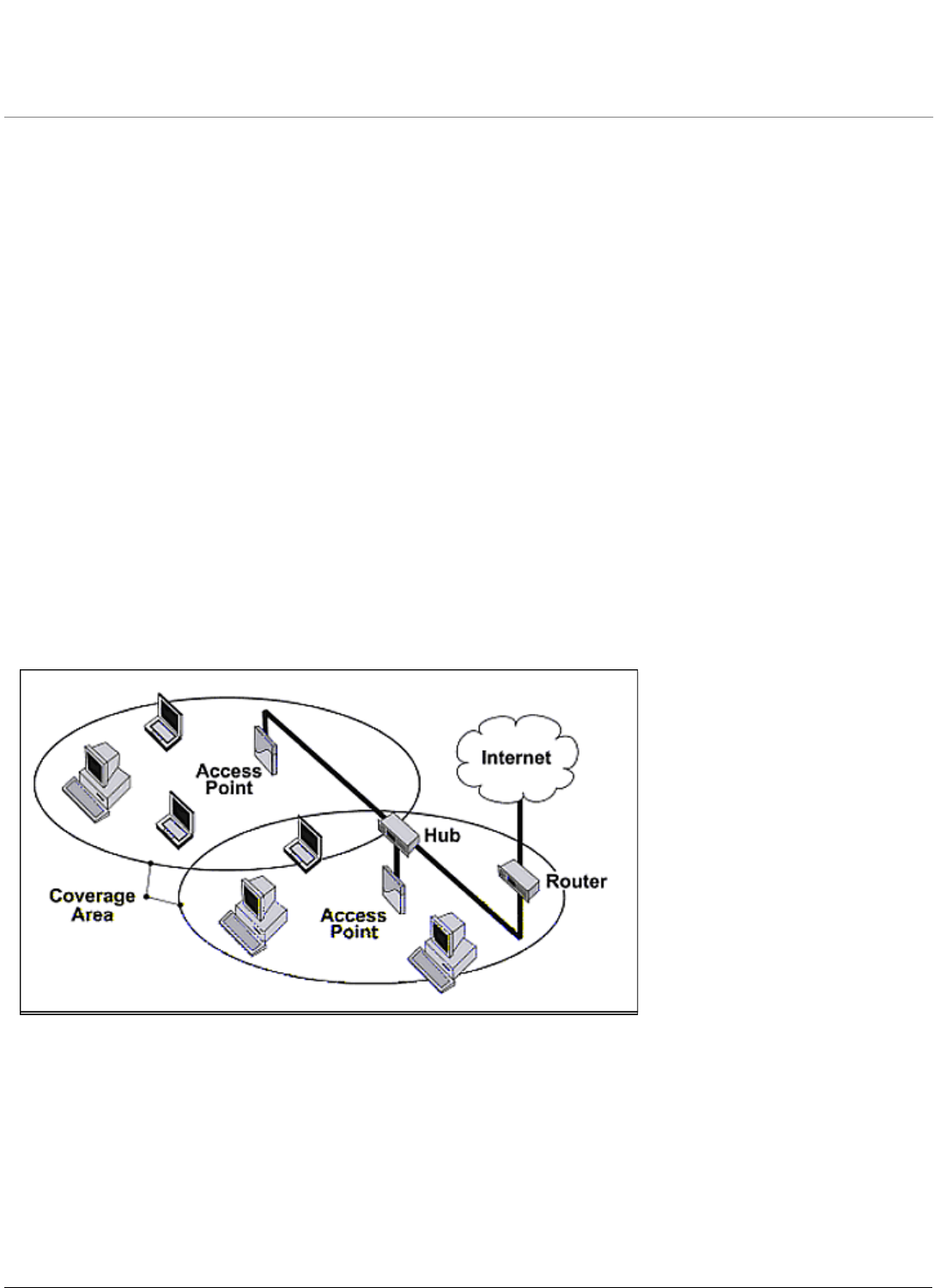
8
AP-700 User Guide
1
Introduction
This chapter contains information on the following:
•Introduction to Wireless Networking
•Guidelines for Roaming
•Management and Monitoring Capabilities
Introduction to Wireless Networking
An Access Point extends the capability of an existing Ethernet network to devices on a wireless network. Wireless
devices can connect to a single Access Point, or they can move between multiple Access Points located within the same
vicinity. As wireless clients move from one coverage cell to another, they maintain network connectivity.
In a typical network environment (see Figure 1-1), the AP functions as a wireless network access point to data and voice
networks. An AP network provides:
• Seamless client roaming for both data and voice (VoIP)
• Easy installation and operation
• Over-the-air encryption of data
• High speed network links
Figure 1-1 Typical Wireless Network Access Infrastructure
Guidelines for Roaming
• Typical voice network cell coverages vary based on environment. Proxim recommends having a site survey done
professionally to ensure optimal performance. For professional site surveyors, Ekahau™ Site Survey software is
included in the Xtras folder of the Installation CD.
• An AP can only communicate with client devices that support its wireless standards.
• All Access Points must have the same Network Name to support client roaming.

Introduction AP-700 User Guide
Management and Monitoring Capabilities
9
• All workstations with an 802.11 client adapter installed must use either a Network Name of “any” or the same Network
Name as the Access Points that they will roam between. If an AP has Closed System enabled, a client must have the
same Network Name as the Access Point to communicate (see Reboot the AP.).
• All Access Points and clients must have matching security settings to communicate.
• The Access Points’ cells should overlap to ensure that there are no gaps in coverage and to ensure that the roaming
client will always have a connection available. To ensure optimal AP placement, Proxim recommends having a site
survey done professionally to ensure optimal performance. For professional site surveyors, Ekahau™ Site Survey
software is included in the Xtras folder of the Installation CD.
• All Access Points in the same vicinity should use a unique, independent channel. By default, the AP automatically
scans for available channels during boot-up but you can also set the channel manually (see Interfaces for details).
• Access Points that use the same channel should be installed as far away from each other as possible to reduce
potential interference.
Management and Monitoring Capabilities
There are several management and monitoring interfaces available to the network administrator to configure and
manage an AP on the network:
•HTTP/HTTPS Interface
•Command Line Interface
•SNMP Management
•SSH (Secure Shell) Management
HTTP/HTTPS Interface
The HTTP Interface (Web browser Interface) provides easy access to configuration settings and network statistics from
any computer on the network. You can access the HTTP Interface over your LAN (switch, hub, etc.), over the Internet, or
with a “crossover” Ethernet cable connected directly to your computer’s Ethernet Port.
HTTPS provides an HTTP connection over a Secure Socket Layer. HTTPS is one of three available secure management
options on the AP; the other secure management options are SNMPv3 and SSH. Enabling HTTPS allows the user to
access the AP in a secure fashion using Secure Socket Layer (SSL) over port 443. The AP supports SSLv3 with a 128-bit
encryption certificate maintained by the AP for secure communications between the AP and the HTTP client. All
communications are encrypted using the server and the client-side certificate.
The AP comes pre-installed with all required SSL files: default certificate, private key and SSL Certificate Passphrase
installed.
Command Line Interface
The Command Line Interface (CLI) is a text-based configuration utility that supports a set of keyboard commands and
parameters to configure and manage an AP.
Users enter Command Statements, composed of CLI Commands and their associated parameters. Statements may be
issued from the keyboard for real time control, or from scripts that automate configuration.
For example, when downloading a file, administrators enter the download CLI Command along with IP Address, file
name, and file type parameters.
You access the CLI over a HyperTerminal serial connection or via Telnet. During initial configuration, you can use the CLI
over a serial port connection to configure an Access Point’s IP address. When accessing the CLI via Telnet, you can
communicate with the Access Point from over your LAN (switch, hub, etc.), from over the Internet, or with a “crossover”
Ethernet cable connected directly to your computer’s Ethernet Port. See Command Line Interface (CLI) for more
information on the CLI and for a list of CLI commands and parameters.

Introduction AP-700 User Guide
Management and Monitoring Capabilities
10
SNMP Management
In addition to the HTTP and the CLI interfaces, you can also manage and configure an AP using the Simple Network
Management Protocol (SNMP). Note that this requires an SNMP manager program, like HP Openview or Castlerock’s
SNMPc. The AP supports several Management Information Base (MIB) files that describe the parameters that can be
viewed and/or configured over SNMP:
• MIB-II (RFC 1213)
• Bridge MIB (RFC 1493)
• Ethernet-like MIB (RFC 1643)
• 802.11 MIB
• ORiNOCO Enterprise MIB
Proxim provides these MIB files on the CD-ROM included with each Access Point. You need to compile one or more of
the above MIBs into your SNMP program’s database before you can manage an Access Point using SNMP. See the
documentation that came with your SNMP manager for instructions on how to compile MIBs.
The Enterprise MIB defines the read and read-write objects that can be viewed or configured using SNMP. These objects
correspond to most of the settings and statistics that are available with the other management interfaces. See the
Enterprise MIB for more information; the MIB can be opened with any text editor, such as Microsoft Word, Notepad, or
WordPad.
SNMPv3 Secure Management
SNMPv3 is based on the existing SNMP framework, but addresses security requirements for device and network
management.
The security threats addressed by Secure Management are:
•Modification of information: An entity could alter an in-transit message generated by an authorized entity in such a
way as to effect unauthorized management operations, including the setting of object values. The essence of this
threat is that an unauthorized entity could change any management parameter, including those related to
configuration, operations, and accounting.
•Masquerade: Management operations that are not authorized for some entity may be attempted by that entity by
assuming the identity of an authorized entity.
•Message stream modification: SNMP is designed to operate over a connectionless transport protocol. There is a
threat that SNMP messages could be reordered, delayed, or replayed (duplicated) to effect unauthorized
management operations. For example, a message to reboot a device could be copied and replayed later.
•Disclosure: An entity could observe exchanges between a manager and an agent and thereby could learn of notifiable
events and the values of managed objects. For example, the observation of a set command that changes passwords
would enable an attacker to learn the new passwords.
To address the security threats listed above, SNMPv3 provides the following when secure management is enabled:
• Authentication: Provides data integrity and data origin authentication.
• Privacy (a.k.a Encryption): Protects against disclosure of message payload.
• Access Control: Controls and authorizes access to managed objects.
The default SNMPv3 username is administrator, with SHA authentication, and DES privacy protocol.
SSH (Secure Shell) Management
You may securely also manage the AP using SSH (Secure Shell). The AP supports SSH version 2, for secure remote CLI
(Telnet) sessions. SSH provides strong authentication and encryption of session data.

Introduction AP-700 User Guide
Management and Monitoring Capabilities
11
The SSH server (AP) has host keys - a pair of asymmetric keys - a private key that resides on the AP and a public key
that is distributed to clients that need to connect to the AP. As the client has knowledge of the server host keys, the client
can verify that it is communicating with the correct SSH server.
NOTE: The remainder of this guide describes how to configure an AP using the HTTP Web interface or the CLI interface.
For information on how to manage devices using SNMP or SSH, see the documentation that came with your
SNMP or SSH program. Also, see the MIB files for information on the parameters available via SNMP and SSH.
IMPORTANT!
The remainder of the User Guide discusses installing your AP and managing it using the Web and CLI
interfaces only.

12
AP-700 User Guide
2
Installation and Initialization
In this chapter:
•AP-700 Hardware Description
–Overview
–LED Indicators
–Power-over-Ethernet (PoE)
–Antennas
•Prerequisites
•System Requirements
•Product Package
•Hardware Installation
–Attach Cables
–Install the Security Cover (Optional)
–Mount the AP-700
–Power On the Unit
–Install External Antennas (Professional Installation Required)
•Initialization
–Using ScanTool
–Logging In
–Using the Setup Wizard
–Installing the Software
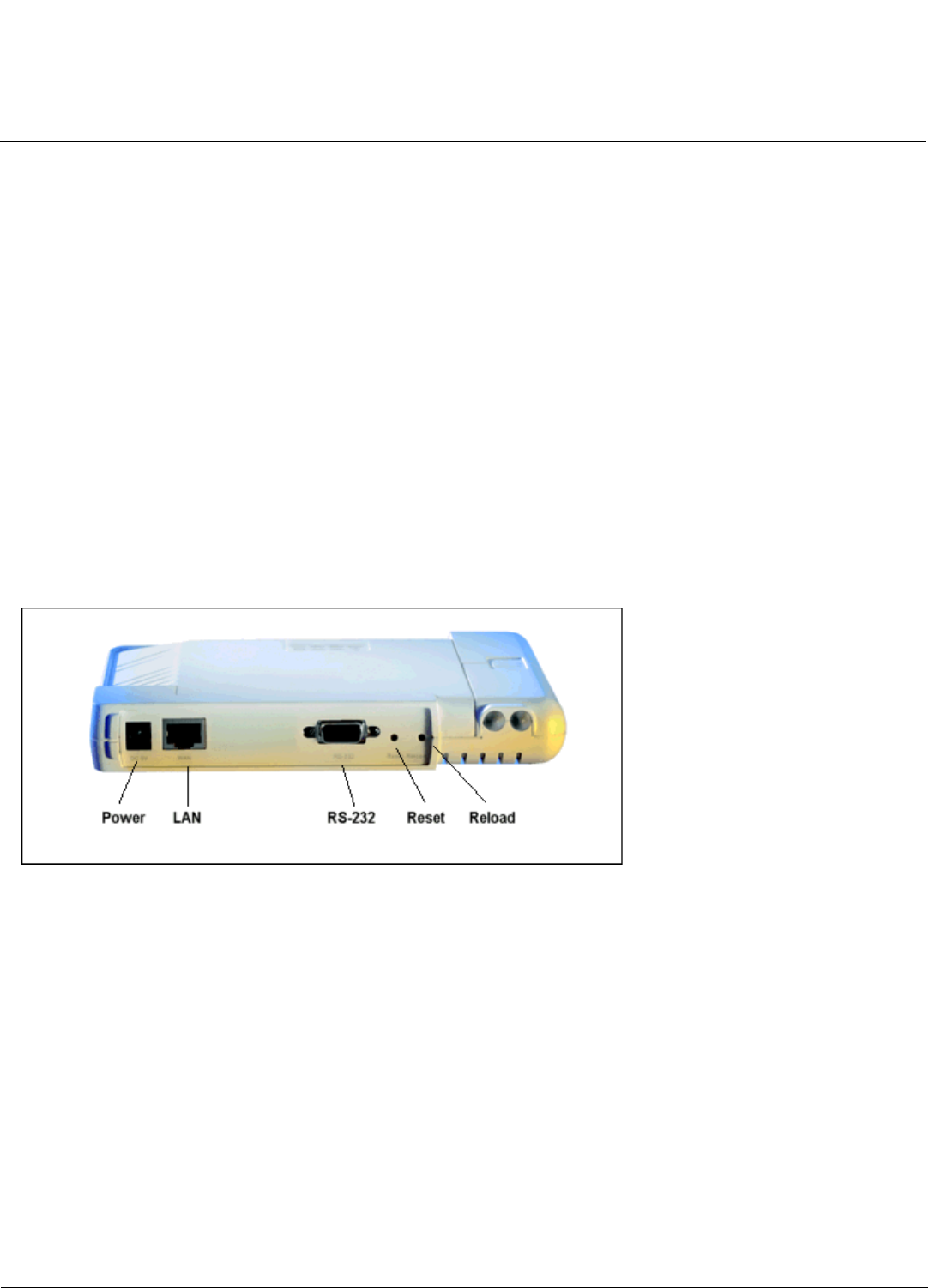
Installation and Initialization AP-700 User Guide
AP-700 Hardware Description
13
AP-700 Hardware Description
Overview
The AP-700 is a tri-mode AP that supports 802.11b, 802.11g, or 802.11a clients. The unit contains one embedded
802.11a/b/g radio that supports the following operational modes:
• 802.11a only mode
• 802.11b only mode
• 802.11g only mode
• 802.11b/g mode
• 802.11g-wifi
NOTE: In countries in which 802.11a (5 GHz) is not available for use, the AP-700 provides dual-band (802.11b and
802.11g) support only. 802.11a functionality covered in this User Guide is not supported.
The AP-700 can be powered through either PoE (802.3af Power-over-Ethernet) or through an external DC power source
using the power cord.
The AP-700 includes a a power jack, a 10/100 base-T Ethernet port, and an RS-232 serial data communication port. See
Figure 2-1. The AP includes an optional security cover that can be installed to protect against access to the power and
LAN cables and to the reset and reload buttons.
Figure 2-1 Rear Panel
The unit has been designed to rest horizontally on a flat surface, but can be wall- or ceiling- mounted with the long axis
vertical. The unit includes screw slots in the bottom plastic for mounting to a flat wall or ceiling.
LED Indicators
The top panel of the AP-700 has the following LED indicators. See Power On the Unit for a description of LED behavior.

Installation and Initialization AP-700 User Guide
AP-700 Hardware Description
14
Figure 2-2 LED Indicators on the Top Panel
Power-over-Ethernet (PoE)
The AP-700 is equipped with an 802.3af-compliant Power-over-Ethernet (PoE) module. PoE delivers both data and
power to the access point over a single Ethernet cable. If you choose to use PoE, there is no difference in operation; the
only difference is in the power source.
• The PoE integrated module receives ~48 VDC over a standard Category 5 Ethernet cable.
• To use PoE, you must have a PoE hub (also known as a power injector) connected to the network.
• The cable length between the PoE hub and the Access Point should not exceed 100 meters (approximately 325 feet).
The PoE hub is not a repeater and does not amplify the Ethernet data signal.
• If connected to an PoE hub and an AC power supply simultaneously, the Access Point draws power from PoE.
Also see Hardware Installation.
NOTE: The AP’s 802.3af-compliant PoE module is backwards compatible with all ORiNOCO Active Ethernet (PoE) hubs
that do not support the IEEE 802.3af standard.
Antennas
The AP-700 employs two internal antennas for antenna diversity: one is vertically polarized, and the other is horizontally
polarized to provide optimal spatial and polarization diversity. When the AP is hung on the wall of an office or building, the
horizontally polarized antenna provides coverage for that particular floor level. The vertically polarized antenna provides
spatial diversity for the horizontally polarized antenna in the event of an antenna null. In addition, the vertically polarized
antenna provides some coverage above and below the current floor level. When the AP is mounted on the ceiling or
sitting on a table, the effect is the same, but the roles of the two antennas switch.
The AP supports both receive and transmit diversity. When receiving, the AP chooses the antenna that receives the
strongest signal. When transmitting, the AP chooses the antenna with the highest success rate, and broadcasts are
transmitted on alternating antennas.
Antenna diversity is enabled by default (set to “auto”). When using the internal antennas, Proxim recommends leaving
antenna diversity enabled. However, you may disable antenna diversity by manually selecting which antenna to use
through the Command Line Interface. See Configure Antenna Diversity for information.
See External Antennas for information and Install External Antennas (Professional Installation Required) for installation
instructions.
Ethernet Wireless Power
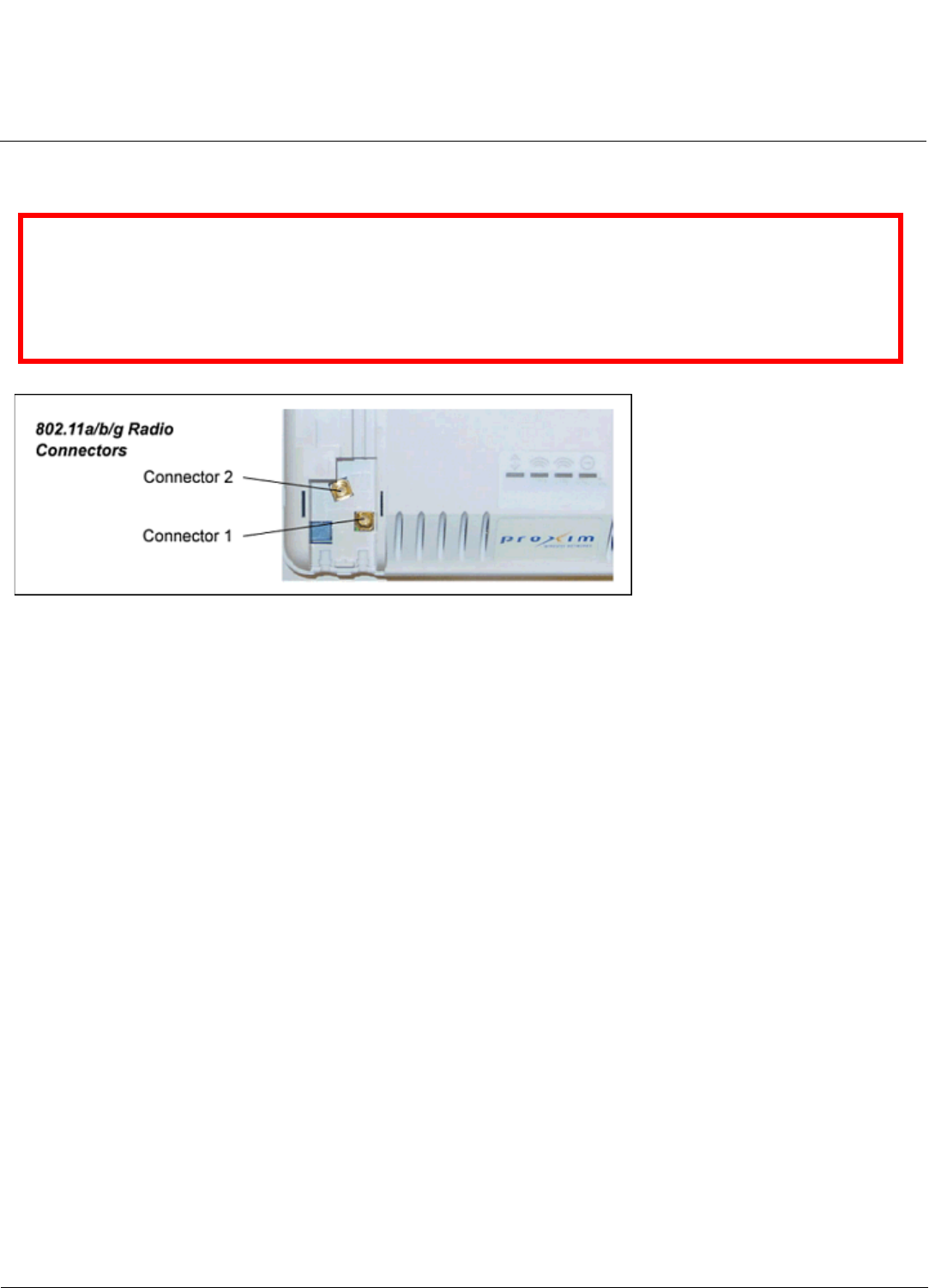
Installation and Initialization AP-700 User Guide
AP-700 Hardware Description
15
External Antennas
The AP-700 also has two antenna connectors for use with external antennas.
Figure 2-3 AP-700 Antenna Connectors
When the AP is mounted on a wall, connector 1 corresponds to the horizontally polarized internal antenna, providing a
coverage pattern parallel to the wall; connector 2 corresponds to the vertically polarized internal antenna, providing a
coverage pattern parallel to the ceiling/floor. When the AP is mounted to a ceiling, connector 1 corresponds to the
vertically polarized internal antenna, and connector 2 corresponds to the horizontally polarized internal antenna. Plugging
an external antenna in to the antenna connector disables the corresponding internal antenna.
The AP continues to support antenna diversity with external antennas connected. With one external antenna connected
to one of the two antenna connectors on a radio, one internal antenna and one external antenna are used for antenna
diversity. With two external antennas connected, both external antennas are used for antenna diversity, and both internal
antennas are disabled.
With external antennas connected, you may wish to manually select a particular antenna for use. To do so, disable
antenna diversity by manually selecting which antenna to use through the Command Line Interface. See Configure
Antenna Diversity for information.
NOTE: Using two external antennas is not recommended.
For a list of recommended antennas, see http://www.proxim.com/products/wifi/accessories.
For installation instructions, see Install External Antennas (Professional Installation Required).
NOTE:
AP-700 units using external antennas must be installed by a suitably trained professional installation
technician or by a qualified installation service.
See Hardware Installation for AP cabling and mounting instructions, and Install External Antennas
(Professional Installation Required) for external antenna installation instructions.

Installation and Initialization AP-700 User Guide
Prerequisites
16
Prerequisites
Before installing your unit, you need to gather certain network information. The following table identifies the information
you need.
System Requirements
To begin using an AP, you must have the following minimum requirements:
• A 10Base-T Ethernet or 100Base-TX Fast Ethernet switch or hub or cross-over Ethernet cable
• At least one of the following IEEE 802.11-compliant devices:
– An 802.11a, 802.11b, or 802.11b/g client device
• A computer that is connected to the same IP network as the AP and has one of the following Web browsers installed:
– Microsoft® Internet Explorer 6 with Service Pack 1 or later and patch Q323308
– Netscape® 7.1 or later
Network Name (SSID of the
wireless cards)
You must assign the Access Point a Network Name before wireless users can
communicate with it. The clients also need the same Network Name. This is not the
same as the System Name, which applies only to the Access Point. The network
administrator typically provides the Network Name.
AP’s IP Address If you do not have a DHCP server on your network, then you need to assign the
Access Point an IP address that is valid on your network.
HTTP Password Each Access Point requires a read/write password to access the web interface. The
default password is public.
CLI Password Each Access Point requires a read/write password to access the CLI interface. The
default password is public.
SNMP Read Password Each Access Point requires a password to allow get requests from an SNMP
manager. The default password is public.
SNMP Read-Write Password Each Access Point requires a password to allow get and set requests from an SNMP
manager. The default password is public.
SNMPv3 Authentication
Password
If Secure Management is enabled, each Access Point requires a password for sending
authenticated SNMPv3 messages. The default password is public. The default
SNMPv3 username is administrator, with SHA authentication, and DES privacy
protocol.
SNMPv3 Privacy Password If Secure Management is enabled, each Access Point requires a password when
sending encrypted SNMPv3 data. The default password is public.
Security Settings You need to determine what security features you will enable on the Access Point.
Authentication Method A primary authentication server may be configured; a backup authentication server is
optional. The network administrator typically provides this information.
Authentication Server Shared
Secret
This is a password shared between the Access Point and the RADIUS authentication
server (so both passwords must be the same), and is typically provided by the network
administrator.
Authentication Server
Authentication Port
This is a port number (default is 1812) and is typically provided by the network
administrator.
Client IP Address Pool
Allocation Scheme
The Access Point can automatically provide IP addresses to clients as they sign on.
The network administrator typically provides the IP Pool range.
DNS Server IP Address The network administrator typically provides this IP Address.
Gateway IP Address and
Subnet Mask
The gateway IP address and subnet mask of the network environment where the
Access Point is deployed.
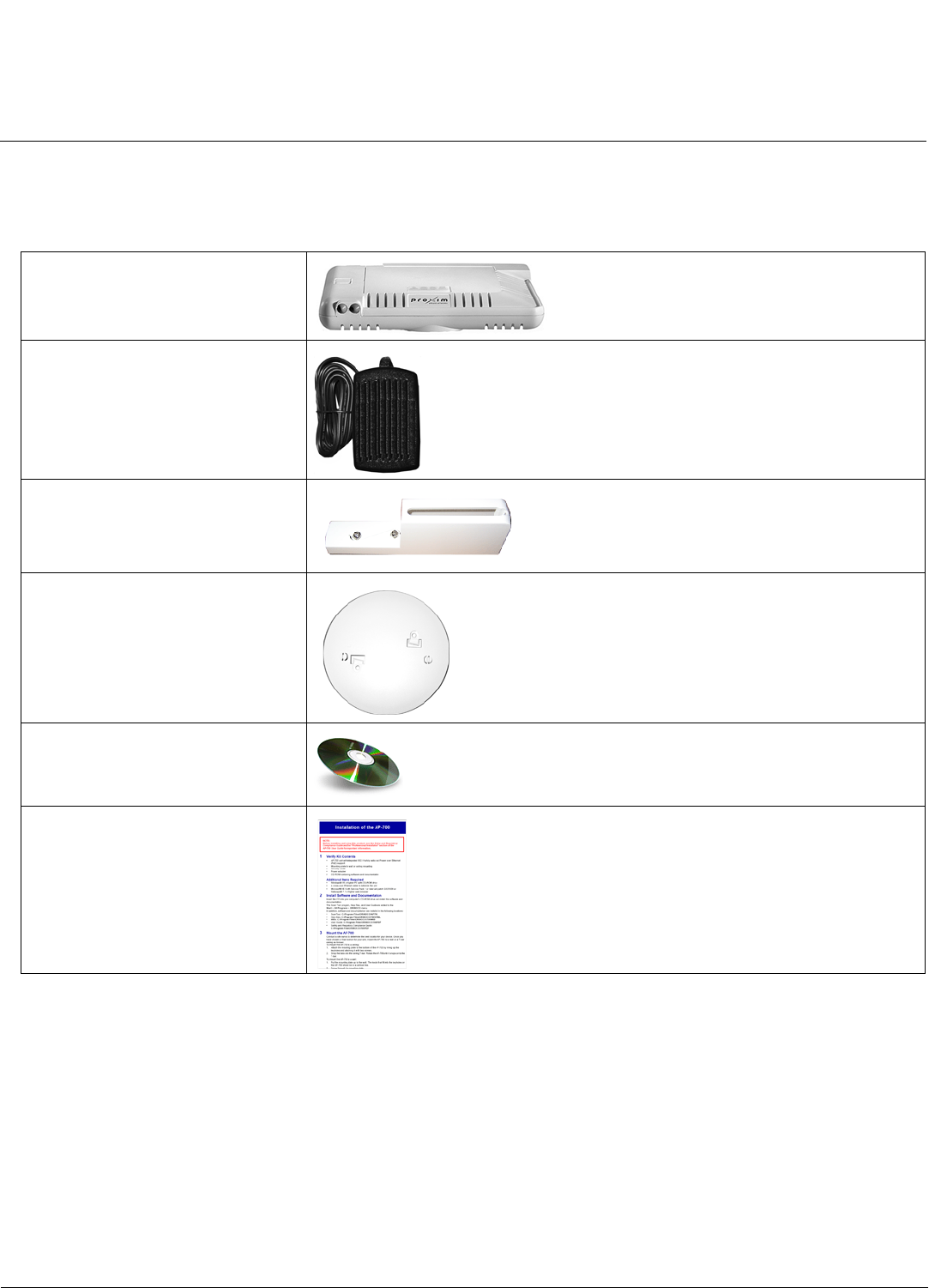
Installation and Initialization AP-700 User Guide
Product Package
17
Product Package
Each AP-700 shipment includes the items in the following table. Verify that you have received all parts of the shipment.
NOTE: Unless noted in this table, cables are not supplied with the unit.
AP-700 Unit
Power Cord
Security Cover
Ceiling/Wall Mount Plate
Installation CD
Quick Installation Guide

Installation and Initialization AP-700 User Guide
Hardware Installation
18
Hardware Installation
Perform the following procedures to install the AP hardware:
•Attach Cables
•Install the Security Cover (Optional)
•Mount the AP-700
•Power On the Unit
Attach Cables
Cabling without Power Over Ethernet (PoE)
1. Plug the barrel of the power cable from the power supply into the power jack (the left-most port in the back of the unit,
see figure).
2. Connect one end of an Ethernet cable (not supplied) to the unit’s LAN port (see figure). The other end of the cable
should not be connected to another device until after installation is complete:
• Use a straight-through Ethernet cable if you intend to connect the unit to a switch, hub, or patch panel.
NOTE:
AP-700 units using external antennas must be installed by a suitably trained professional installation
technician or by a qualified installation service.
NOTE:
Before installing and using this product, see the Safety and Regulatory Compliance Guide.
NOTE:
Avant d’installer et d’utiliser ce produit, consultez le manuel Safety and Regulatory Compliance
Guide.
NOTA:
Prima dell’installazione e dell’utilizzo del prodotto, consultare il documento Safety and Regulatory
Compliance Guide (Guida per la sicurezza e la conformità alle normative).
ANMERKUNG:
Lesen Sie vor der Installation und Verwendung dieses Produkts die wichtigen Informationen im
Handbuch Safety and Regulatory Compliance Guide.
NOTA:
Antes de instalar y utilizar este producto, consulte el manual Safety and Regulatory Compliance
Guide (Manual de seguridad y cumplimiento de la normativa).
注記 :
この製品をインストールして使用する前に、
『
Safety and Regulatory Compliance Guide
』
.
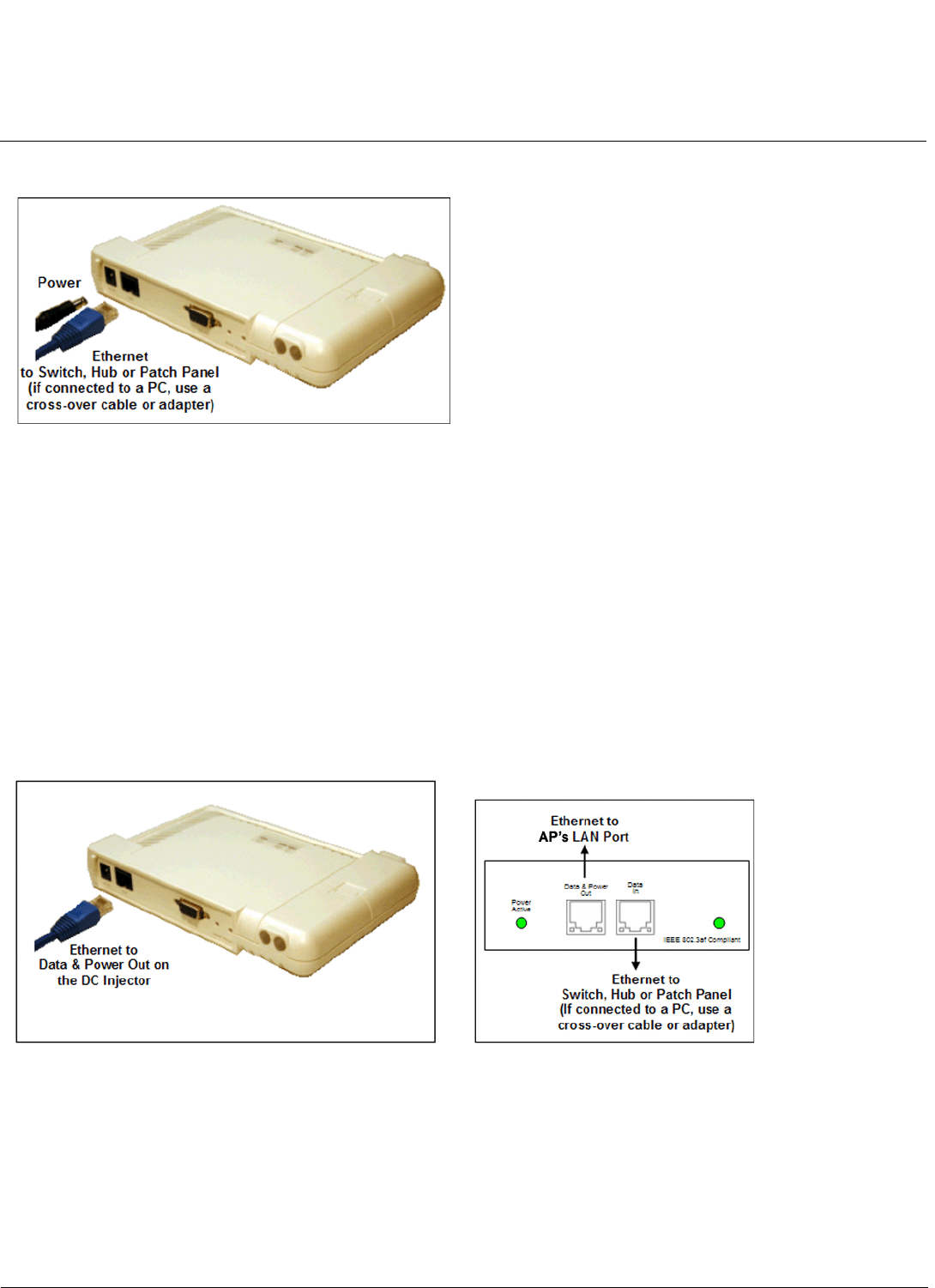
Installation and Initialization AP-700 User Guide
Hardware Installation
19
• Use a cross-over Ethernet cable or adapter if you intend to connect the unit to a single computer.
Figure 2-4 Cabling without PoE
3. Optionally, connect an RS-232 cable (not shown) to the RS-232 console port (the right port, labeled “RS-232”).
NOTE: You cannot install the security cover to the AP-700 if an RS-232 cable is connected.
4. Continue with Install the Security Cover (Optional).
Cabling with Power Over Ethernet (PoE)
1. To use PoE, you must use a PoE adapter such as the ORiNOCO 1-Port Active Ethernet DC Injector (ordered
separately). Connect one end of an Ethernet cable (not supplied) to the unit’s LAN port. Connect the other end to the
Data and Power Out port of the DC Injector (see figure).
2. Connect one end of a second Ethernet cable (not supplied) to the Data In port of the DC Injector (see figure). The
other end of the cable should not be connected to another device until after installation is complete:
• Use a straight-through Ethernet cable if you intend to connect the unit to a switch, hub, or patch panel.
• Use a cross-over Ethernet cable or adapter if you intend to connect the unit to a single computer.
Figure 2-5 Cabling with PoE
3. Optionally, connect an RS-232 cable (not shown) to the RS-232 console port (the right port, labeled “RS-232”).
NOTE: You cannot install the security cover to the AP-700 if an RS-232 cable is connected.
4. Continue with Install the Security Cover (Optional) below.
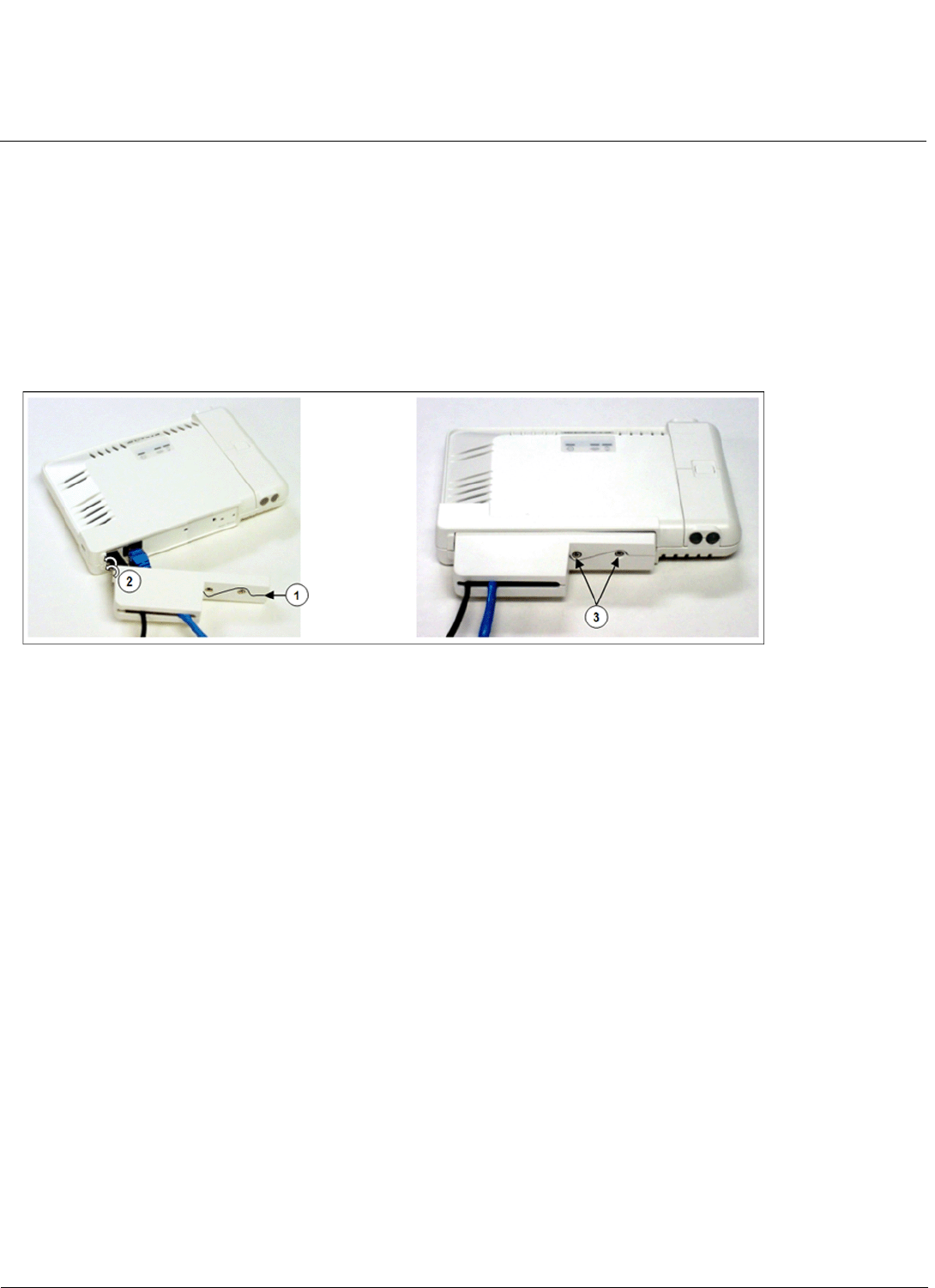
Installation and Initialization AP-700 User Guide
Hardware Installation
20
Install the Security Cover (Optional)
You can optionally install a security cover to deter unauthorized access to the unit. The security cover is a plastic
enclosure that prevents access to the cabling and the Reset and Reload buttons.
1. Open the split end of the security cover just enough to slide the power cable (if not using PoE) and the Ethernet cable
through the opening until they fit inside the straight clamping portion of the cover (see figure). Exercise care as you
slide the cable(s) so you do not accidentally break the cover.
2. Slide the hinging end of the security cover into the hole on the rear panel of the unit to the left of the connectors. Once
in place, pivot the right side of the cover to bring it close to the rear panel of the unit.
3. Use the two attached screws to fasten the security cover onto the rear panel of the unit.
Figure 2-6 Installing the Security Cover
Mount the AP-700
Proxim recommends that you have a site survey professionally conducted to determine the best location for the AP. For
professional site surveyors, Ekahau Site Survey software is included in the Xtras folder on the Installation CD-ROM.
Note that the AP-700 has been certified under UL Standard 2043 and can be installed in the plenum. In an office building,
plenum is the space between the structural ceiling and the tile ceiling that is provided to help air circulate. Many
companies also use the plenum to house communication equipment and cables. These products and cables must
comply with certain safety requirements, such as Underwriter Labs (UL) Standard 2043: “Standard for Fire Test for Heat
and Visible Smoke Release for Discrete Products and Their Accessories Installed in Air-Handling Spaces”.
NOTE: When installed in a plenum, the AP must use PoE.
Once you have chosen a final location for your unit, the following are the mounting options are available:
•Wall Mounting
•Ceiling Mounting
Wall Mounting
Follow these steps to mount the unit on a wall:
1. If the unit’s power supply is plugged in, unplug it.
2. Put the mounting plate up to the wall so that the embossed letter “L” is on top (see figure). If the plate is correctly
oriented, the circular tab that is vertically aligned with the square hole should be on top.
3. Fasten the mounting plate with two screws through the circular holes of the plate. Depending on the type of wall, you
may need to use the two fasteners provided.
4. Holding the unit so that the connectors on the rear are facing left, align the two holes on the bottom of the unit with the
two tabs on the mounting plate. Press the unit down so it is flush with the plate.
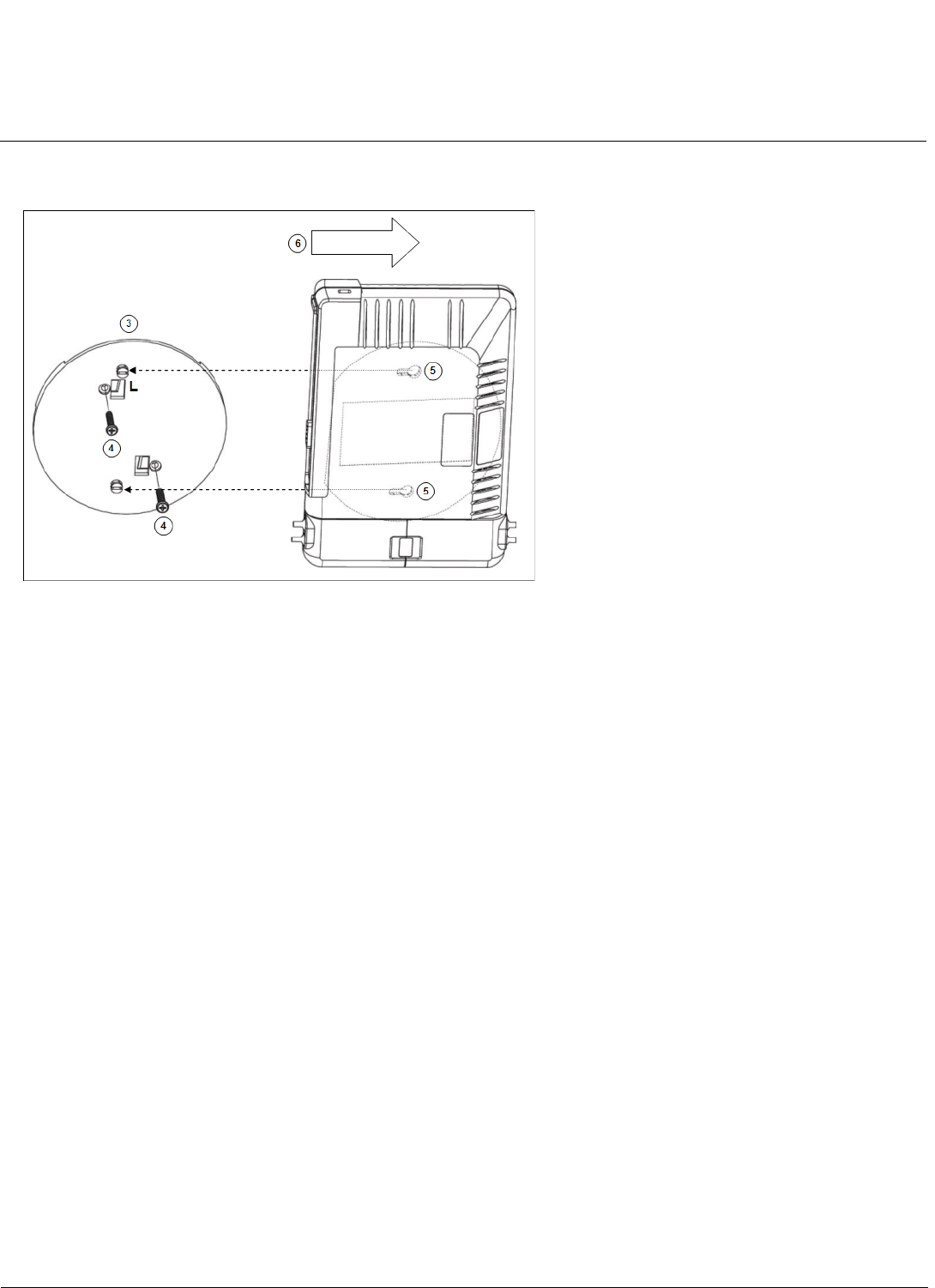
Installation and Initialization AP-700 User Guide
Hardware Installation
21
5. Carefully slide the unit to the right until the tabs snap securely onto the narrow holes of the unit. If the unit is mounted
correctly, no portion of the mounting plate should protrude from any of the sides of the unit.
Figure 2-7 Mounting the AP to a Wall
Ceiling Mounting
Follow these steps to mount the unit to a ceiling:
1. If the unit’s power supply is plugged in, unplug it.
2. Snap the rectangular tabs on the back of the mounting plate onto a ceiling T-bar. You may need to slightly rotate the
plate until it securely snaps onto the T-bar.
3. Fasten the mounting plate to the ceiling tile with two screws through the circular holes of the plate.
4. Position so that the embossed letter “L” on the mounting plate is facing up (see previous figure). Holding the unit so
that the connectors on the rear are facing to left, align the two holes on the bottom of the unit with the two tabs on the
mounting plate. Press the unit up so it is flush with the plate.
5. Carefully slide the unit to the right until the tabs snap securely onto the narrow holes of the unit. If the unit is mounted
correctly, no portion of the mounting plate should protrude from any of the sides of the unit.
Power On the Unit
The AP can be powered by a power supply (just plug the power cord of the power supply into an AC power outlet), or by
Power-over-Ethernet (connect a PoE DC injector to the Ethernet cable).
When the unit is powered on, it performs startup diagnostics. When startup is completed, the LEDs show the operational
state of the unit.

Installation and Initialization AP-700 User Guide
Hardware Installation
22
The LED indicators exhibit the following behavior:
Install External Antennas (Professional Installation Required)
Optionally, you can connect two external antennas to your AP.
All products using external antennas must be professionally installed, and the transmit power of the system must be
adjusted by the professional installers to ensure that the system EIRP is in compliance with the limit specified by the
regulatory authority of the country of application.
See the following sections for more information:
•Connecting Antenna(s)
•Adjusting Tx Output Power
•Antenna Types and Maximum Gain
Connecting Antenna(s)
Follow the mounting instructions included with your external antenna, and then connect the antenna cable to the AP, as
follows:
1. Press down near the center of the compartment covering and slide open the external antenna access compartments.
The compartment closer to the LED panel contains the connectors.
NOTE: AP-700 models 8675-US2 and 8675-AU do not provide external antenna connectors for 5 GHz (802.11a)
operation.
Indication Ethernet Wireless Interface
(802.11a/b/g radio)
Power
Solid Green Ethernet interface is connected
at 100 Mbps with no traffic.
Wireless interface is preparing
for use.
AP image running.
Blinking Green Ethernet interface is connected
at 100 Mbps with traffic.
Wireless interface is transmitting
or receiving wireless packets.
n/a
Solid Amber Ethernet interface is connected
at 10 Mbps with no traffic.
n/a The Bootloader is loading the
application software.
Blinking Amber The Ethernet interface is
connected at 10 Mbps with
traffic.
n/a The AP is reloading.
Solid Red n/a n/a Power On Self Test (POST)
running.
Blinking Red n/a n/a Rebooting.
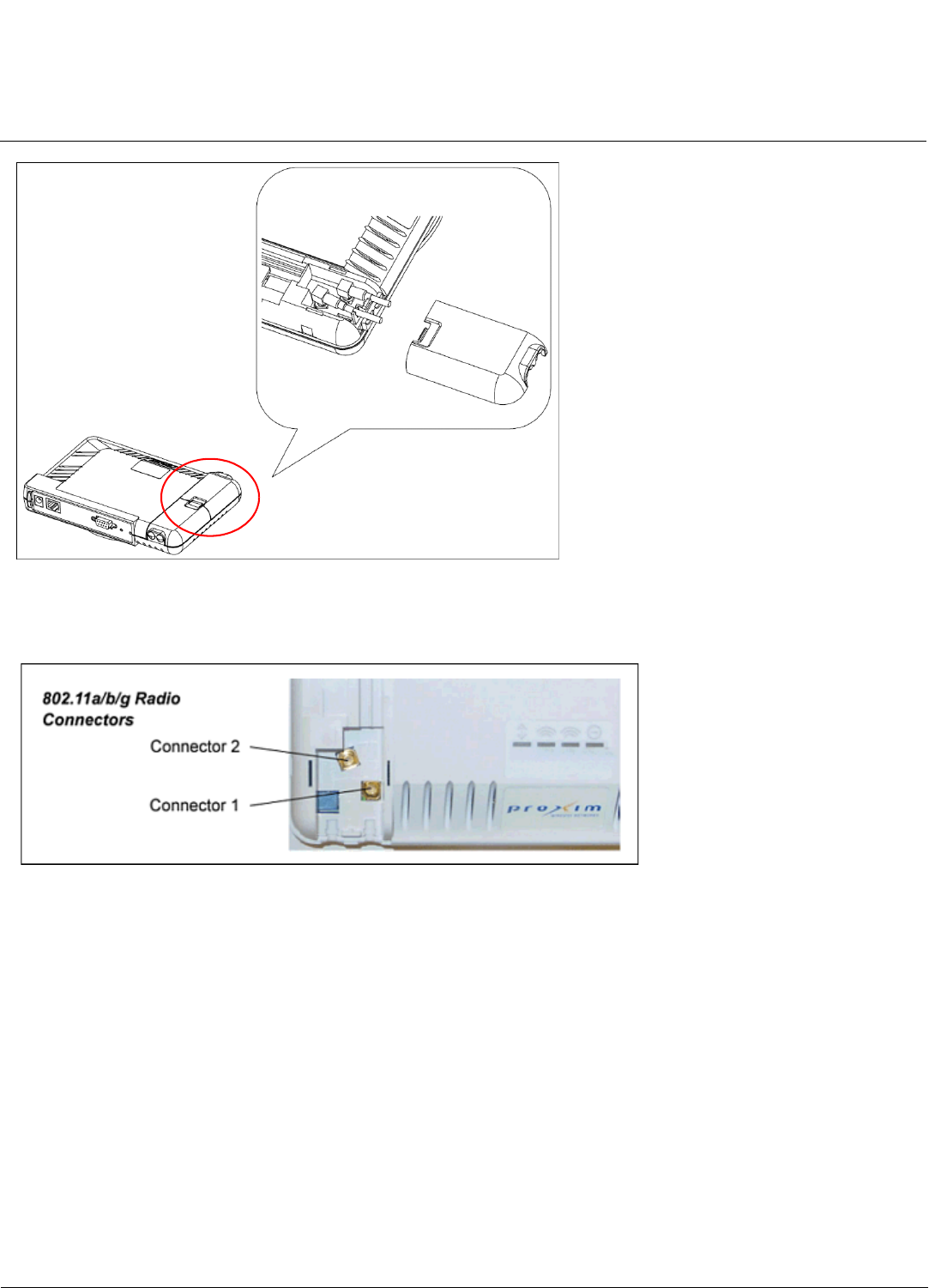
Installation and Initialization AP-700 User Guide
Hardware Installation
23
Figure 2-8 Opening the Antenna Compartment
2. There are two antenna connectors in the AP-700, labeled 1 and 2 Connect the antenna cable to connector 1 (the
connector closer to the LED panel in the compartment).
Figure 2-9 Antenna Connectors
3. If installing a second external antenna (not recommended), connect the antenna cable to connector 2.
4. Close the external antenna access compartment.
5. If desired, manually select which antenna(s) to use through the Command Line Interface. See Configure Antenna
Diversity.
Adjusting Tx Output Power
NOTE: When the system is set to transmit at the maximum power, professional installers must ensure that the maximum
EIRP limit is not exceeded. To achieve this, they may have to add attenuation between the device and the
antenna when a high gain antenna is used.
Use the following formula in combination with the table of EIRP limits in US, Canada, and EU countries to calculate
system transmit power (based on EIRP limits) of these countries:
Tx Power (dBm) = EIRP Limit (dBm) + FL (dB) – G (dB)
where:
Tx Power = Output power measured at the antenna input

Installation and Initialization AP-700 User Guide
Hardware Installation
24
EIRP Limit = EIRP limits specified below
FL = Feeder loss including loss of connectors
G = Antenna Gain
Antenna Types and Maximum Gain
For devices using external antennas, professional installers should select only the antenna types listed in the following
table, with gain not exceeding the listed maximum gain for each type.
Band EIRP Limit (dBm)
USA and Canada EU
2.4 - 2.4835 GHz (Point-to-Multipoint 36 20
2.4 - 2.4835 GHz (Point-to-Point) When G < 6: 36
When G >/= 6, use the following
equation:
36 -
20
5.15 - 5.25 GHz 23 23
5.25 - 5.35 GHz 30 23
5.47 - 5.725 GHz 30 30
5.725 - 5.850 GHz (Point-to-Multipoint) 36 14
5.725 - 5.850 GHz (Point-to-Point) No limit 14
Frequency Band Antenna Type Maximum Gain
2.4 GHz Omni 10
Panel 14
Yagi 14
Parabolic 24
5 GHz Omni 13
Panel 28.2
Sector 17
Parabolic 33.4
G6–
3
--------------

Installation and Initialization AP-700 User Guide
Initialization
25
Initialization
The following sections detail how to initialize the AP using ScanTool, log in to the HTTP interface, perform an initial
configuration of the AP using the Setup Wizard, and download the required AP software.
•Using ScanTool
•Logging In
•Using the Setup Wizard
•Installing the Software
Using ScanTool
ScanTool is a software utility that is included on the installation CD-ROM. It is an initial configuration tool that allows you
to find the IP address of an Access Point by referencing the MAC address in a Scan List, or to assign an IP address if one
has not been assigned.
The tool automatically detects the Access Points installed on your network, regardless of IP address, and lets you
configure each unit’s IP settings. In addition, you can use set initial device parameters that will allow the AP to retrieve a
new software to an AP that does not have a valid software image installed (see Client Connection Problems).
To access the HTTP interface and configure the AP, the AP must be assigned an IP address that is valid on its Ethernet
network. By default, the AP is configured to obtain an IP address automatically from a network Dynamic Host
Configuration Protocol (DHCP) server during boot-up. If your network contains a DHCP server, you can run ScanTool to
find out what IP address the AP has been assigned. If your network does not contain a DHCP server, the Access Point’s
IP address defaults to 169.254.128.132. In this case, you can use ScanTool to assign the AP a static IP address that is
valid on your network.
ScanTool Instructions
Follow these steps to install ScanTool and initialize the AP:
1. Power up, reboot, or reset the AP.
2. Double-click the ScanTool icon on the Windows desktop to launch the program (if the program is not already
running). If the icon is not on your desktop, click Start > All Programs > ORiNOCO > AP-700 > ScanTool.
NOTE: If your computer has more than one network adapter installed, you will be prompted to select the adapter that
you want ScanTool to use before the Scan List appears. You can use either an Ethernet or wireless adaptor.
If prompted, select an adapter and click OK. You can change your adapter setting at any time by clicking the
Select Adapter button on the Scan List screen.
ScanTool scans the subnet and displays all detected Access Points. The ScanTool’s Scan List screen appears, as
shown in the following example.
Figure 2-10 Scan List
3. Locate the MAC address of the AP you want to initialize within the Scan List.
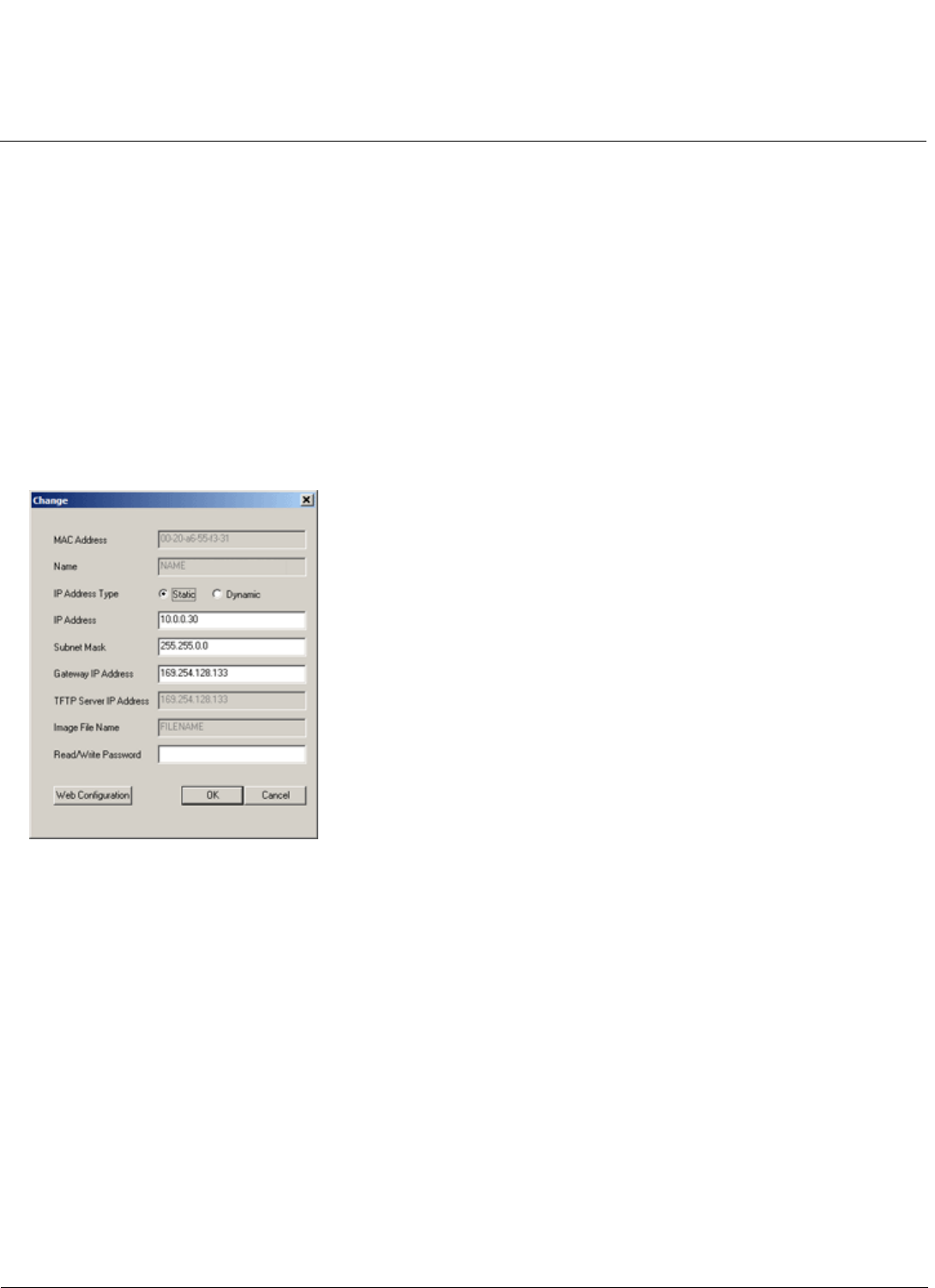
Installation and Initialization AP-700 User Guide
Initialization
26
NOTE: If your Access Point does not appear in the Scan List, click the Rescan button to update the display. If the unit
still does not appear in the list, see Troubleshooting for suggestions. Note that after rebooting an Access
Point, it may take up to five minutes for the unit to appear in the Scan List.
4. Do one of the following:
• If the AP has been assigned an IP address by a DHCP server on the network:
a. Highlight the entry for the AP you want to configure.
b. Click the Change button. The Change screen appears.
c. Click on the Web Configuration button at the bottom of the change screen.
d. Proceed to the Logging In section for information on how to access the HTTP interface using this IP address.
• If the AP has not been assigned an IP address (in other words, the unit is using its default IP address,
169.254.128.132), follow these steps to assign it a static IP address that is valid on your network:
a. Highlight the entry for the AP you want to configure.
b. Click the Change button. The Change screen appears.
Figure 2-11 Scan Tool Change Screen
c. Set IP Address Type to Static.
d. Enter a static IP Address for the AP in the field provided. You must assign the unit a unique address that is
valid on your IP subnet. Contact your network administrator if you need assistance selecting an IP address for
the unit.
e. Enter your network’s Subnet Mask.
f. Enter your network’s Gateway IP Address.
g. Enter the SNMP Read/Write password in the Read/Write Password field (for new units, the default SNMP
Read/Write password is public).
NOTE: The TFTP Server IP Address and Image File Name fields are only available if ScanTool detects that
the AP does not have a valid software image installed. See Client Connection Problems.
h. Click OK to save your changes.
i. The Access Point will need to reboot to apply any changes you made. When the reboot message appears,
click OK to reboot the device and return to the Scan List screen.
j. After allowing sufficient time for the device to reboot, click Rescan to verify that your changes have been
applied.
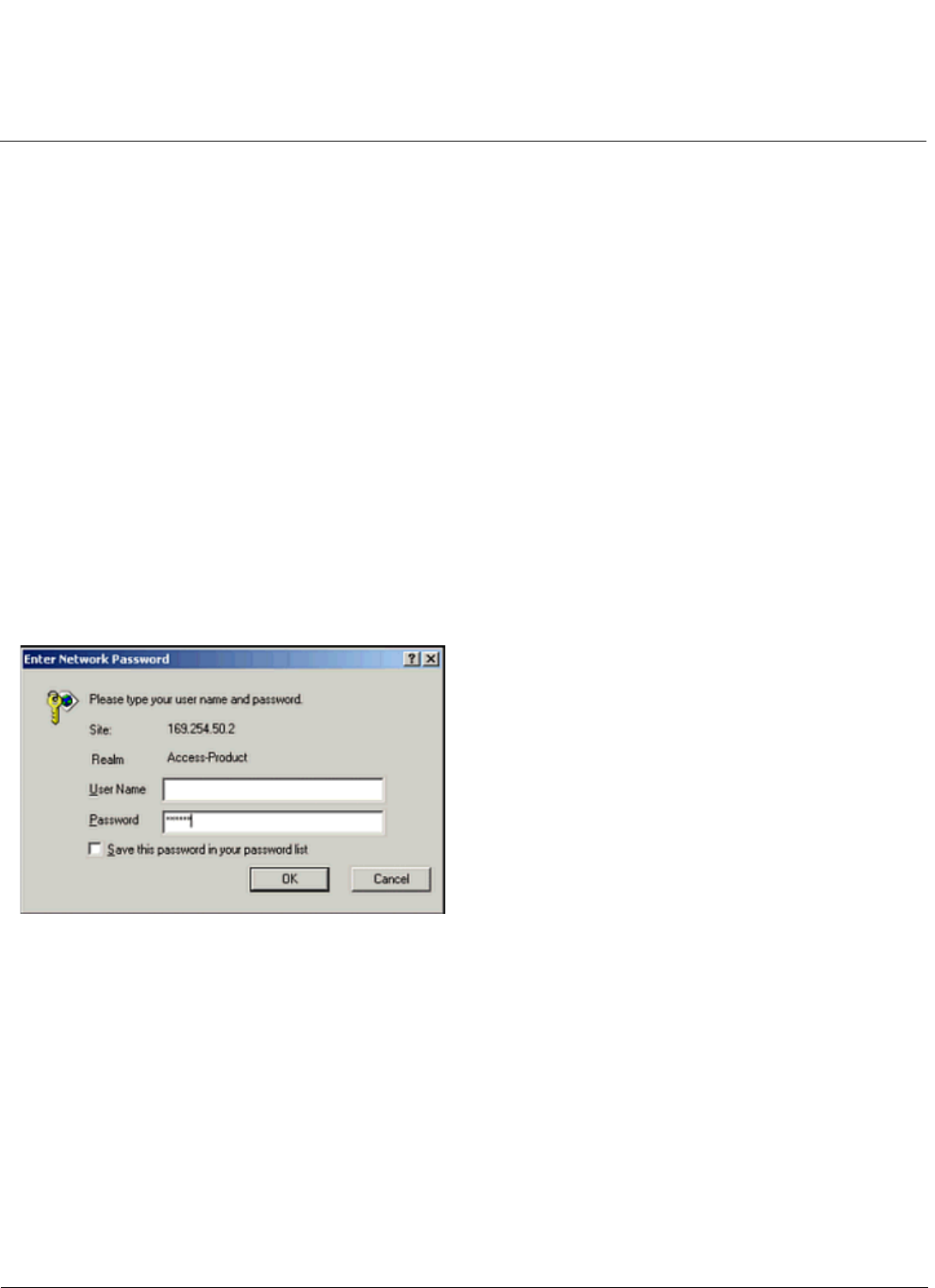
Installation and Initialization AP-700 User Guide
Initialization
27
k. Click the Change button to return to the Change screen.
l. Click the Web Configuration button at the bottom of the Change screen.
m. Proceed to the Logging In section for information on how to access the HTTP interface using this IP address.
Logging In
Once the AP has a valid IP Address and an Ethernet connection, you may use your web browser to monitor and
configure the AP. (To configure and monitor using the command line interface, see Command Line Interface (CLI).)
1. Open a Web browser on a network computer.
2. If necessary, disable the browser’s Internet proxy settings. For Internet Explorer users, follow these steps:
–Select Tools > Internet Options.
– Click the Connections tab.
– Click LAN Settings.
– If necessary, remove the check mark from the Use a proxy server box.
– Click OK twice to save your changes and return to Internet Explorer.
3. Enter the Access Point’s IP address in the browser’s Address field and press Enter or Go.
This is either the dynamic IP address assigned by a network DHCP server or the static IP address you manually
configured. See Using ScanTool for information on how to determine the unit’s IP address and manually configure a
new IP address, if necessary.
The Enter Network Password screen appears.
Figure 2-12 Enter Network Password
4. Enter the HTTP password in the Password field. Leave the User Name field blank. For new units, the default HTTP
password is public.
If you are logging on for the first time the Setup Wizard will launch automatically.
NOTE: Setup Wizard will not relaunch on subsequent logins. To force the Setup Wizard to launch upon login, click
Management > Services and choose Enable from the Setup Wizard drop down menu.
5. To configure the AP using the Setup Wizard, see Using the Setup Wizard; to configure the AP without using the Setup
Wizard, click Exit. Upon clicking Exit, the System Status screen will appear.
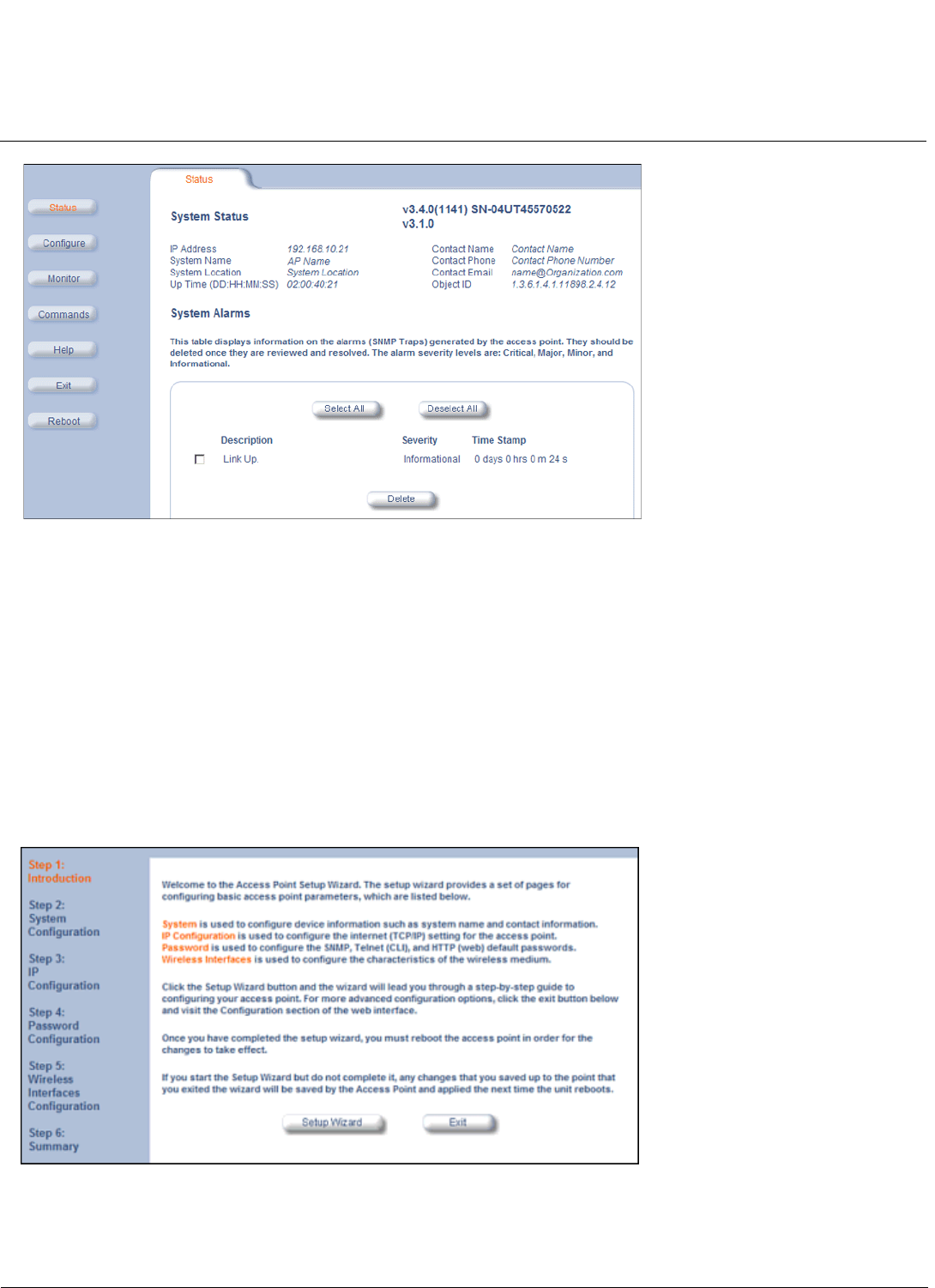
Installation and Initialization AP-700 User Guide
Initialization
28
Figure 2-13 System Status Screen
The buttons on the left of the screen provide access to the monitoring and configuration options for the AP. See
Advanced Configuration to begin configuring the AP manually.
You can also exit the Web interface or reboot the AP using these buttons.
The Command Line Interface (CLI) also provides a method for monitoring and configuring the AP using Telnet or a
serial connection. For more information about monitoring and configuring the AP with the CLI, see Command Line
Interface (CLI).
Using the Setup Wizard
The first time you connect to an AP’s HTTP interface, the Setup Wizard launches automatically. The Setup Wizard
provides step-by-step instructions for how to configure the Access Point’s basic operating parameters, such as Network
Name, IP parameters, system parameters, and management passwords.
Figure 2-14 Setup Wizard
Setup Wizard Instructions
1. Click Setup Wizard to begin. The Setup Wizard supports the following navigation options:

Installation and Initialization AP-700 User Guide
Initialization
29
•Save & Next Button: Each Setup Wizard screen has a Save & Next button. Click this button to submit any
changes you made to the unit’s parameters and continue to the next page. The instructions below describe how to
navigate the Setup Wizard using the Save & Next buttons.
•Navigation Panel: The Setup Wizard provides a navigation panel on the left-hand side of the screen. Click the
link that corresponds to the parameters you want to configure to be taken to that particular configuration screen.
Note that clicking a link in the navigation panel will not submit any changes you made to the unit’s configuration on
the current page.
•Exit: To exit from the Setup Wizard at any time, click Step 1: Introduction on the navigation panel, and then click
the Exit button.
CAUTION: If you exit from the Setup Wizard, any changes you submitted (by clicking the Save & Next button) up
to that point will be saved to the unit but will not take effect until it is rebooted.
2. Configure the System Configuration settings and click Save & Next. See System for more information.
NOTE: On APs with model numbers ending in -WD, you must select the operating country on this page or on the
Configure > System tab. Setting the country makes the AP automatically compliant with the rules of the
regulatory domain in which it is used by configuring the allowed frequency bands, channels, Dynamic
Frequency Selection status, Transmit Power Control status, and power levels. If the country is not selected, an
informational message will appear on the Status page, and you will be unable to configure interface
parameters.
3. Configure the Access Point’s IP Configuration, including basic IP address settings, if necessary, and click Save &
Next. See Basic IP Parameters for more information.
4. On the Password Configuration screen, assign the AP new passwords to prevent unauthorized access and click
Save & Next. Each management interface has its own password:
• SNMP Read Password
• SNMP Read-Write Password
• CLI Password
• HTTP (Web) Password
By default, each of these passwords is set to “public”. See Passwords for more information.
5. Configure the basic Wireless Interface Configuration settings:
• Select the Operational Mode as follows and click Save & Next:
The Wireless (802.11a/b/g) interface can be configured to operate in the following modes:
•802.11a only mode: The radio uses the 802.11a standard only.
•802.11b mode only: The radio uses the 802.11b standard only.
•802.11g mode only: The radio is optimized to communicate with 802.11g devices. This setting will provide the
best results if this radio interface will only communicate with 802.11g devices.
•802.11b/g mode: This is the default mode. Use this mode if you want to support a mix of 802.11b and 802.11g
devices.
•802.11g-wifi mode: The 802.11g-wifi mode has been defined for Wi-Fi testing purposes. It is not
recommended for use in your wireless network environment.
NOTE: In countries in which 802.11a (5 GHz) is not available for use, the AP-700 provides dual-band (802.11b
and 802.11g) support only. 802.11a functionality covered in this User Guide is not supported.
In general, you should use either 802.11g only mode (if you want to support 802.11g devices only) or 802.11b/g
mode to support a mix of 802.11b and 802.11g devices.
• Configure the following available options and click Save & Next:

Installation and Initialization AP-700 User Guide
Initialization
30
—Primary Network Name (SSID): Enter a Network Name (between 1 and 32 characters long) for the wireless
network. You must configure each wireless client to use this name as well. Note that the unit supports up to 16
SSIDs/VLANs. Please see the Advanced Configuration chapter for information on the detailed rules on
configuring multiple SSIDs, VLANs, and security profiles.
NOTE: Do not use quotation marks (single or double) in the Network Name; this will cause the AP to
misinterpret the name.
—Auto Channel Select: By default, the AP scans the area for other Access Points and selects the best
available communication channel, either a free channel (if available) or the channel with the least amount of
interference. Remove the check mark to disable this option. See Dynamic Frequency Selection/Radar
Detection (DFS/RD) for information and Available Channels for a list of available channels.
—Frequency Channel: When Auto Channel Select is enabled, this field is read-only and displays the Access
Point’s current operating channel. When Auto Channel Select is disabled, you can specify the Access Point’s
channel. If you decide to manually set the unit’s channel, ensure that nearby devices do not use the same
frequency. Available Channels vary based on regulatory domain. See Dynamic Frequency Selection/Radar
Detection (DFS/RD) for information and Available Channels for a list of available channels.
—Transmit Rate: Use the drop-down menu to select a specific transmit rate for the AP. The values depend on
the Operational mode. Auto Fallback is the default setting; it allows the AP unit to select the best transmit rate
based on the cell size.
• For 802.11a only -- Auto Fallback, 6, 9, 12, 18, 24, 36, 48, 54 Mbits/s.
NOTE: In countries in which 802.11a (5 GHz) is not available for use, the AP-700 provides dual-band
(802.11b and 802.11g) support only. 802.11a functionality covered in this User Guide is not
supported.
• For 802.11b only -- Auto Fallback, 1, 2, 5.5, 11 Mbits/sec.
• For 802.11g only -- Auto Fallback, 6, 9, 12, 18, 24, 36, 48, 54 Mbits/sec
• For 802.11b/g -- Auto Fallback, 1, 2, 5.5, 6, 9, 11, 12, 18, 24, 36, 48, 54 Mbits/sec
• For 802.11g-wifi -- Auto Fallback, 1, 2, 5.5, 6, 9, 11, 12, 18, 24, 36, 48, 54 Mbits/sec
NOTE: 802.11g-wifi has been defined for Wi-Fi testing purposes. It is not recommended for use in your
wireless network environment.
Additional advanced settings are available on the Interfaces tab.
Also see Security Profile for a description of security features, Management VLAN for a description of VLAN
capabilities, and Configuring Security Profiles for detailed security configuration procedures.
6. Review the configuration Summary. If you want to make any additional changes, use the navigation panel on the
left-hand side of the screen to return to an earlier screen. After making a change, click Save & Next to save the
change and proceed to the next screen.
7. When finished, click Reboot on the Summary screen to restart the AP and apply your changes.
Installing the Software
Proxim periodically releases updated software for the AP on its Web site, http://support.proxim.com. Check the Web site
for the latest updates after you have installed and initialized the unit.
Download the Software
1. In your web browser, go to http://support.proxim.com.
2. If prompted, create an account to gain access.
NOTE: The Knowledgebase is available to all website visitors. First-time users will be asked to create an account to
gain access.
3. Click Search Knowledgebase.
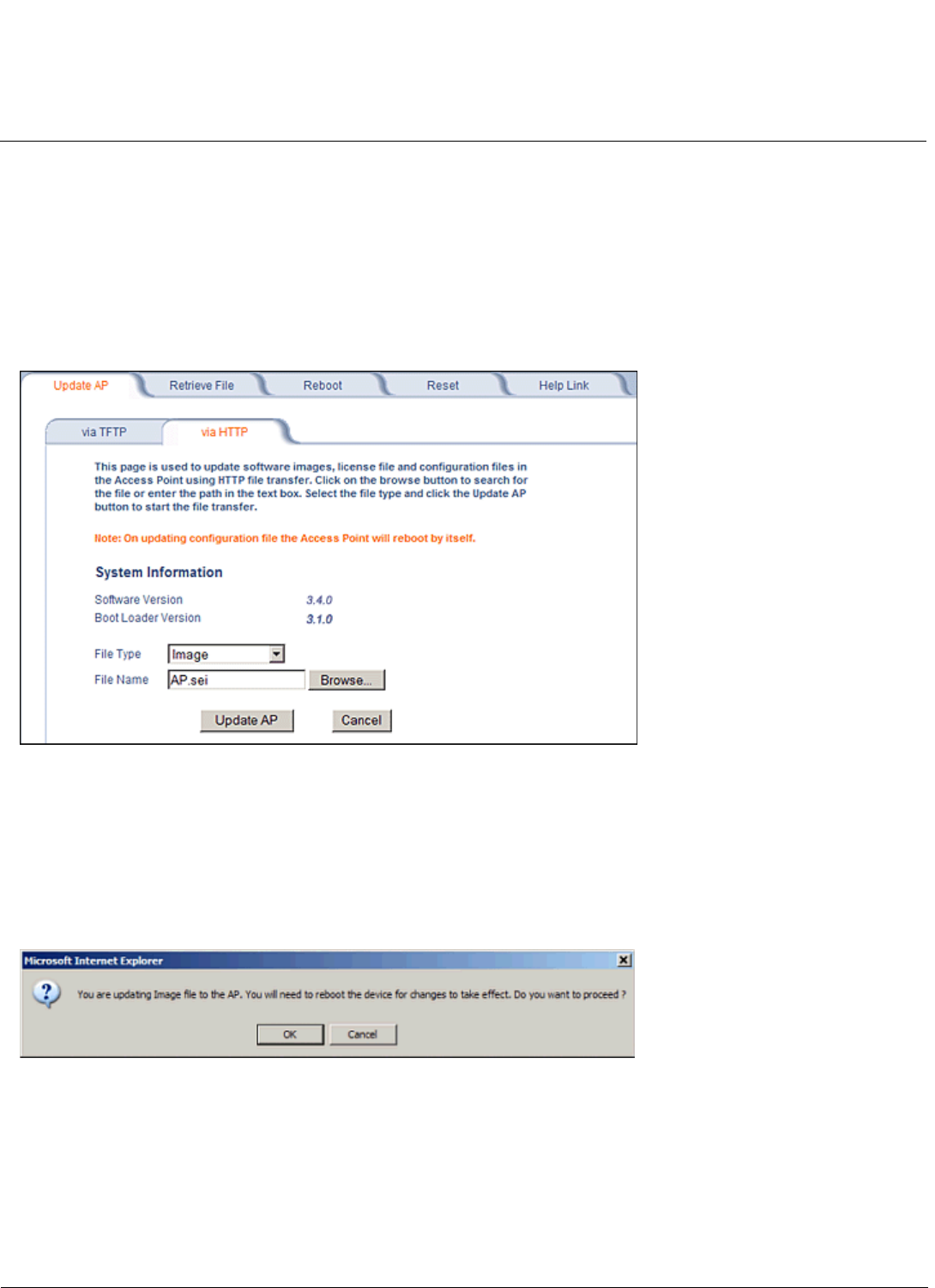
Installation and Initialization AP-700 User Guide
Initialization
31
4. In the Search Knowledgebase field, enter 1686.
5. Click Search.
6. Click on the appropriate link to access the download page.
7. Use the instructions in the following sections to install the new software.
Install Software with HTTP Interface
Use the Update AP via HTTP tab to update the AP with the latest software image.
1. Click Commands > Update AP > via HTTP.
Figure 2-15 Update AP via HTTP Command Screen
2. From the File Type drop-down menu, select Image.
3. Use the Browse button to locate or manually type in the name of the file (including the file extension) you downloaded
from the Proxim Knowledgebase. If typing the file name, you must include the full path and the file extension in the file
name text box.
4. To initiate the HTTP Update operation, click the Update AP button.
A warning message advises you that a reboot of the device will be required for changes to take effect.
Figure 2-16 Warning Message
5. Click OK to continue with the operation or Cancel to abort the operation.
6. If the operation is unsuccessful, you will receive an error message. If this occurs, see the Troubleshooting chapter or
attempt installing the software with a TFTP server, as described in the next section.
If the operation is successful, you will receive a confirmation message.
7. Reboot the AP as follows:
• Click Commands > Reboot.

Installation and Initialization AP-700 User Guide
Initialization
32
• Enter 0 in the Time to Reboot field.
• Click OK.
Install Software with TFTP Server
A Trivial File Transfer Protocol (TFTP) server allows you to transfer files across a network. You can upload files from the
AP for backup or copying, and you can download the files for configuration and AP Image upgrades. The Solarwinds
TFTP server software is located on the AP Installation CD-ROM. You can also download the latest TFTP software from
Solarwind’s Web site at http://www.solarwinds.net. The instructions that follow assume that you are using the Solarwinds
TFTP server software; other TFTP servers may require different configurations.
NOTE: If a TFTP server is not available in the network, you can perform similar file transfer operations using the HTTP
interface.See Update AP via HTTP.
After the TFTP server is installed:
• Check to see that TFTP is configured to point to the directory containing the AP Image.
• Make sure you have the proper TFTP server IP address, the proper AP Image file name, and that the TFTP server is
operational.
• Make sure the TFTP server is configured to both Transmit and Receive files (on the TFTP server’s Security tab), with
no automatic shutdown or time-out (on the Auto Close tab).
The following types of files can be downloaded to the AP from a TFTP server:
• Config (configuration file)
• Image (AP software image or kernel)
• UpgradeBspBl (BSP/Bootloader firmware file)
• SSL Certificate
• SSL Private Key
• SSH Public Key
• SSH Private Key
• CLI Batch File
Install Updates from your TFTP Server using the Web Interface
1. Download the latest software from http://support.proxim.com. See Download the Software for instructions.
2. Copy the latest software updates to your TFTP server.
3. In the Web Interface, click the Commands button and select the Download tab.
4. Enter the IP address of your TFTP server in the field provided.
5. Enter the File Name (including the file extension). If the file is located in the default TFTP directory, you need enter
only the file name. Otherwise, enter the full directory path and file name.
6. Select the File Type from the drop-down menu (use Img for software updates).
7. Select Download & Reboot from the File Operation drop-down menu.
8. Click OK. The Access Point will reboot automatically when the download is complete.
Install Updates from your TFTP Server using the CLI
1. Download the latest software to http://support.proxim.com. See Download the Software for instructions.
2. Copy the latest software updates to your TFTP server.
3. Open the CLI interface via Telnet or a serial connection.
4. Enter the CLI password when prompted.
5. Enter the command: download <tftpaddr> <filename> img
The download will begin, and the image will be downloaded to the Access Point.

Installation and Initialization AP-700 User Guide
Initialization
33
6. When the download is complete, type reboot 0 and press Enter.
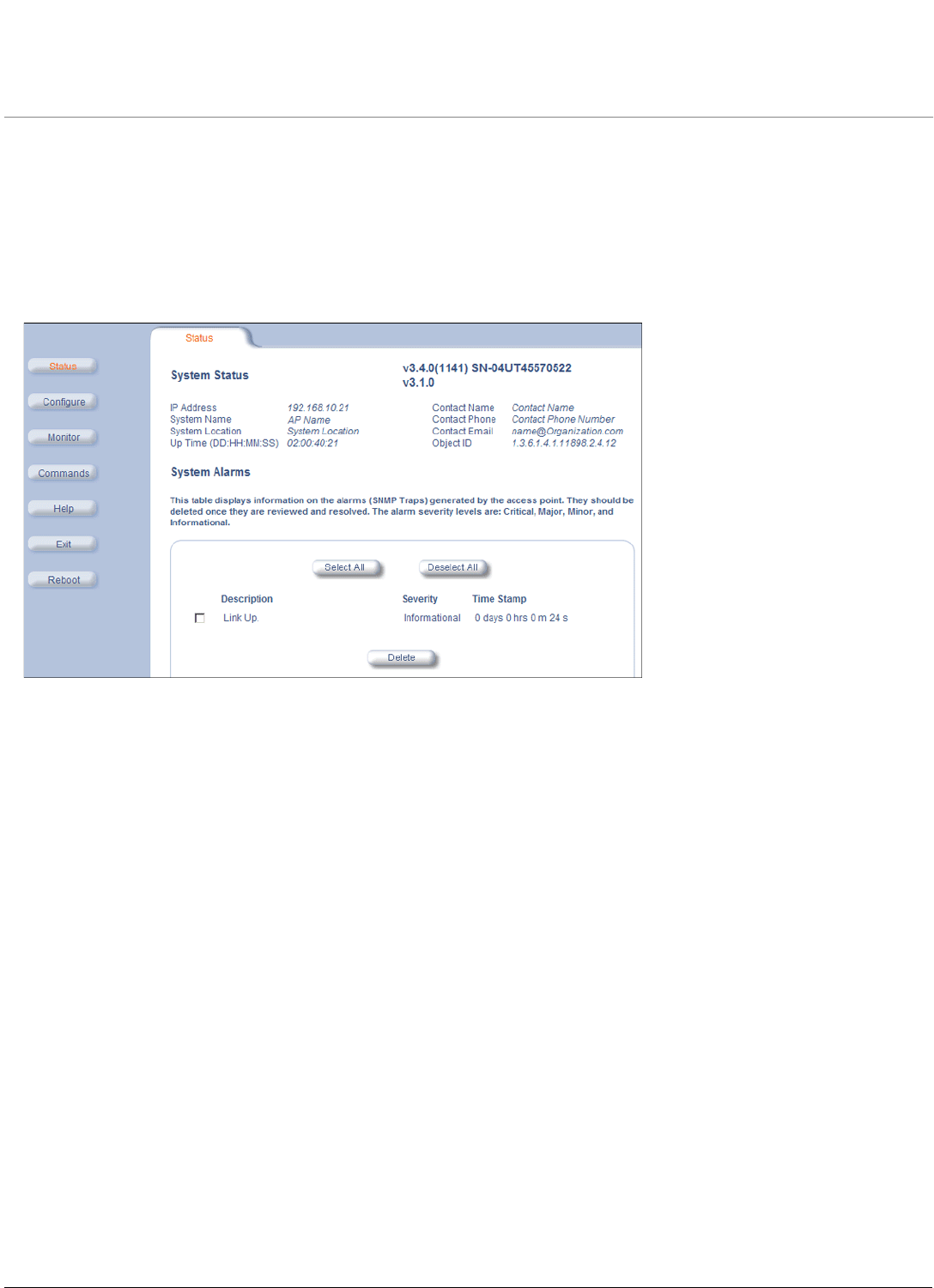
34
AP-700 User Guide
3
System Status
The first screen displayed after Logging In is the System Status screen. You can always return to this screen by clicking
the Status button.
Figure 3-1 System Status Screen
The System Status screen provides the following information:
•System Status: This area provides system-level information, including the unit’s IP address and contact information.
See System for information on these settings.
•System Alarms: System traps (if any) appear in this area. Each trap identifies a specific severity level: critical, major,
minor, and informational. See Alarms for a list of possible alarms.
NOTE: On APs with model numbers ending in -WD, an operating Country must be selected (during the Setup Wizard
or on the Configure > System tab). If a country has not been selected, an informational message will appear
in the System Alarms list, and you will be unable to configure interface parameters.
From this screen, you can also access the AP’s monitoring and configuration options by clicking on the buttons on the
left of the screen.

35
AP-700 User Guide
4
Advanced Configuration
This chapter contains information on configuring settings in the following categories:
•System: Configure specific system information such as system name and contact information.
•Network: Configure IP, DNS client, DHCP server, DHCP Relay Agent, DHCP Relay Servers, Link Integrity, and SNTP
settings.
•Interfaces: Configure the Access Point’s interfaces: Wireless and Ethernet. Configure the Channel Blacklist Table and
a Wireless Distribution System (WDS).
•Management: Configure the Access Point’s management Passwords, IP Access Table, and Services such as
configuring secure or restricted access to the AP via SNMPv3, HTTPS, or CLI. Configure Secure Management, SSL,
Secure Shell (SSH), and RADIUS Based Access Management. Set up Automatic Configuration for Static IP.
•Filtering: Configure Ethernet Protocol filters, Static MAC Address filters, Advanced filters, and Port filters.
•Alarms: Configure the Alarm (SNMP Trap) Groups, the Alarm Host Table, and the Syslog features.
•Bridge: Configure the Spanning Tree Protocol, Storm Threshold protection, Intra BSS traffic, and Packet Forwarding.
•QoS: Configure Wireless Multimedia Enhancements/Quality of Service parameters and QoS policies.
•Radius Profiles: Configure RADIUS features such as RADIUS Access Control and Accounting.
•SSID/VLAN/Security: Configure SSIDs, VLANs, and security profiles. Configure security features such as MAC
Access Control, WPA, 802.11i (WPA2), WEP Encryption, and 802.1x.
To configure the AP using the HTTP/HTTPS interface, you must first log in to a web browser. See Logging In for
instructions.
You may also configure the AP using the command line interface. See Command Line Interface (CLI) for more
information.
To configure the AP via HTTP/HTTPS:
1. Click the Configure button located on the left-hand side of the screen.
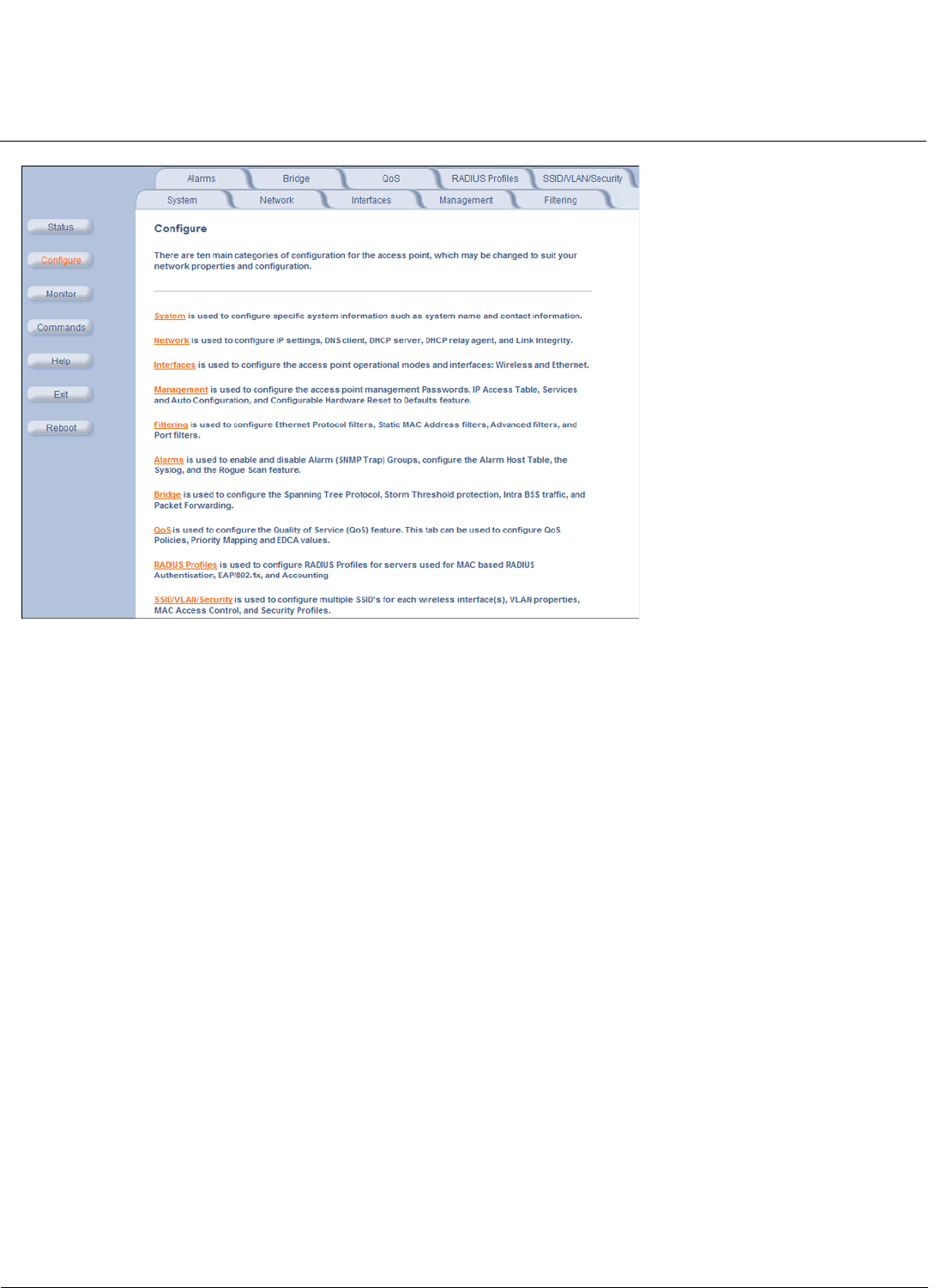
Advanced Configuration AP-700 User Guide
36
Figure 4-1 Configure Main Screen
2. Click the tab that corresponds to the parameter you want to configure. For example, click Network to configure the
Access Point’s TCP/IP settings.
Each Configure tab is described in the remainder of this chapter.

Advanced Configuration AP-700 User Guide
System
37
System
You can configure and view the following parameters within the System Configuration screen:
•Name: The name assigned to the AP. See the Dynamic DNS Support and Access Point System Naming Convention
sections for rules on naming the AP.
•Country: The country in which the AP will be used. Note that some countries have two selectable options (one for
indoor use and one for outdoor use). Setting the country makes the AP automatically compliant with the rules of the
regulatory domain in which it is used by configuring the allowed frequency bands, channels, Dynamic Frequency
Selection status, Transmit Power Control status, and power levels. See Interfaces for more information about these
settings.
NOTE: You must reboot the AP in order for country selection to take effect.
NOTE: Country selection is available only on APs with model numbers ending in -WD. If country selection is available,
however, it must be set before any interface parameters can be configured.
•Location: The location where the AP is installed.
•GPS Longitude: The longitude at which the AP is installed. Enter the value in the format required by your network
management system. If using the ProximVision™ Network Management System (recommended), enter the value in
decimals (e.g., 78.4523).
•GPS Latitude: The latitude at which the AP is installed. Enter the value in the format required by your network
management system. If using the ProximVision™ Network Management System (recommended), enter the value in
decimals (e.g., 78.4523).
•GPS Altitude: The altitude at which the AP is installed. Enter the value in the format required by your network
management system. If using the ProximVision™ Network Management System (recommended), enter the value in
decimals (e.g., 78.4523).
•Contact Name: The name of the person responsible for the AP.
•Contact Email: The email address of the person responsible for the AP.
•Contact Phone: The telephone number of the person responsible for the AP.
•Object ID: This is a read-only field that displays the Access Point’s system object identification number; this
information is useful if you are managing the AP using SNMP.
•Ethernet MAC Address: This is a read-only field that displays the unique MAC (Media Access Control) address for
the Access Point’s Ethernet interface. The MAC address is assigned at the factory.
•Descriptor: This is a read-only field that reports the Access Point’s name, serial number, current image software
version, and current bootloader software version.
•Up Time: This is a read-only field that displays how long the Access Point has been running since its last reboot.
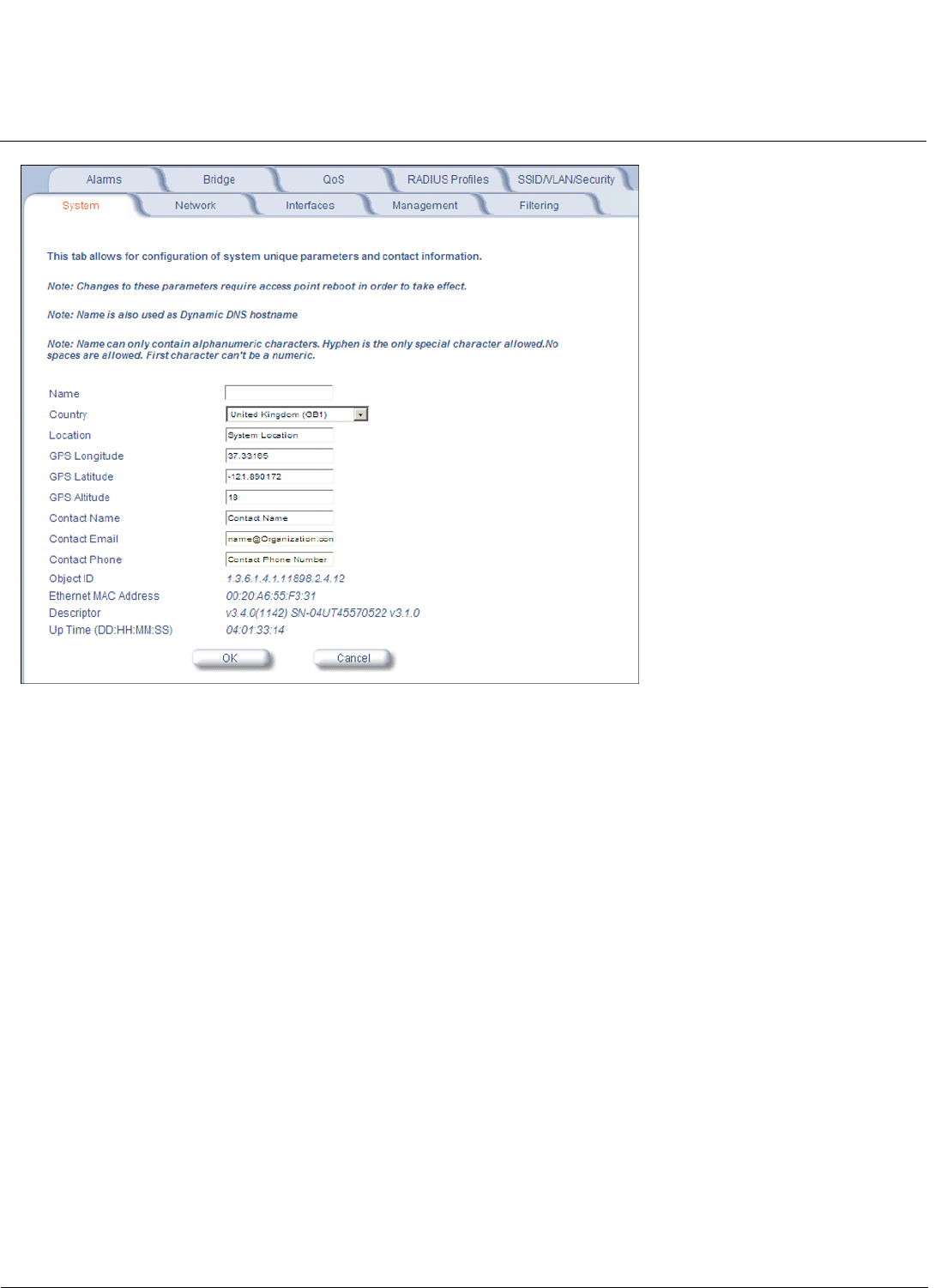
Advanced Configuration AP-700 User Guide
System
38
Figure 4-2 System Tab
Dynamic DNS Support
DNS is a distributed database mapping the user readable names and IP addresses (and more) of every registered
system on the Internet. Dynamic DNS is a lightweight mechanism which allows for modification of the DNS data of host
systems whose IP addresses change dynamically. Dynamic DNS is usually used in conjunction with DHCP for mapping
meaningful names to host systems whose IP addresses change dynamically.
Access Points provide DDNS support by adding the host name (option 12) in DHCP Client messages, which is used by
the DHCP server to dynamically update the DNS server.
Access Point System Naming Convention
The Access Point's system name is used as its host name. In order to prevent Access Points with default configurations
from registering similar host names in DNS, the default system name of the Access Point is uniquely generated. Access
Points generate unique system names by appending the last 3 bytes of the Access Point's MAC address to the default
system name.
The system name must be compliant with the encoding rules for host name as per DNS RFC 1123. According to the
encoding rules, the AP name:
• Can contain alphanumeric or hyphen characters only.
• Can contain up to 31 characters.
• Cannot start or end with a hyphen.
• Cannot start with a digit.
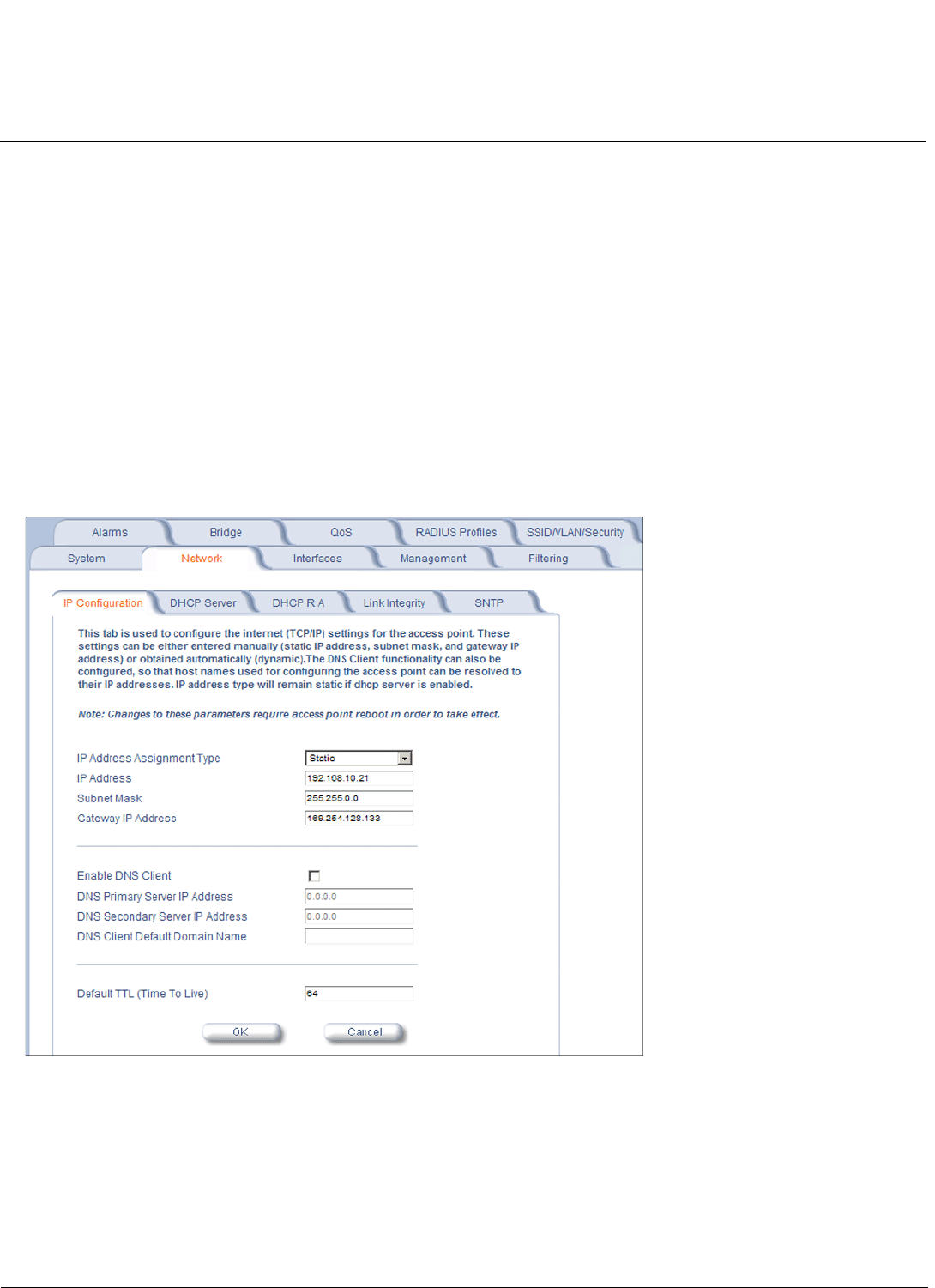
Advanced Configuration AP-700 User Guide
Network
39
Network
The Network tab contains the following sub-tabs:
•IP Configuration
•DHCP Server
•DHCP Relay Agent
•Link Integrity
•SNTP (Simple Network Time Protocol)
IP Configuration
This tab is used to configure the internet (TCP/IP) settings for the access point.
These settings can be either entered manually (static IP address, subnet mask, and gateway IP address) or obtained
automatically (dynamic).The DNS Client functionality can also be configured, so that host names used for configuring the
access point can be resolved to their IP addresses.
Figure 4-3 IP Configuration
You can configure and view the following parameters within the IP Configuration sub-tab:
NOTE: You must reboot the AP in order for any changes to the Basic IP or DNS Client parameters to take effect.

Advanced Configuration AP-700 User Guide
Network
40
Basic IP Parameters
•IP Address Assignment Type: Set this parameter to Dynamic to configure the Access Point as a Dynamic Host
Configuration Protocol (DHCP) client; the Access Point will obtain IP settings from a network DHCP server
automatically during boot-up. If you do not have a DHCP server or if you want to manually configure the Access
Point’s IP settings, set this parameter to Static.
•IP Address: The Access Point’s IP address. When IP Address Assignment Type is set to Dynamic, this field is
read-only and reports the unit’s current IP address. The Access Point will default to 169.254.128.132 if it cannot obtain
an address from a DHCP server.
•Subnet Mask: The Access Point’s subnet mask. When IP Address Assignment Type is set to Dynamic, this field is
read-only and reports the unit’s current subnet mask. The subnet mask will default to 255.255.0.0 if the unit cannot
obtain one from a DHCP server.
•Gateway IP Address: The IP address of the Access Point’s gateway. When IP Address Assignment Type is set to
Dynamic, this field is read-only and reports the IP address of the unit’s gateway. The gateway IP address will default to
169.254.128.133 if the unit cannot obtain an address from a DHCP server.
DNS Client
If you prefer to use host names to identify network servers rather than IP addresses, you can configure the AP to act as a
Domain Name Service (DNS) client. When this feature is enabled, the Access Point contacts the network’s DNS server to
translate a host name to the appropriate network IP address. You can use this DNS Client functionality to identify
RADIUS servers by host name.
•Enable DNS Client: Place a check mark in the box provided to enable DNS client functionality. Note that this option
must be enabled before you can configure the other DNS Client parameters.
•DNS Primary Server IP Address: The IP address of the network’s primary DNS server.
•DNS Secondary Server IP Address: The IP address of a second DNS server on the network. The Access Point will
attempt to contact the secondary server if the primary server is unavailable.
•DNS Client Default Domain Name: The default domain name for the Access Point’s network (for example,
“proxim.com”). Contact your network administrator if you need assistance setting this parameter.
Advanced
•Default TTL (Time to Live): Time to Live (TTL) is a field in an IP packet that specifies the number of hops, or routers
in different locations, that the request can travel before returning a failed attempt message. The Access Point uses the
default TTL for generated packets for which the transport layer protocol does not specify a TTL value. This parameter
supports a range from 0 to 255. By default, TTL is 64.
DHCP Server
If your network does not have a DHCP Server, you can configure the AP as a DHCP server to assign dynamic IP
addresses to Ethernet nodes and wireless clients.
CAUTION: Make sure there are no other DHCP servers on the network and do not enable the DHCP server without
checking with your network administrator first, as it could disrupt normal network operation. Also, the AP
must be configured with a static IP address before enabling this feature.
When the DHCP Server functionality is enabled, you can create one or more IP address pools from which to assign
addresses to network devices.
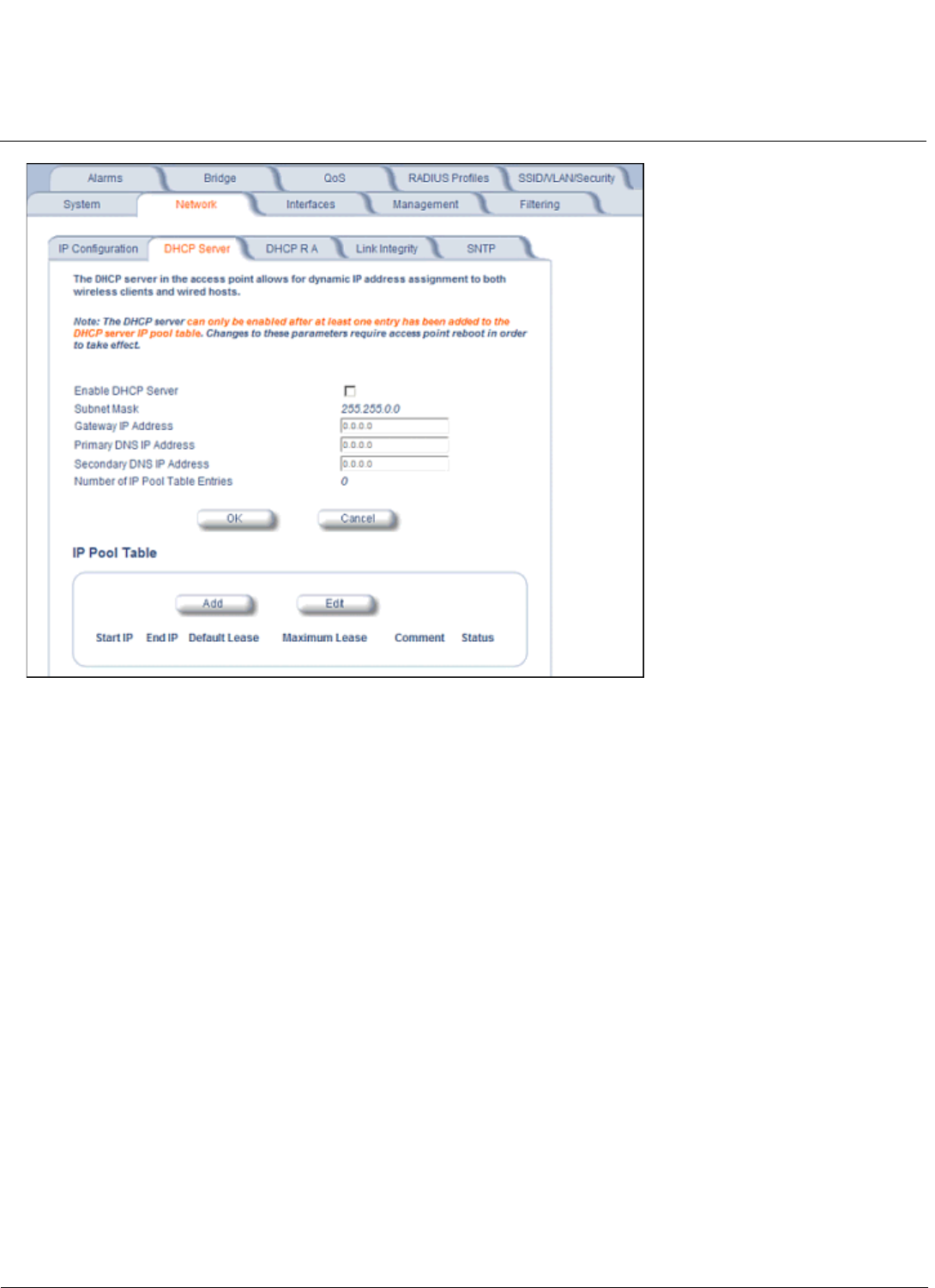
Advanced Configuration AP-700 User Guide
Network
41
Figure 4-4 DHCP Server Configuration Screen
You can configure and view the following parameters within the DHCP Server Configuration screen:
NOTE: You must reboot the AP before changes to any of these DHCP server parameters take effect.
•Enable DHCP Server: Place a check mark in the box provided to enable DHCP Server functionality.
NOTE: You cannot enable the DHCP Server functionality unless there is at least one IP Pool Table Entry configured.
•Subnet Mask: This field is read-only and reports the Access Point’s current subnet mask. DHCP clients that receive
dynamic addresses from the AP will be assigned this same subnet mask.
•Gateway IP Address: The AP will assign the specified address to its DHCP clients.
•Primary DNS IP Address: The AP will assign the specified address to its DHCP clients.
•Secondary DNS IP Address: The AP will assign the specified address to its DHCP clients.
•Number of IP Pool Table Entries: This is a read-only field that reports the number of entries in the IP Pool Table.
•IP Pool Table Entry: This entry specifies a range of IP addresses that the AP can assign to its wireless clients. Click
Add to create a new entry. Click Edit to change an existing entry. Each entry contains the following fields:
– Start IP Address: The first IP address in the pool. IP addresses must be within the same subnet as the AP.
– End IP Address: The last IP address in the pool. IP addresses must be within the same subnet as the AP.
–Default Lease Time (optional): The default time value for clients to retain the assigned IP address. DHCP
automatically renews IP Addresses without client notification. This parameter supports a range between 3600 and
86400 seconds. The default is 86400 seconds. If this field is left blank, the default (86400) is used.
–Maximum Lease Time (optional): The maximum time value for clients to retain the assigned IP address. DHCP
automatically renews IP Addresses without client notification. This parameter supports a range between 3600 and
86400 seconds. The default is 86400 seconds. If this field is left blank, the default (86400) is used.
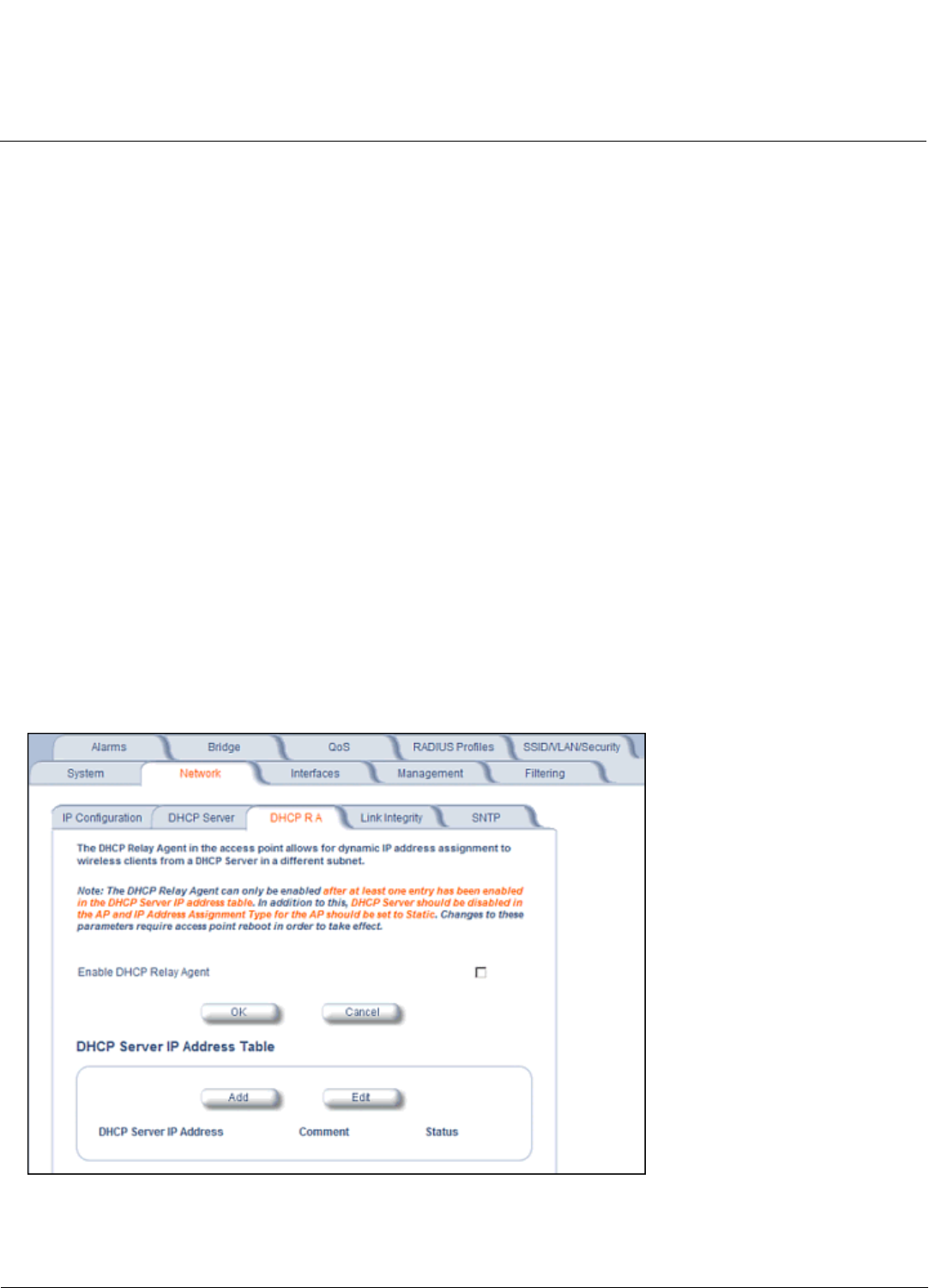
Advanced Configuration AP-700 User Guide
Network
42
NOTE: The Default Lease Time cannot be larger than the Maximum Lease Time. If you set the Maximum Lease
Time, you should also set the Default Lease Time to ensure that the Default Lease Time is less than the
Maximum.
–Comment (optional)
–Status: IP Pools are enabled upon entry in the table. You can also disable or delete entries by changing this field’s
value.
NOTE: You must reboot the AP before changes to any of these DHCP server parameters take effect.
DHCP Relay Agent
When enabled, the DHCP relay agent forwards DHCP requests to the set DHCP server.
Click the Configure > Network > DHCP R A to configure DHCP relay agent servers and enable the DHCP relay agent.
NOTE: At least one DHCP server must be enabled before DHCP Relay Agent can be enabled.
NOTE: If the DHCP relay agent is unable to reach the external DHCP Server specified in the DHCP Server IP Address
Table, the requesting client will receive an IP address from the IP Pool table of the AP’s internal DHCP Server,
even if the internal DHCP Server is disabled.
NOTE: If a client requests an available IP address from the IP Pool table of the AP’s internal DHPC Server, the client will
receive this address, even if the DHCP server on the AP is disabled. To ensure that clients receive IP addresses
only from the DHCP Relay Agent, disable all entries in the IP Pool table of the AP’s internal DHCP server.
The DHCP Relay functionality of the AP supports Option 82 and sends the system name of the AP (as a NAS identifier)
as a sub-option of Option 82.
The AP makes a DHCP Request for lease renewal five minutes ahead of the expiration of the Rebinding time as
specified in the DHCP Offer from the DHCP server obtained during the last renewal.
Figure 4-5 DHCP Relay Agent
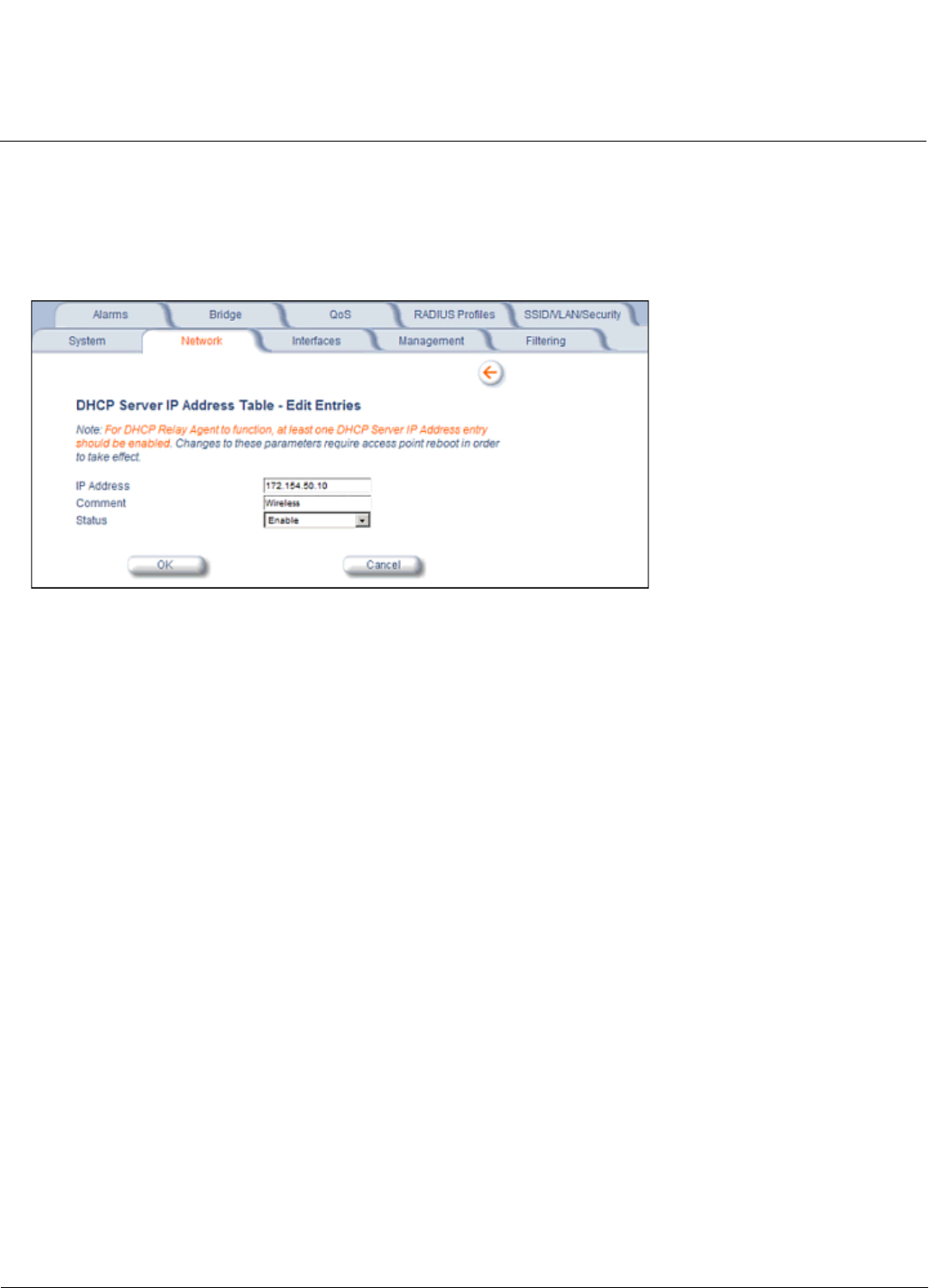
Advanced Configuration AP-700 User Guide
Network
43
DHCP Server IP Address Table
The AP supports the configuration of a maximum of 10 server settings in the DHCP Relay Agents server table. At least
one server must be configured to enable DHCP Relay.
To add entries to the table of DHCP Relay Agents, click Add in the DHCP Server IP Address Table; to edit existing
entries, click Edit. The following window is displayed.
Figure 4-6 DHCP Server IP Address Table - Edit Entries
To add an entry, enter the IP Address of the DHCP Server and a comment (optional), and click OK.
To edit an entry, make changes to the appropriate entry. Enable or disable the entry by choosing Enable or Disable from
the Status drop-down menu, and click OK.
Link Integrity
The Link Integrity feature checks the link between the AP and any nodes on the backbone. These nodes are listed by IP
address in the Link Integrity IP Address Table. The AP periodically pings the nodes listed within the table. If the AP loses
network connectivity (that is, the ping attempts fail), the AP disables its wireless interface(s). Note that this feature does
not affect WDS links (if WDS links are configured and enabled).
You can configure and view the following parameters within the Link Integrity Configuration screen:
•Enable Link Integrity: Place a check mark in the box provided to enable Link Integrity.
•Poll Interval (milliseconds): The interval between link integrity checks. Range is 500-15000 ms in increments of
500 ms; default is 500 ms.
•Poll Retransmissions: The number of times a poll should be retransmitted before the link is considered down.
Range is 0 to 255; default is 5.
•Target IP Address Entry: This entry specifies the IP address of a host on the network that the AP will periodically poll
to confirm connectivity. The table can hold up to five entries. By default, all five entries are set to 0.0.0.0. Click Edit to
update one or more entries. Each entry contains the following field:
– Target IP Address
– Comment (optional)
–Status: Set this field to Enable to specify that the Access Point should poll this device. You can also disable an
entry by changing this field’s value to Disable.
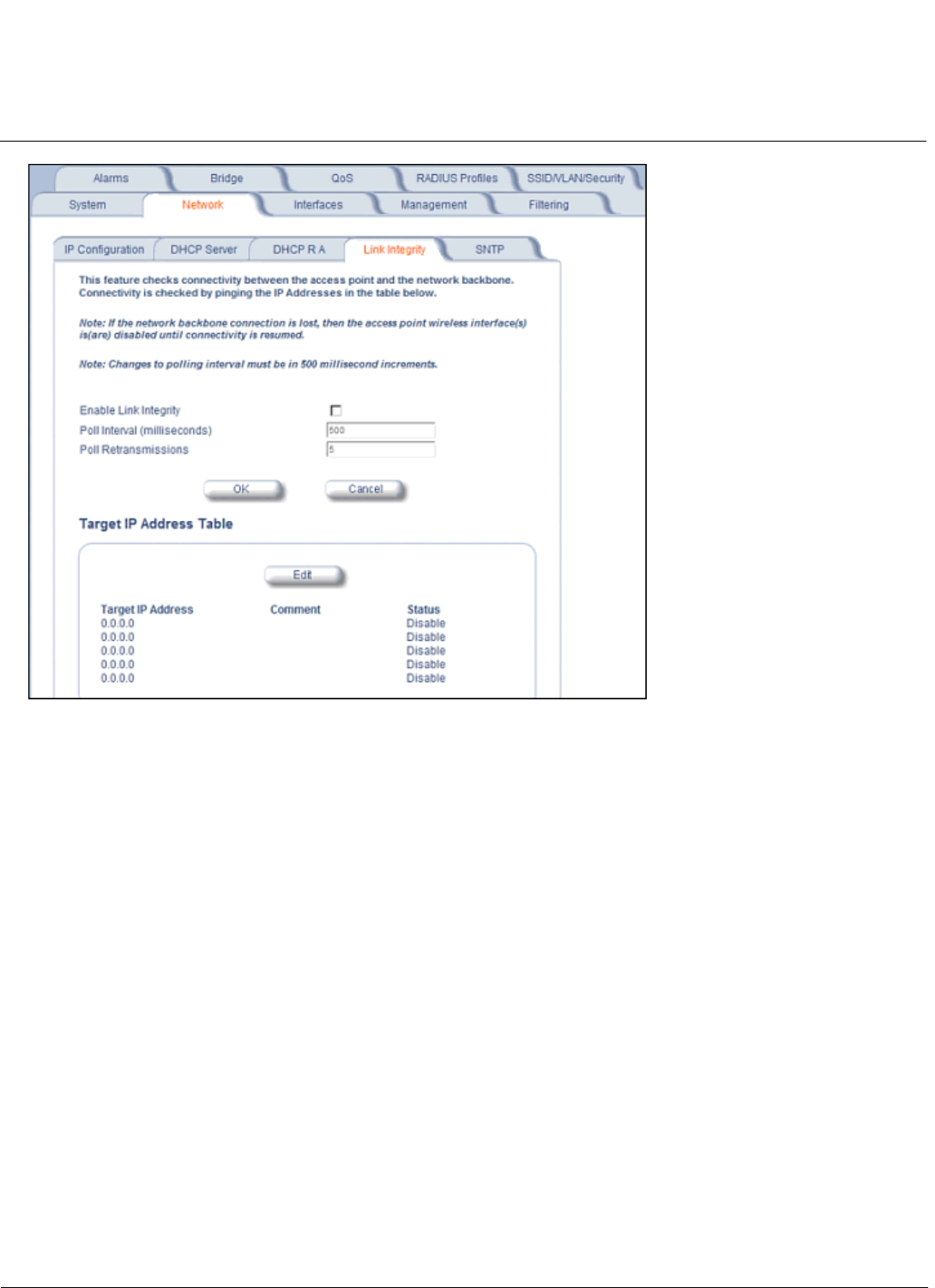
Advanced Configuration AP-700 User Guide
Network
44
Figure 4-7 Link Integrity Configuration Screen
SNTP (Simple Network Time Protocol)
SNTP allows a network entity to communicate with time servers in the network/internet to retrieve and synchronize time
of day information. When this feature is enabled, the AP will attempt to retrieve the time of day information from the
configured time servers (primary or secondary), and, if successful, will update the relevant time objects in the AP.
Requests are sent every 10 seconds. If the AP fails to retrieve the information after three attempts, the AP will use the
system uptime and update the relevant time objects. If this feature is disabled, the user can manually configure the date
and time parameters.
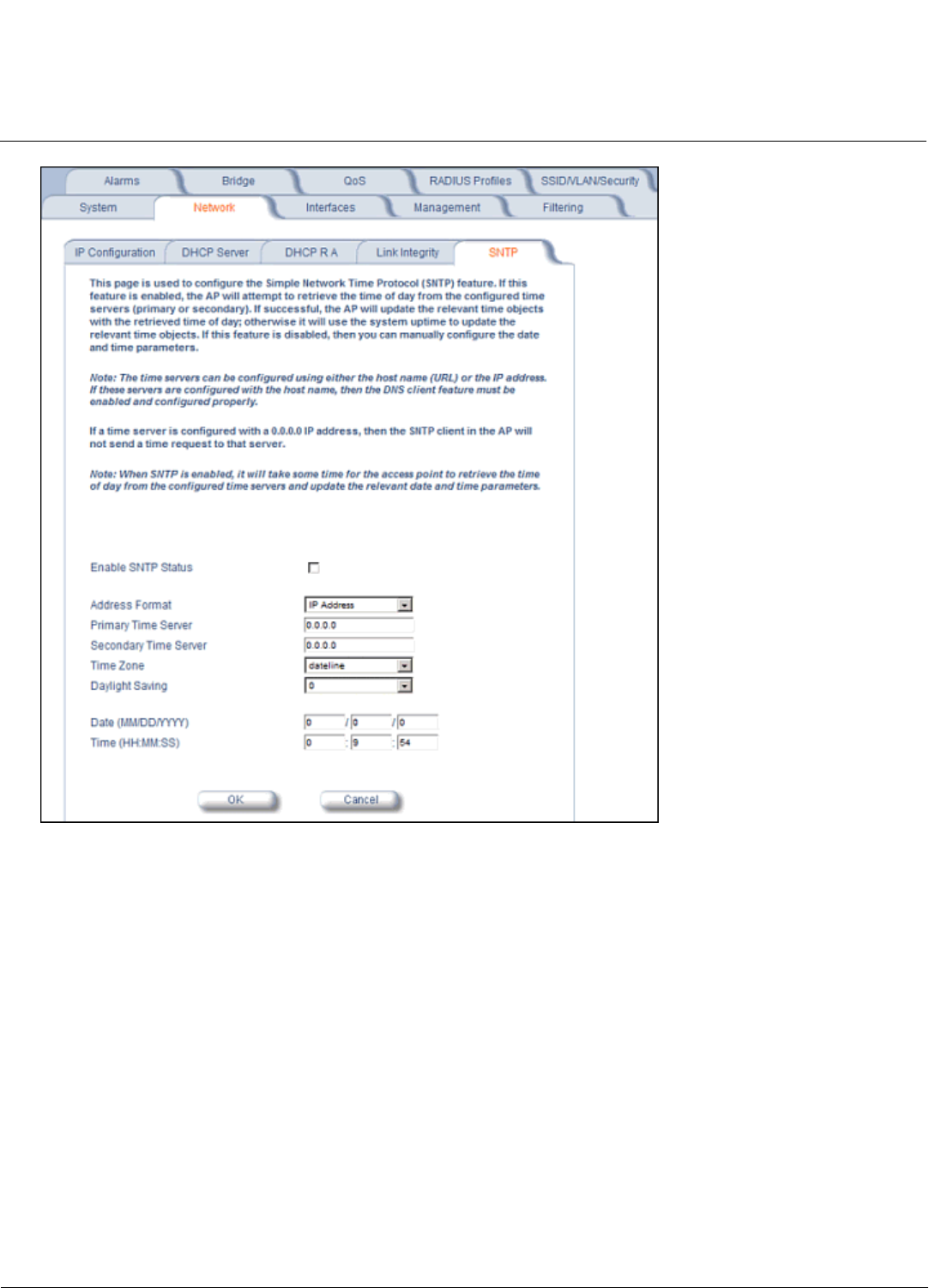
Advanced Configuration AP-700 User Guide
Network
45
Figure 4-8 SNTP Configuration Screen
You can configure and view the following parameters within the SNTP screen:
•SNTP Status: Select Enable or Disable from the drop-down menu. The selected status will determine which of the
parameters on the SNTP screen are configurable.
NOTE: When SNTP is enabled, it will take some time for the AP to retrieve the time of day from the configured time
servers and update the relevant date and time parameters.
•Addressing Format: If SNTP is enabled, choose whether you will use the host name or the IP address to configure
the primary/secondary SNTP servers. If these servers are configured with the host name, the DNS client feature must
be enabled and configured properly.
•Primary Server Name or IP Address: If SNTP is enabled, enter the host name or IP address of the primary SNTP
server.
•Secondary Server Name or IP Address: If SNTP is enabled, enter the host name or IP address of the secondary
SNTP server.
•Time Zone: Select the appropriate time zone from the drop down menu.
•Daylight Savings Time: Select the number of hours to adjust for daylight savings time.
•Time and Date Information: When SNTP is disabled, the following time-relevant objects are manually configurable.
When SNTP is enabled, these objects are grayed out:

Advanced Configuration AP-700 User Guide
Network
46
– Year: Enter the current year.
– Month: Enter the month in digits (1-12).
– Day: Enter the day in digits (1-31).
– Hour: Enter the hour in digits (0-23).
– Minutes: Enter the minutes in digits (0-59).
– Seconds: Enter the seconds in digits (0-59).
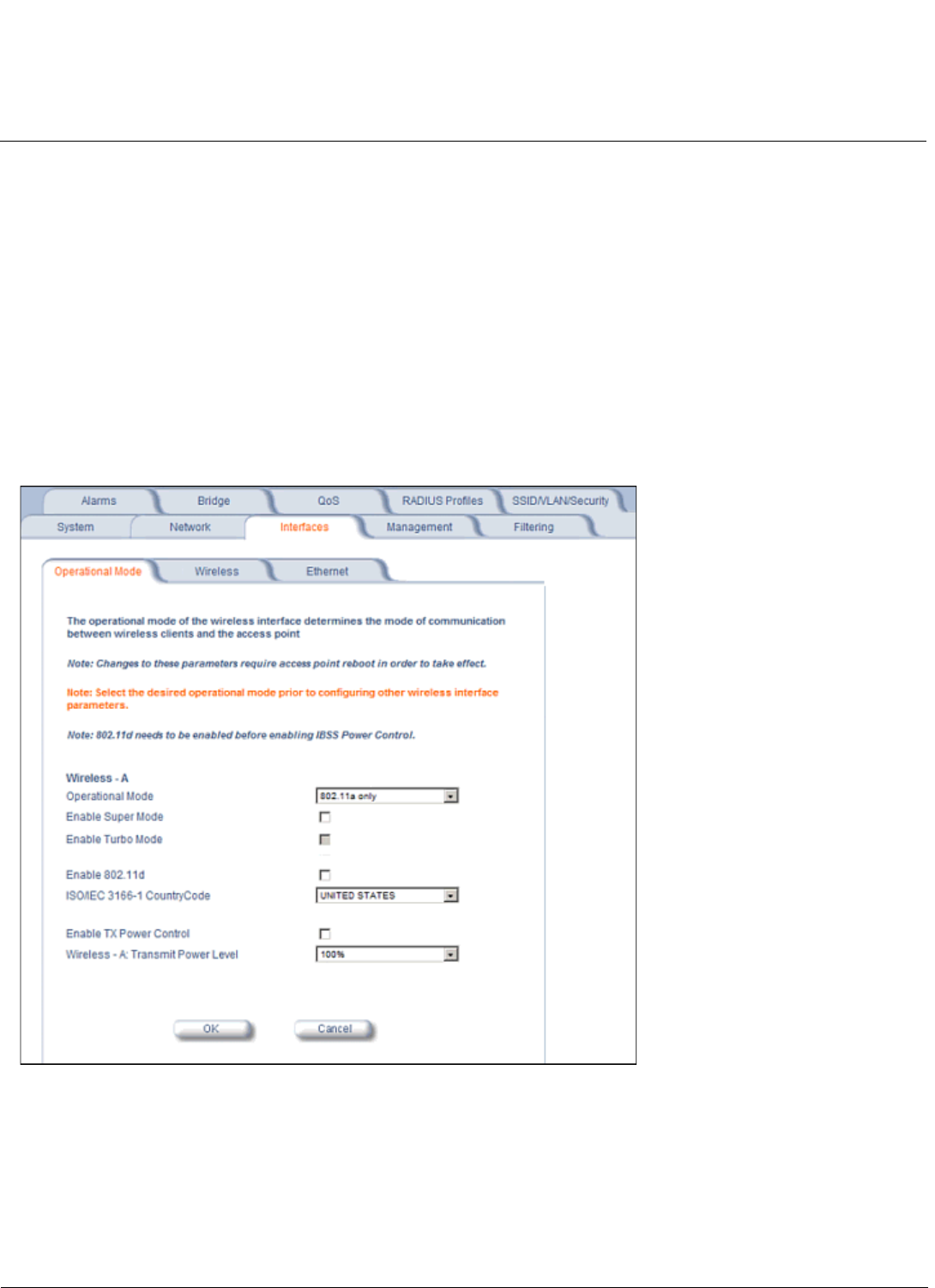
Advanced Configuration AP-700 User Guide
Interfaces
47
Interfaces
From the Interfaces tab, you configure the Access Point’s operational mode settings, power control settings, wireless
interface settings and Ethernet settings. You may also configure a Wireless Distribution System for AP-to-AP
communications. The Interfaces tab contains the following sub-tabs:
•Operational Mode
•Wireless A (802.11a/b/g Radio)
•Ethernet
NOTE: On APs with model numbers ending in -WD, the operating country must be selected on the System tab before
any of these sub-tabs are available.
Operational Mode
From this tab, you can configure and view the operational mode for the Wireless interface.
Figure 4-9 Operational Mode Screen
The Wireless (802.11a/b/g) interface can be configured to operate in the following modes:
•802.11a only mode: The radio uses the 802.11a standard only.
•802.11b mode only: The radio uses the 802.11b standard only.
•802.11g mode only: The radio is optimized to communicate with 802.11g devices. This setting will provide the best
results if this radio interface will only communicate with 802.11g devices.

Advanced Configuration AP-700 User Guide
Interfaces
48
•802.11b/g mode: This is the default mode. Use this mode if you want to support a mix of 802.11b and 802.11g
devices.
•802.11g-wifi mode: The 802.11g-wifi mode has been defined for Wi-Fi testing purposes. It is not recommended for
use in your wireless network environment.
NOTE: In countries in which 802.11a (5 GHz) is not available for use, the AP-700 provides dual-band (802.11b and
802.11g) support only. 802.11a functionality covered in this User Guide is not supported.
Enable H Band Support
In compliance with FCC regulations, Dynamic Frequency Selection is required in the middle frequency band (M band:
5.25 GHz - 5.25 Ghz) and high frequency band (H band: 5.470 GHz - 5.725 GHz). DFS is enabled automatically when
you use one or both of these frequency bands.
If the AP’s Wireless Card A is variant 2, 3, or 6, the M band channels are enabled by default, and DFS is performed
automatically and cannot be disabled. To add H band channels to the list of available channels, select Enable H Band
Support on the Op Mode page. When the H band is enabled, DFS is enabled automatically, and is performed on both M
and H band channels.
If the AP’s Wireless Card A is variant 8, 10, or 11, both M and H band channels are enabled automatically. DFS is
performed on both M and H band channels and cannot be disabled.
To identify your AP’s software variant, click Monitor > Version to view the Version tab.
For a full discussion of Dynamic Frequency Selection, see Dynamic Frequency Selection/Radar Detection (DFS/RD).
Super Mode and Turbo Mode
Super mode improves throughput between the access point and wireless clients that support this capability. For wireless
clients that support this capability the AP will negotiate and treat them accordingly, for other clients that do not support
super mode, the AP will treat them as normal wireless clients.
Super mode can be configured only when the wireless operational mode is one of the following:
• 802.11a only mode
• 802.11g only mode
• 802.11b/g mode
NOTE: Super mode is not available in 802.11b and 802.11g-wifi operational modes. Turbo mode is available only in
802.11a mode in the FCC regulatory domain. Turbo Mode is not available in frequency bands in which DFS is
required.
Turbo mode is supported in 802.11a mode in the FCC regulatory domain when DFS is not required. Turbo mode supports
turbo speeds at twice the standard data rates, and also dynamically switches between Turbo mode speeds and normal
speeds depending on the wireless client. All connected clients must be using Turbo mode in order for the AP to operate
at Turbo mode speed. If turbo mode is enabled, then this is displayed in the web UI and the transmit speeds and
channels pull-down menus are updated with the valid values.
When Turbo mode is enabled, only a subset of the wireless channels in the 5.0 GHz spectrum can be used. If any
wireless clients do not support turbo mode, the AP will fall back to normal mode.
Turbo mode can be configured only when Super mode has already been enabled.
Super mode is supported in the 2.4 GHz and 5 GHz frequency bands in all regulatory domains. Turbo mode is available
in the 5 GHz frequency band in the FCC regulatory domain when DFS is not required.
IEEE 802.11d Support for Additional Regulatory Domains
The IEEE 802.11d specification allows conforming equipment to operate in more than one regulatory domain over time.
IEEE 802.11d support allows the AP to broadcast its radio’s regulatory domain information in its beacon and probe
responses to clients. This allows clients to passively learn what country they are in and only transmit in the allowable

Advanced Configuration AP-700 User Guide
Interfaces
49
spectrum. When a client enters a regulatory domain, it passively scans to learn at least one valid channel, i.e., a channel
upon which it detects IEEE Standard 802.11 frames.
The beacon frame contains information on the country code, the maximum allowable transmit power, and the channels to
be used for the regulatory domain.
The same information is transmitted in probe response frames in response to a client’s probe requests. Once the client
has acquired the information required to meet the transmit requirements of the regulatory domain, it configures itself for
operation in the regulatory domain.
On some AP models, the regulatory domain and associated parameters are automatically configured when a country is
selected on the System tab. On APs in which country selection is not available on the system tab, the regulatory domain
is pre-programmed into the AP prior to shipment. Depending on the regulatory domain, a default country code is chosen
that is transmitted in the beacon and probe response frames.
Configuring 802.11d Support
Perform the following procedure to enable 802.11d support and select the country code:
1. Click Configure > Interfaces > Operational Mode.
2. Select Enable 802.11d.
3. Select the Country Code from the ISO/IEC 3166-1 CountryCode drop-down menu.
NOTE: On APs with model numbers ending in -WD, this object is not configurable.
4. Click OK.
5. Configure Transmit Power Control and Transmit Power Level if required.
Transmit Power Control/Transmit Power Level
Transmit Power Control uses standard 802.11d frames to control transmit power within an infrastructure BSS (Basic
Service Set, or combination of AP and associated clients that can communicate to each other and/or to the backhaul
connection via the AP). This method of power control is considered to be an interim way of controlling the transmit power
of 802.11d enabled clients in lieu of implementation of 802.11h.
When an AP comes online, it automatically uses the maximum TX power allowed in the regulatory domain. The Transmit
Power Control feature lets the user manually lower the transmit power level by setting a “back-off” value between 0 and
35 dBm.
When Transmit Power Control is enabled, the transmit power level of the card in the AP is set to the maximum transmit
power level minus the back-off value. This power level is advertised in Beacon and Probe Response frames as the
802.11d maximum transmit power level.
When an 802.11d-enabled client learns the regulatory domain related information from Beacon and Probe Response
frames, it learns the power level advertised in Beacon and Probe response frames as the maximum transmit power of the
regulatory domain and configures itself to operate with that power level.
As a result, the transmit power level of the BSS is configured to the power level set in the AP (assuming that the BSS has
only 802.11d enabled clients and an 802.11d enabled AP).
NOTE: In FCC DFS-enabled bands, power control is adjusted from beacon information only.
In addition, ATPC (Automatic Transmit Power Control) is a feature to automatically adapt transmit power when the quality
of the link is more than sufficient to maintain a good communication with reduced transmit power. This feature is required
for FCC DFS. It works by monitoring the quality of the link and reducing the output power of the radio by up to 6 dB when
good link quality can still be achieved. When link quality reduces, the output power is automatically increased up to the
original power level to maintain a good link. For a full discussion of DFS, see Dynamic Frequency Selection/Radar
Detection (DFS/RD).

Advanced Configuration AP-700 User Guide
Interfaces
50
Configuring TX Power Control
1. Click Configure > Interfaces > Operational Mode.
2. Select Enable Transmit Power Control.
3. Enter the desired backoff from the maximum Transmit Power level (between 0 and 35 dBm) in the Wireless-A:
Transmit Power Level Back-Off field.
4. Click OK.
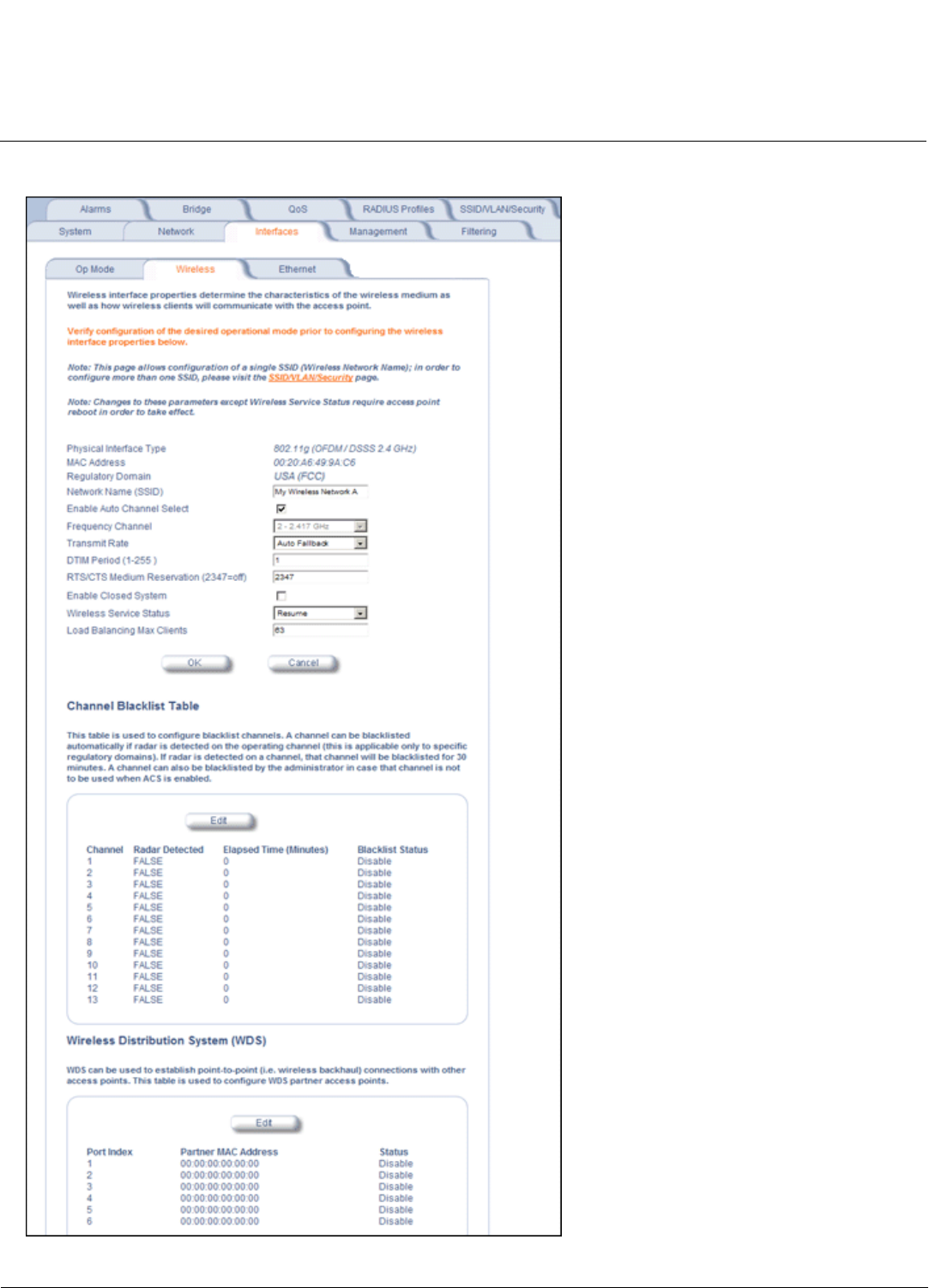
Advanced Configuration AP-700 User Guide
Interfaces
51
Wireless A (802.11a/b/g Radio)
Figure 4-10 Wireless Interface

Advanced Configuration AP-700 User Guide
Interfaces
52
You can view and configure the following parameters for the Wireless interface:
NOTE: You must reboot the Access Point before any changes to these parameters take effect.
•Physical Interface Type: Depending on the Operational Mode, this field reports:
– For 802.11a mode: “802.11a (OFDM 5 GHz).”
NOTE: In countries in which 802.11a (5 GHz) is not available for use, the AP-700 provides dual-band (802.11b
and 802.11g) support only. 802.11a functionality covered in this User Guide is not supported.
– For 802.11b mode only: "802.11b (DSSS 2.4 GHz)"
– For 802.11g mode: "802.11g (OFDM/DSSS 2.4 GHz)"
– For 802.11b/g mode: "802.11g (OFDM/DSSS 2.4 GHz)"
– For 802.11g-wifi mode: "802.11g (OFDM/DSSS 2.4 GHz)"
OFDM stands for Orthogonal Frequency Division Multiplexing; this is the name for the radio technology used by
802.11a/4.9 GHz devices. DSSS stands for Direct Sequence Spread Spectrum; this is the name for the radio
technology used by 802.11b devices.
•MAC Address: This is a read-only field that displays the unique MAC (Media Access Control) address for the Access
Point’s wireless interface. The MAC address is assigned at the factory.
•Regulatory Domain: Reports the regulatory domain for which the AP is certified. Not all features or channels are
available in all countries.
•Network Name (SSID): Enter a Network Name (between 1 and 32 characters long) for the primary wireless network.
You must configure each wireless client using this network to use this name as well. Additional SSIDs and VLANs may
be configured under Configure > SSID/VLAN/Security. Up to 16 SSID/VLANs may be configured.
NOTE: Do not use quotation marks (single or double) in the Network Name; this will cause the AP to misinterpret the
name.
•Enable Auto Channel Select: When the Enable Auto Channel Select option is enabled, the AP scans the area for
other Access Points and selects a free or relatively unused communication channel. This helps prevent interference
problems and increases network performance. By default this feature is enabled. See Dynamic Frequency
Selection/Radar Detection (DFS/RD) for more information and Available Channels for a list of available channels.
•Frequency Channel: When Auto Channel Select is enabled, this field is read-only and displays the Access Point’s
current operating Channel. When Auto Channel Select is disabled, you can specify the Access Point’s operating
channel. If you decide to manually set the unit’s Channel, ensure that nearby devices do not use the same frequency
(unless you are setting up WDS links). Available channels vary based on regulatory domain. See Dynamic Frequency
Selection/Radar Detection (DFS/RD) for more information and Available Channels for a list of available channels.
•Transmit Rate: Use the drop-down menu to select a specific transmit rate for the AP. The values depend on the
Operational mode. Auto Fallback is the default setting; it allows the AP unit to select the best transmit rate based on
the cell size.
– For 802.11a only -- Auto Fallback, 6, 9, 12, 18, 24, 36, 48, 54 Mbits/s.
NOTE: In countries in which 802.11a (5 GHz) is not available for use, the AP-700 provides dual-band (802.11b
and 802.11g) support only. 802.11a functionality covered in this User Guide is not supported.
– For 802.11b only -- Auto Fallback, 1, 2, 5.5, 11 Mbits/sec.
– For 802.11g only -- Auto Fallback, 6, 9, 12, 18, 24, 36, 48, 54 Mbits/sec
– For 802.11b/g -- Auto Fallback, 1, 2, 5.5, 6, 9, 11, 12, 18, 24, 36, 48, 54 Mbits/sec
– For 802.11g-wifi -- Auto Fallback, 1, 2, 5.5, 6, 9, 11, 12, 18, 24, 36, 48, 54 Mbits/sec
NOTE: 802.11g-wifi has been defined for Wi-Fi testing purposes. It is not recommended for use in your wireless
network environment.

Advanced Configuration AP-700 User Guide
Interfaces
53
NOTE: Turbo mode is supported in only in 802.11a mode in the FCC regulatory domain when DFS is not required.
If turbo mode is enabled, then this is displayed in the web UI and the transmit speeds and channels
pull-down menus are updated with the valid values.
•DTIM Period: The Deferred Traffic Indicator Map (DTIM) Period determines when to transmit broadcast and multicast
packets to all clients. If any clients are in power save mode, packets are sent at the end of the DTIM period. This
parameter supports a range between 1 and 255; it is recommended to leave the DTIM at its default value unless
instructed by technical support. Higher values conserve client battery life at the expense of network performance for
broadcast or multicast traffic.
•RTS/CTS Medium Reservation: This parameter affects message flow control and should not be changed under
normal circumstances. Range is 0 to 2347. When set to a value between 0 and 2347, the Access Point uses the
RTS/CTS mechanism for packets that are the specified size or greater. When set to 2347 (the default setting),
RTS/CTS is disabled. See RTS/CTS Medium Reservation for more information.
•Antenna Gain: This parameter modifies the sensitivity of the radio card when detecting radar signals in accordance
with Dynamic Frequency Selection/Radar Detection (DFS/RD) requirements. Given that the radar detection threshold
is fixed by the regulatory codes in the country of operation, and that a variety of antennas with different gains may be
attached to the unit, adjust this threshold to account for higher than expected antenna gains and avoid false radar
detection events. Set this parameter to a value between 0 and 35. The default value is 0.
•Wireless Service Status: Select Shutdown to shutdown the wireless service on a wireless interface, or to Resume
to resume wireless service. See Wireless Service Status for more information.
•Load Balancing Max Clients: Load balancing distributes clients among available access points. Enter a number
between 1 and 63 to specify the maximum number of clients to allow.
•Channel Blacklist Table: The Channel Blacklist table contains all available channels. It can be used to manually
blacklist channels, and it also reflects channels that have been automatically blacklisted by the Dynamic Frequency
Selection/Radar Detection (DFS/RD) function. See Channel Blacklist Table for configuration information.
•Wireless Distribution System: A Wireless Distribution system can be used to establish point-to-point (i.e. wireless
backhaul) connections with other access points. See Wireless Distribution System (WDS) for configuration
information.
Dynamic Frequency Selection/Radar Detection (DFS/RD)
In order to prevent interference with radar systems and other devices that occupy the 5 GHz band, 802.11a APs certified
in the ETSI, TELEC, FCC, and IC regulatory domains (see Affected Countries) and operating in the middle and high
frequency bands select an operating channel through a combination of Auto Channel Select (ACS) and Dynamic
Frequency Selection (DFS)/Radar Detection (RD).
During boot-up, ACS scans the available channels and selects the best channel. Once a channel is selected, the AP
performs a channel availability check for 60 seconds to ensure that the channel is not busy or occupied by radar, and
then commences normal operation. (In Canada, if the channel was previously blacklisted, the AP scans for 600 seconds
before commencing normal operation if the selected channel frequency is in the 5600 - 5650 MHz range). When the AP
enters normal operation, DFS works in the background to detect interference in that channel. If interference is detected,
the AP sends a trap, disassociates all clients, blacklists the channel, and reboots. After it reboots, ACS re-scans and
selects a better channel that is not busy and is free of radar interference.
If ACS is disabled, only channels in the lower, upper, and ISM frequency bands are available for use:
• 36: 5.180 GHz (default)
• 40: 5.200 GHz
• 44: 5.220 GHz
• 48: 5.240 GHz
• 149: 5.745 GHz
• 153: 5.765 GHz
• 157: 5.785 GHz

Advanced Configuration AP-700 User Guide
Interfaces
54
• 161: 5.805 GHz
• 165: 5.825 GHz
If you are using the unit in a country and band that require DFS, keep in mind the following:
• DFS is not a configurable parameter; it is always enabled and cannot be disabled.
• You cannot manually select the device’s operating channel; you must let the unit select the channel. You may make
channels unavailable by manually “blacklisting” them and preventing those channels being selected, in accordance
with local regulations or interference. You can also display the Channel Blacklist Table to view the channels that have
been blacklisted by the AP.
• In compliance with FCC regulations, the AP uses ATPC (Automatic Transmit Power Control) to automatically adapt
transmit power when the quality of the link is more than sufficient to maintain a good communication with reduced
transmit power. See Transmit Power Control/Transmit Power Level for more information.
DFS is required for three purposes:
1. Radar avoidance both at startup and while operational. To meet these requirements, the AP scans available
frequencies at startup. If a DFS enabled channel is busy or occupied with radar, the system will blacklist the channel
for a period of 30 minutes in accordance with FCC, IC, ETSI, and TELEC regulations. Once fully operational on a
frequency, the AP actively monitors the occupied frequency. If interference is detected, the AP blacklists the channel,
logs a message and rescans to find a new frequency that is not busy and is free of radar interference.
2. Guarantee the efficient use of available frequencies by all devices in a certain area. To meet this requirement, the AP
scans each available frequency upon startup and selects a frequency based upon the least amount of noise and
interference detected. This lets multiple devices operate in the same area with limited interference. This procedure is
done only at startup; if another UNII device comes up on the same frequency, the AP does not detect this or rescan
because of it. It is expected that other devices using these frequencies also are in compliance with country
regulations, so this should not happen.
3. Uniform Channel Spreading. To meet this requirement, the AP randomly selects its operating channel from the
available channels with least interference.
Affected Countries
Japan is certified in the TELEC regulatory domain, Canada is certified in the IC regulatory domain, and the USA is
certified in the FCC regulatory domain for operation in the 5 GHz band.
The following countries are certified in the ETSI regulatory domain for operation in the 5 GHz band:
RTS/CTS Medium Reservation
The 802.11 standard supports optional RTS/CTS communication based on packet size. Without RTS/CTS, a sending
radio listens to see if another radio is already using the medium before transmitting a data packet. If the medium is free,
the sending radio transmits its packet. However, there is no guarantee that another radio is not transmitting a packet at
the same time, causing a collision. This typically occurs when there are hidden nodes (clients that can communicate with
the Access Point but are out of range of each other) in very large cells.
–Austria –Greece –Norway
– Belgium – Hungary – Poland
– Czech Republic – Ireland – Portugal
–Cyprus –Italy –Spain
– Denmark – Latvia – Sweden
– Estonia – Lithuania – Switzerland
– Finland – Luxembourg – UK
– France – Malta
– Germany – Netherlands

Advanced Configuration AP-700 User Guide
Interfaces
55
When RTS/CTS occurs, the sending radio first transmits a Request to Send (RTS) packet to confirm that the medium is
clear. When the receiving radio successfully receives the RTS packet, it transmits back a Clear to Send (CTS) packet to
the sending radio. When the sending radio receives the CTS packet, it sends the data packet to the receiving radio. The
RTS and CTS packets contain a reservation time to notify other radios (including hidden nodes) that the medium is in use
for a specified period. This helps to minimize collisions. While RTS/CTS adds overhead to the radio network, it is
particularly useful for large packets that take longer to resend after a collision occurs.
RTS/CTS Medium Reservation is an advanced parameter and supports a range between 0 and 2347 bytes. When set to
2347 (the default setting), the RTS/CTS mechanism is disabled. When set to 0, the RTS/CTS mechanism is used for all
packets. When set to a value between 0 and 2347, the Access Point uses the RTS/CTS mechanism for packets that are
the specified size or greater. You should not need to enable this parameter for most networks unless you suspect that the
wireless cell contains hidden nodes.
Wireless Service Status
The user can shut down (or resume) the wireless service on the wireless interface of the AP through the CLI, HTTP, or
SNMP interface. When the wireless service on a wireless interface is shut down, the AP will:
• Stop the AP services to wireless clients connected on that wireless interface by disassociating them
• Disable the associated BSS ports on that interface
• Disable the transmission and reception of frames on that interface
• Indicate the wireless service shutdown status of the wireless interface through LED and traps
• Enable Ethernet interface so that it can receive a wireless service resume command through CLI/HTTP/SNMP
interface
NOTE: WSS disables BSS ports.
NOTE: The wireless service cannot be shutdown on an interface where Rogue Scan is enabled.
In shutdown state, AP will not transmit and receive frames from the wireless interface and will stop transmitting periodic
beacons. Moreover, none of the frames received from the Ethernet interface will be forwarded to that wireless interface.
Wireless service on a wireless interface of the AP can be resumed through CLI/HTTP/SNMP management interface.
When wireless service on a wireless interface is resumed, the AP will:
• Enable the transmission and reception of frames on that wireless interface
• Enable the associated BSS port on that interface
• Start the AP services to wireless clients
• Indicate the wireless service resume status of the wireless interface through LED and traps
After wireless service resumes, the AP resumes beaconing, transmitting and receiving frames to/from the wireless
interface and bridging the frames between the Ethernet and the wireless interface.
Traps Generated During Wireless Service Shutdown (and Resume)
The following traps are generated during wireless service shutdown and resume, and are also sent to any configured
Syslog server.
When the wireless service is shut down on a wireless interface, the AP generates a trap called
oriTrapWirelessServiceShutdown.
When the wireless service is resumed on a wireless interface, the AP generate a trap called
oriTrapWirelessServiceResumed.
Channel Blacklist Table
The Channel Blacklist table contains all available channels (channels vary based on regulatory domain). It can be used to
manually blacklist channels, and it also reflects channels that have been automatically blacklisted by the Dynamic
Frequency Selection/Radar Detection (DFS/RD) function. In the IC, FCC, ETSI, and TELEC regulatory domains, a
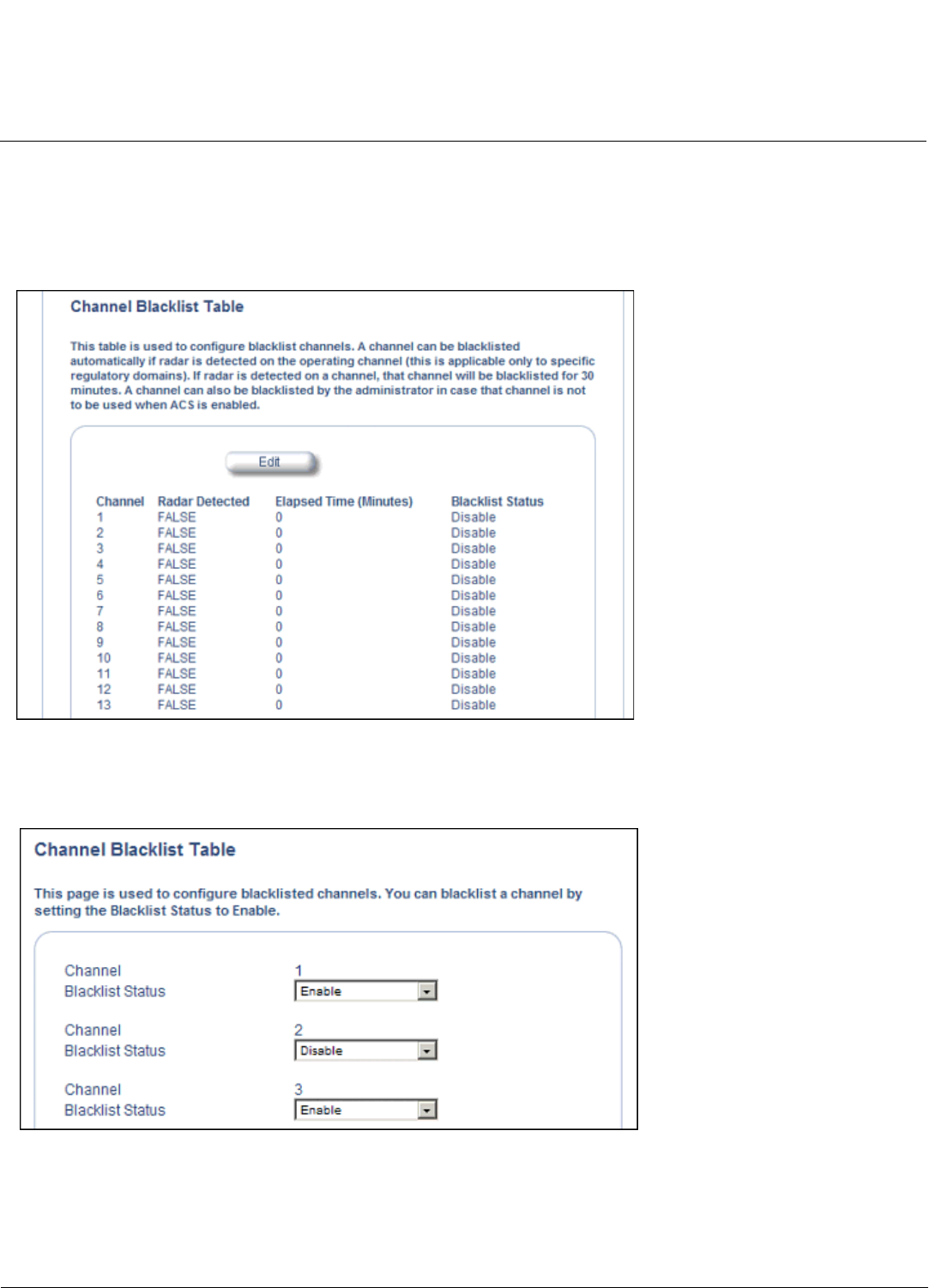
Advanced Configuration AP-700 User Guide
Interfaces
56
channel is blacklisted automatically if it is found to be busy or occupied by radar during a scan at start-up. When a
channel has been automatically blacklisted, it will remain blacklisted for 30 minutes. Additionally, an administrator can
blacklist channels manually to prevent them from being used when ACS is enabled. To blacklist a channel manually:
1. Click on Configure > Interfaces > Wireless A.
2. Scroll down to the Channel Blacklist heading.
Figure 4-11 Channel Blacklist Table
3. Click Edit in the Channel Blacklist Table
4. Set Blacklist Status to Enable.
Figure 4-12 Channel Blacklist Table - Edit Screen
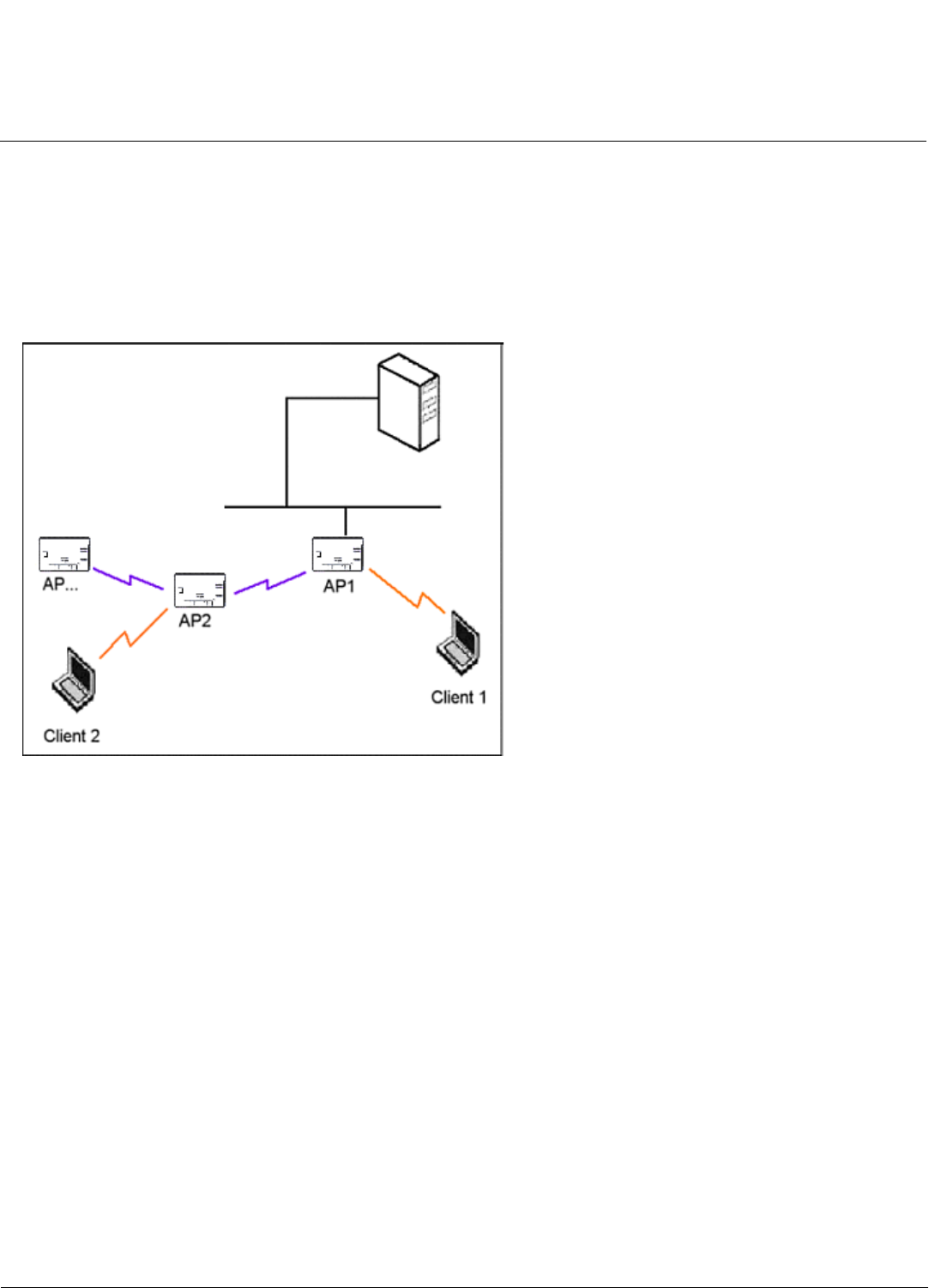
Advanced Configuration AP-700 User Guide
Interfaces
57
Wireless Distribution System (WDS)
A Wireless Distribution System (WDS) creates a link between two 802.11a, 802.11b, or 802.11b/g APs over their radio
interfaces. This link relays traffic from one AP that does not have Ethernet connectivity to a second AP that has Ethernet
connectivity. WDS allows you to configure up to six (6) ports.
In the WDS example below, AP 1 and AP 2 communicate over a WDS link (represented by the blue line). This link
provides Client 2 with access to network resources even though AP 2 is not directly connected to the Ethernet network.
Packets destined for or sent by the client are relayed between the Access Points over the WDS link.
Figure 4-13 WDS Example
Bridging WDS
Each WDS link is mapped to a logical WDS port on the AP. WDS ports behave like Ethernet ports rather than like
standard wireless interfaces: on a BSS port, an Access Point learns by association and from frames; on a WDS or
Ethernet port, an Access Point learns from frames only. When setting up a WDS, keep in mind the following:
• There are separate security settings for clients and WDS links. The same WDS link security mode must be configured
(currently we only support none or WEP) on each Access Point in the WDS and the same WEP key must be
configured.
• The WDS link shares the communication bandwidth with the clients. Therefore, while the maximum data rate for the
Access Point's cell is 54 Mbits/second (802.11a, 802.11g only, or 802.b/g modes) or 11 Mbits/second (802.11b only
mode), client throughput will decrease when traffic is passing over the WDS link.
• If there is no partner MAC address configured in the WDS table, the WDS port remains disabled.
• A WDS port on a single AP should have a unique partner MAC address. Do not enter the same MAC address twice in
an AP’s WDS port list.
• Each Access Point that is a member of the WDS must have the same Channel setting to communicate with each
other.
• If your network does not support spanning tree, be careful to avoid creating network loops between APs. For example,
creating a WDS link between two Access Points connected to the same Ethernet network will create a network loop (if
spanning tree is disabled). For more information, see the Spanning Tree section.
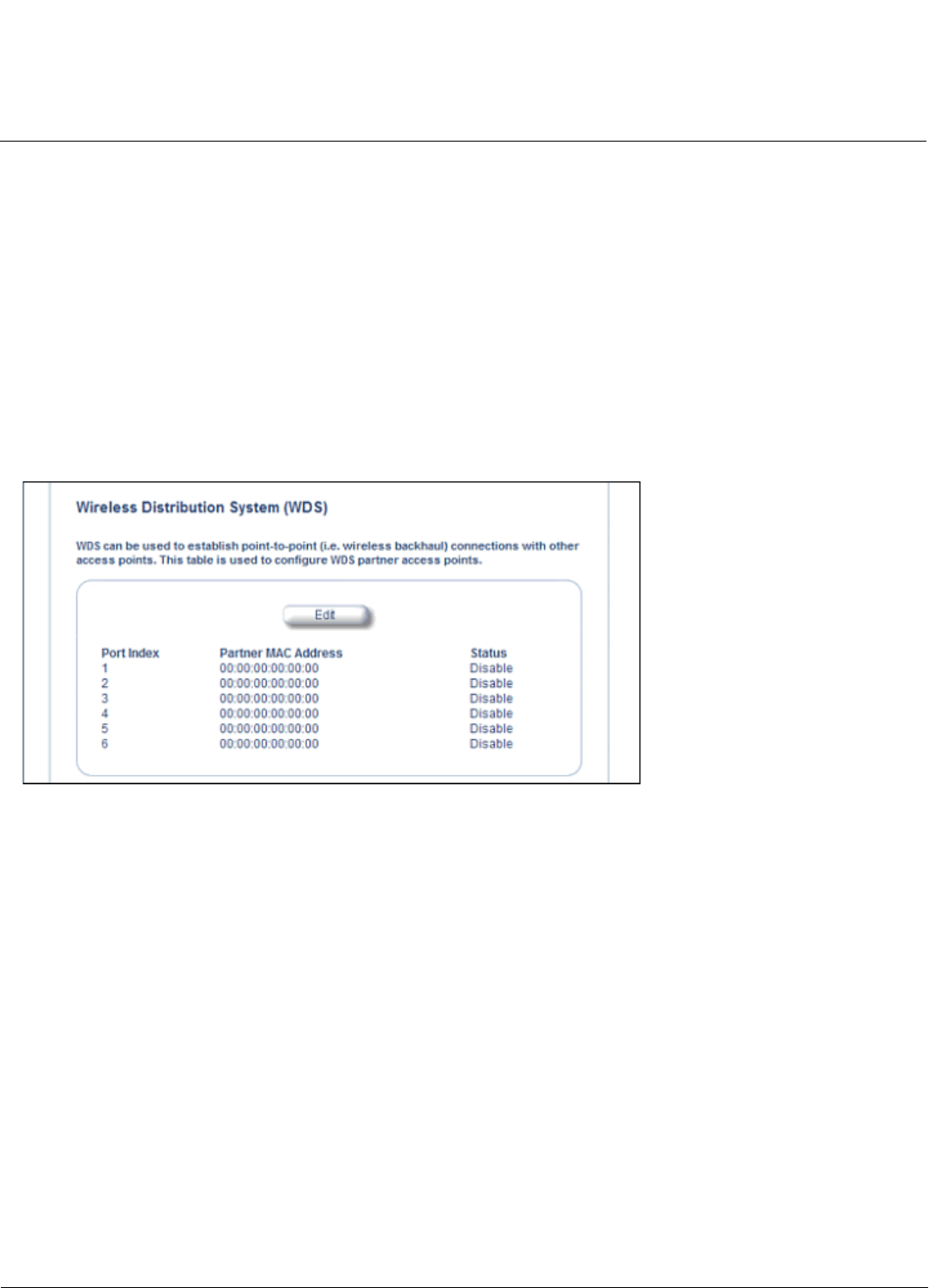
Advanced Configuration AP-700 User Guide
Interfaces
58
• When WDS is enabled, Spanning Tree protocol is automatically enabled. It may be manually disabled. If Spanning
Tree protocol is enabled by WDS and WDS is subsequently disabled, Spanning tree will remain enabled until it is
manually disabled. See Spanning Tree.
WDS Setup Procedure
NOTE: You must disable Auto Channel Select to create a WDS. Each Access Point that is a member of the WDS must
have the same channel setting to communicate with each other.
To setup a wireless backbone follow the steps below for each AP that you wish to include in the Wireless Distribution
System.
1. Confirm that Auto Channel Select is disabled.
2. Write down the MAC Address of the radio that you wish to include in the Wireless Distribution System.
3. Click on Configure > Interfaces > Wireless A.
4. Scroll down to the Wireless Distribution System heading.
Figure 4-14 WDS Configuration
5. Click the Edit button to update the Wireless Distribution System (WDS) Table.
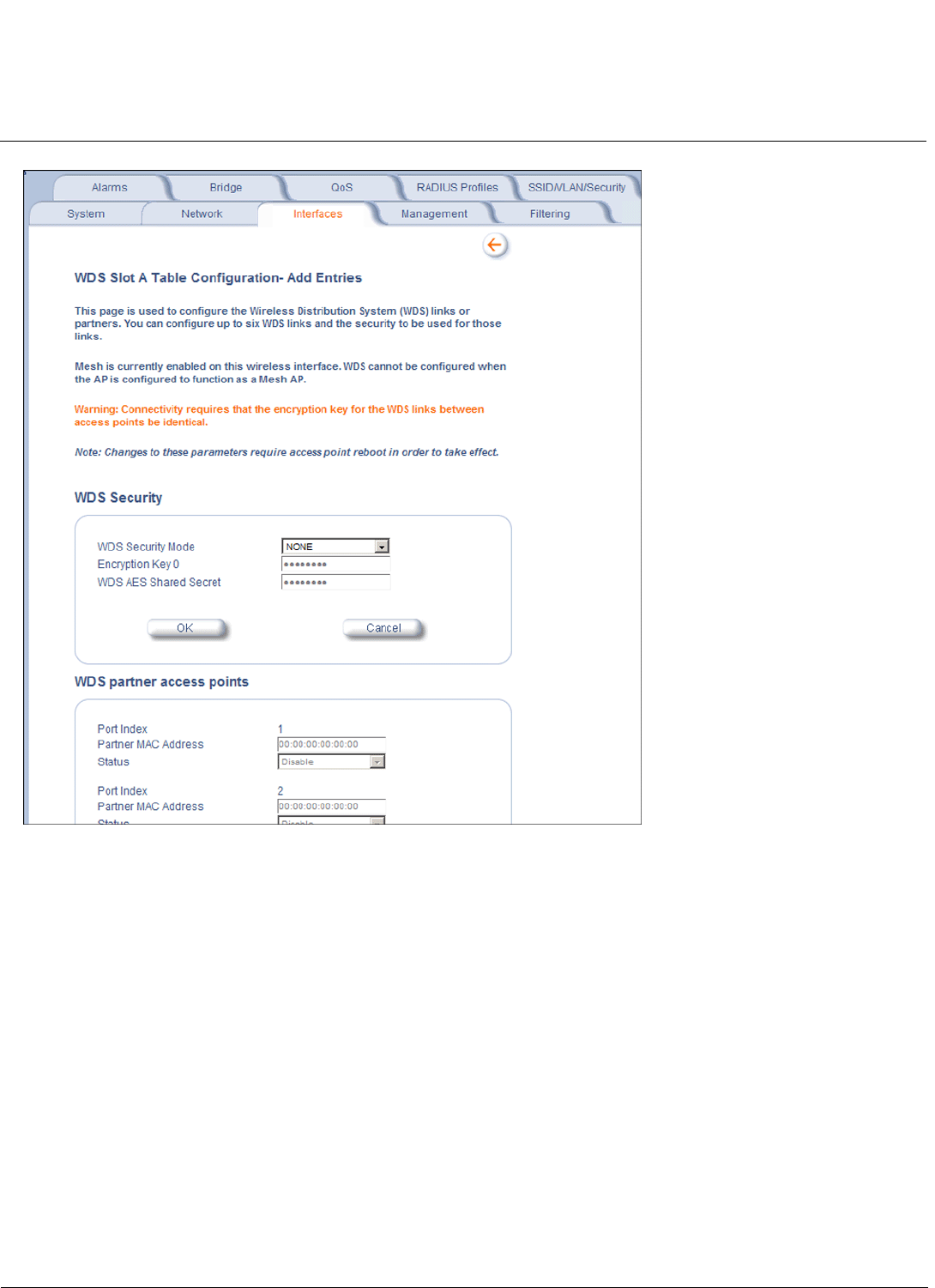
Advanced Configuration AP-700 User Guide
Interfaces
59
Figure 4-15 Adding WDS Links
6. Select which encryption method to use (if any) from the WDS Security Mode drop-down menu.
7. If you selected a WDS Security Mode, do one of the following:
• If you selected WEP: Enter an encryption key.
• If you selected AES: Enter a shared secret.
8. Enter the MAC Address that you wrote down in Step 2 in one of the Partner MAC Address field of the Wireless
Distribution Setup window.
9. Set the Status of the device to Enable.
10.Click OK.
11.Reboot the AP.
Ethernet
Select the desired speed and transmission mode from the drop-down menu. Half-duplex means that only one side can
transmit at a time and full-duplex allows both sides to transmit. When set to auto-duplex, the AP negotiates with its switch
or hub to automatically select the highest throughput option supported by both sides.
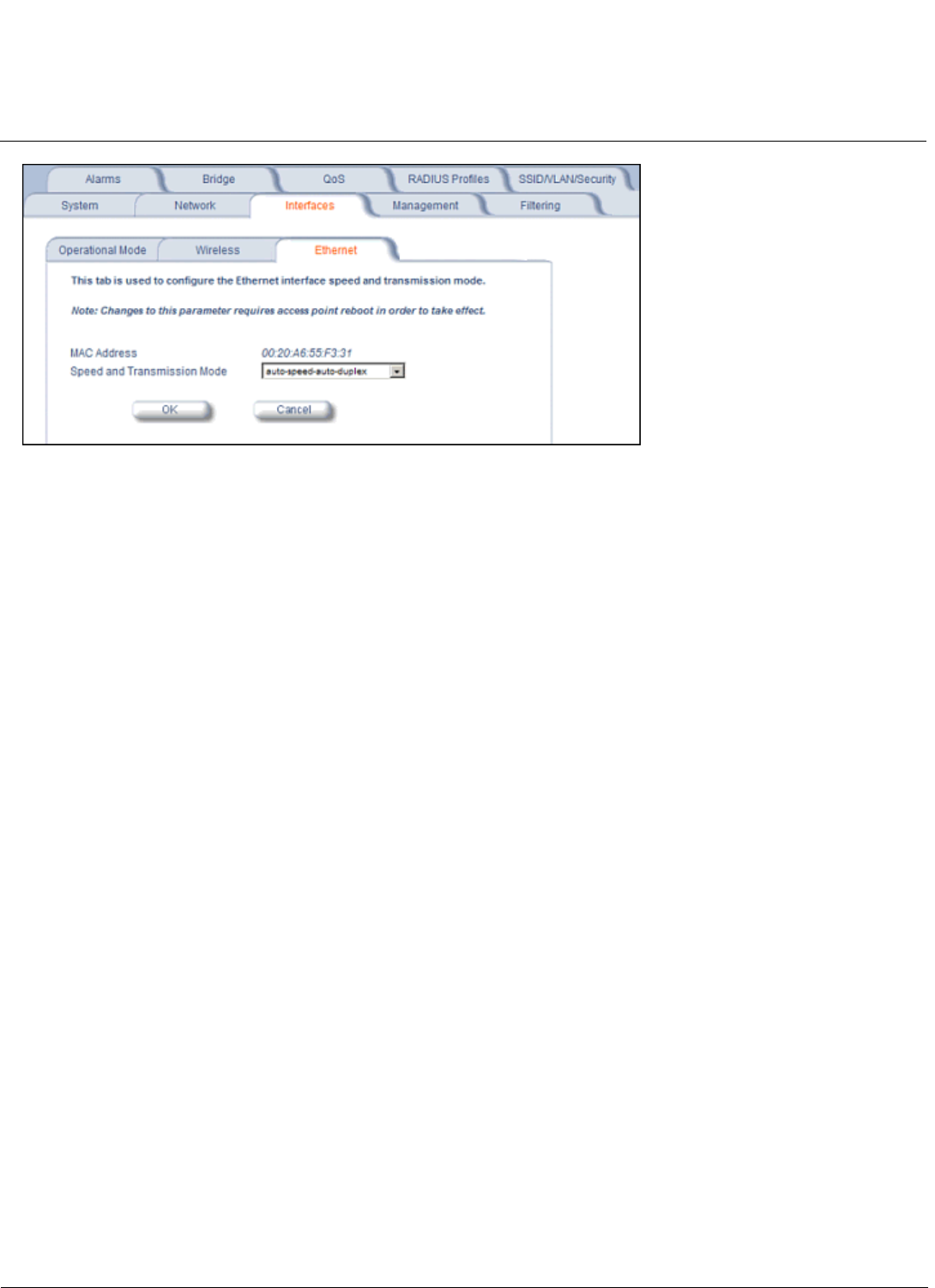
Advanced Configuration AP-700 User Guide
Interfaces
60
Figure 4-16 Ethernet Sub-tab
For best results, Proxim recommends that you configure the Ethernet setting to match the speed and transmission mode
of the device the Access Point is connected to (such as a hub or switch). If in doubt, leave this setting at its default,
auto-speed-auto-duplex. Choose between:
• 10 Mbit/s - half duplex or full duplex
• 100 Mbit/s - half duplex or full duplex
• Auto speed - auto duplex

Advanced Configuration AP-700 User Guide
Management
61
Management
The Management tab contains the following sub-tabs:
•Passwords
•IP Access Table
•Services
•Automatic Configuration (AutoConfig)
•Hardware Configuration Reset (CHRD)
Passwords
Passwords are stored in flash memory and secured using encryption. You can configure the following passwords:
•SNMP Read Community Password: The password for read access to the AP using SNMP. Enter a password
between 6 and 32 characters in both the Password field and the Confirm field. The default password is public.
•SNMP Read/Write Community Password: The password for read and write access to the AP using SNMP. Enter a
password between 6 and 32 characters in both the Password field and the Confirm field. The default password is
public.
•SNMPv3 Authentication Password: The password used when sending authenticated SNMPv3 messages. Enter a
password in both the Password field and the Confirm field. This password must be between 6 and 32 characters, but
a length of at least 8 characters is recommended. The default password is public. Secure Management (Services tab)
must be enabled to configure SNMPv3.
The default SNMPv3 username is administrator, with SHA authentication and DES privacy protocol.
•SNMPv3 Privacy Password: The password used when sending encrypted SNMPv3 data. Enter a password in both
the Password field and the Confirm field. This password must be between 6 and 32 characters, but a length of at
least 8 characters is recommended. The default password is public. Secure Management (Services tab) must be
enabled to configure SNMPv3.
•Telnet (CLI) Password: The password for the CLI interface (via serial or Telnet). Enter a password between 6 and 32
characters in both the Password field and the Confirm field. The default password is public.
•HTTP (Web) Password: The password for the Web browser HTTP interface. Enter a password between 6 and 32
characters in both the Password field and the Confirm field. The default password is public.
NOTE: For security purposes Proxim recommends changing ALL PASSWORDS from the default “public” immediately, to
restrict access to your network devices to authorized personnel. If you lose or forget your password settings, you
can always perform a Soft Reset to Factory Defaults or Hard Reset to Factory Defaults.
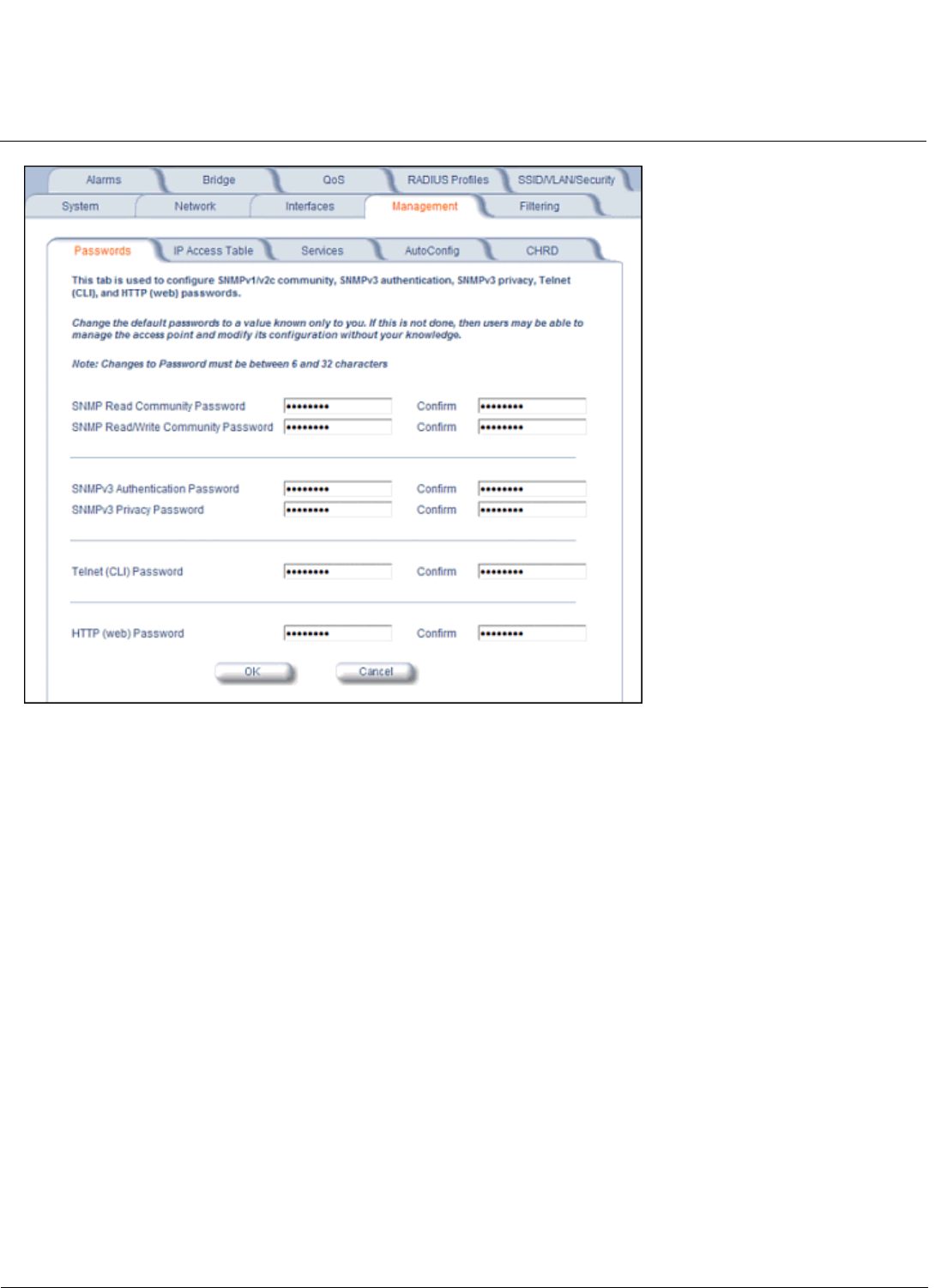
Advanced Configuration AP-700 User Guide
Management
62
IP Access Table
The Management IP Access table limits in-band management access to the IP addresses or range of IP addresses
specified in the table. This feature applies to all management services (SNMP, HTTP, and CLI) except for CLI
management over the serial port. To configure this table, click Add and set the following parameters:
•IP Address: Enter the IP Address for the management station.
•IP Mask: Enter a mask that will act as a filter to limit access to a range of IP Addresses based on the IP Address you
already entered.
– The IP mask 255.255.255.255 would authorize the single station defined by the IP Address to configure the
Access Point. The AP would ignore commands from any other IP address. In contrast, the IP mask 255.255.255.0
would allow any device that shares the first three octets of the IP address to configure the AP. For example, if you
enter an IP address of 10.20.30.1 with a 255.255.255.0 subnet mask, any IP address between 10.20.30.1 and
10.20.30.254 will have access to the AP’s management interfaces.
•Comment: Enter an optional comment, such as the station name.
To edit or delete an entry, click Edit. Edit the information, or select Enable, Disable, or Delete from the Status pull-down
menu.
Services
You can configure the following management services:
Secure Management
Secure Management allows the use of encrypted and authenticated communication protocols such as SNMPv3, Secure
Socket Link (SSL), and Secure Shell (SSH) to manage the Access Point.

Advanced Configuration AP-700 User Guide
Management
63
•Secure Management Status: Enables the further configuration of HTTPS Access, SNMPv3, and Secure Shell
(SSH). After enabling Secure Management, you can choose to configure HTTPS (SSL) and Secure Shell access on
the Services tab, and to configure SNMPv3 passwords on the Passwords tab.
SNMP Settings
•SNMP Interface Bitmask: Configure the interface or interfaces (Ethernet, Wireless, All Interfaces) from which you
will manage the AP via SNMP. You can also select Disabled to prevent a user from accessing the AP via SNMP.
HTTP Access
•HTTP Interface Bitmap: Configure the interface or interfaces (Ethernet, Wireless, All Interfaces) from which you
will manage the AP via the Web interface. For example, to allow Web configuration via the Ethernet network only, set
HTTP Interface Bitmask to Ethernet. You can also select Disabled to prevent a user from accessing the AP from the
Web interface.
•HTTP Port: Configure the HTTP port from which you will manage the AP via the Web interface. By default, the HTTP
port is 80. You must reboot the Access Point if you change the HTTP Port.
•HTTP Wizard Status: The Setup Wizard appears automatically the first time you access the HTTP interface. If you
exited out of the Setup Wizard and want to relaunch it, enable this option, click OK, and then close your browser or
reboot the AP. The Setup Wizard will appear the next time you access the HTTP interface.
HTTPS Access (Secure Socket Layer)
NOTE: SSL requires Internet Explorer version 6, 128 bit encryption, Service Pack 1, and patch Q323308.
NOTE: You need to reboot the AP after enabling or disabling SSL for the changes to take effect.
•HTTPS (Secure Web Status): The user can access the AP in a secure fashion using Secure Socket Layer (SSL)
over port 443. The AP comes pre-installed with all required SSL files: default certificate and private key installed. Use
the drop-down menu to enable/disable this feature.
•SSL Certificate Passphrase: After enabling SSL, the only configurable parameter is the SSL passphrase. The
default SSL passphrase is proxim.
The AP supports SSLv3 with a 128-bit encryption certificate maintained by the AP for secure communications
between the AP and the HTTP client. All communications are encrypted using the server and the client-side
certificate.
If you decide to upload a new certificate and private key (using TFTP or HTTP File Transfer), you need to change the
SSL Certificate Passphrase for the new SSL files.
Accessing the AP through the HTTPS interface
The user should use a SSL intelligent browser to access the AP through the HTTPS interface. After configuring SSL,
access the AP using https:// followed by the AP’s management IP address.
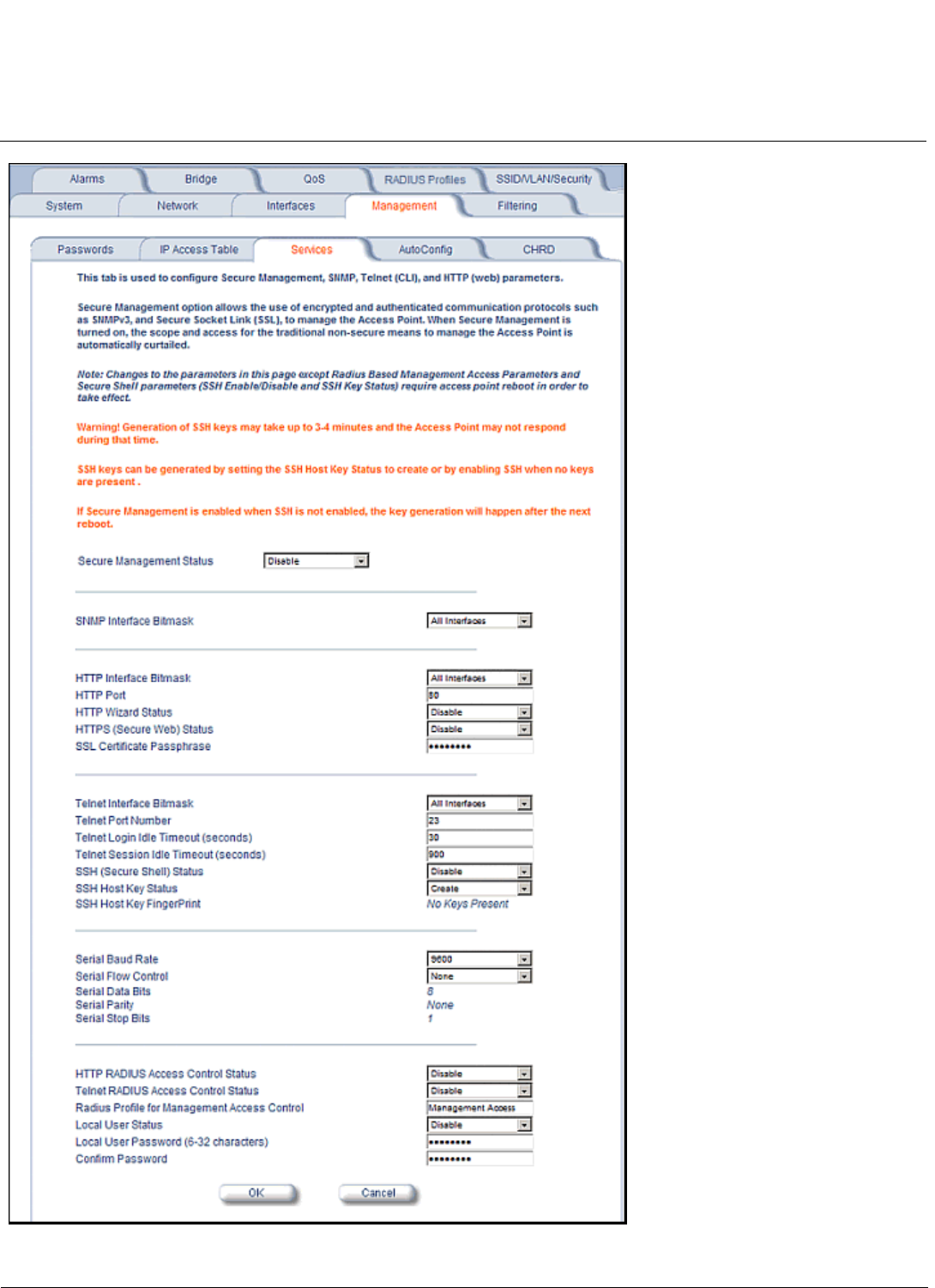
Advanced Configuration AP-700 User Guide
Management
64
Figure 4-17 Management Services Configuration Screen

Advanced Configuration AP-700 User Guide
Management
65
Telnet Configuration Settings
•Telnet Interface Bitmask: Select the interface (Ethernet, Wireless, All Interfaces) from which you can manage the
AP via telnet. This parameter can also be used to Disable telnet management.
•Telnet Port Number: The default port number for Telnet applications is 23. However, you can use this field if you want
to change the Telnet port for security reasons (but your Telnet application also must support the new port number you
select). You must reboot the Access Point if you change the Telnet Port.
•Telnet Login Idle Timeout (seconds): Enter the number of seconds the system will wait for a login attempt. The AP
terminates the session when it times out. The range is 30 to 300 seconds; the default is 60 seconds.
•Telnet Session Idle Timeout (seconds): Enter the number of seconds the system will wait during a session while
there is no activity. The AP will terminate the session on timeout. The range is 60 to 36000 seconds; the default is 900
seconds.
Secure Shell (SSH) Settings
The AP supports SSH version 2, for secure remote CLI (Telnet) sessions. SSH provides strong authentication and
encryption of session data.
The SSH server (AP) has host keys - a pair of asymmetric keys - a private key that resides on the AP and a public key
that is distributed to clients that need to connect to the AP. As the client has knowledge of the server host keys, the client
can verify that it is communicating with the correct SSH server. The client authentication is performed as follows:
• Using a username/password pair if RADIUS Based Management is enabled; otherwise, using a password to
authenticate the user over a secure channel created using SSH.
SSH Session Setup
An SSH session is setup through the following process:
• The SSH server public key is transferred to the client using out-of-band or in-band mechanisms.
• The SSH client verifies the correctness of the server using the server’s public key.
• The user/client authenticates to the server.
• An encrypted data session starts. The maximum number of SSH sessions is limited to two. If there is no activity for a
specified amount of time (the Telnet Session Timeout parameter), the AP will timeout the connection.
SSH Clients
The following SSH clients have been verified to interoperate with the AP’s server. The following table lists the clients,
version number, and the website of the client.
For key generation, OpenSSH client has been verified.
Configuring SSH
Perform the following procedure to set the SSH host key and enable or disable SSH:
1. Click Configure > Management > Services
2. Select the SSH Host Key Status from the drop down menu.
NOTE: SSH Host Key Status can not be changed if SSH status or Secure Management is enabled.
3. To enable/disable SSH, select Enable/Disable from the SSH (Secure Shell) Status drop-down menu.
Clients Version Website
OpenSSH V3.4-2 http://www.openssh.com
Putty Rel 0.53b http://www.chiark.greenend.org.uk
Zoc 5.00 http://www.emtec.com
Axessh V2.5 http://www.labf.com
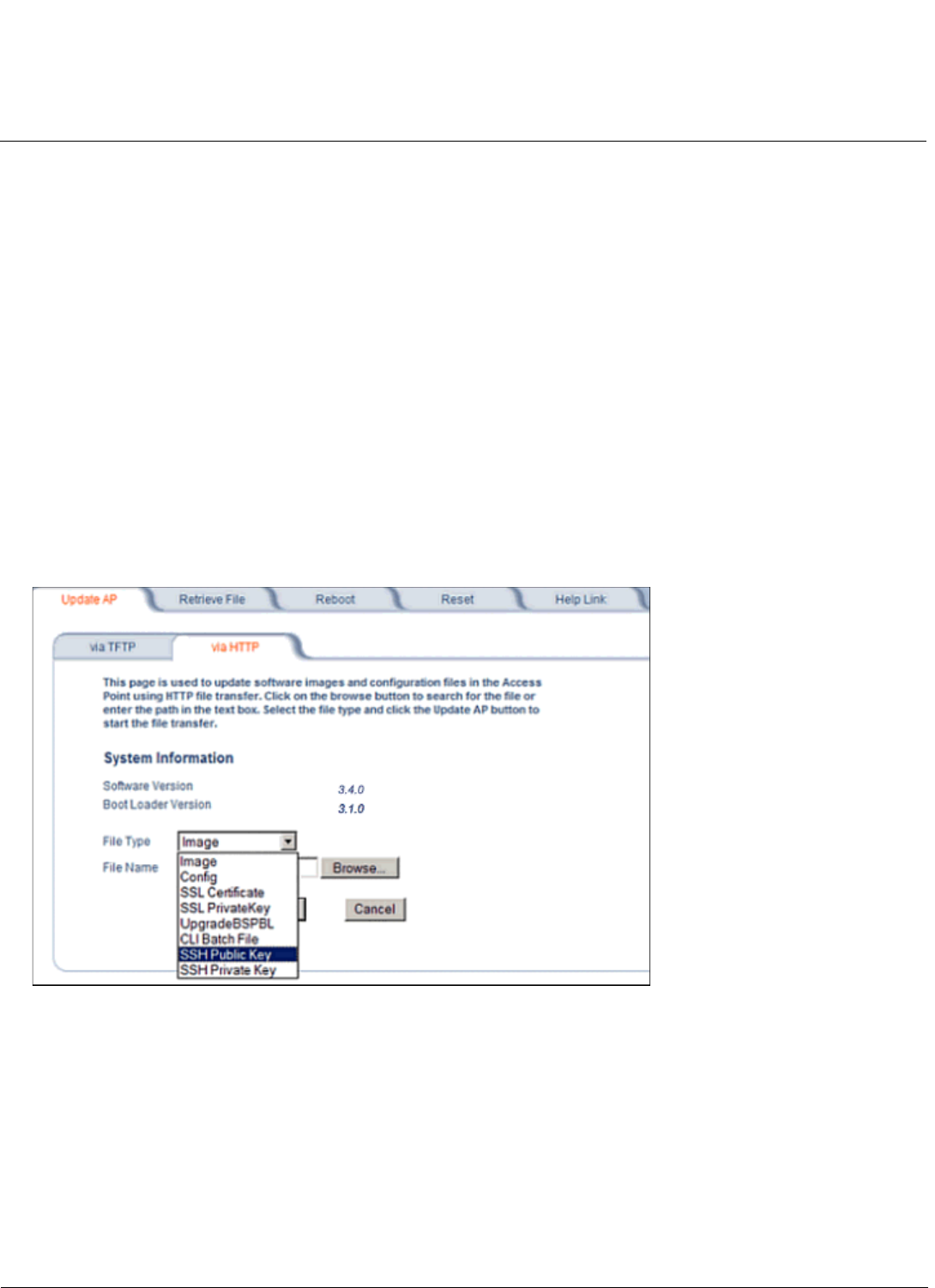
Advanced Configuration AP-700 User Guide
Management
66
NOTE: When Secure Management is enabled on the AP, SSH will be enabled by default and cannot be disabled.
Host keys must either be generated externally and uploaded to the AP (see Uploading Externally Generated Host Keys),
generated manually, or auto-generated at the time of SSH initialization if SSH is enabled and no host keys are present.
There is no key present in an AP that is in a factory default state.
To manually generate or delete host keys on the AP:
CAUTION: SSH Host key creation may take 3 to 4 minutes during which time the AP may not respond.
•Select Create to generate a new pair of host keys.
•Select Delete to remove the host keys from the AP. If no host keys are present, the AP will not allows connections
using SSH. When host keys are created or deleted, the AP updates the fingerprint information displayed on the
Management > Services page.
Uploading Externally Generated Host Keys
Perform the following procedure to upload externally generated host keys to the AP. You must upload both the SSH
public key and SSH private key for SSH to work.
1. Verify that the host keys have been externally generated. The OpenSSH client has been verified to interoperate with
AP’s SSH server.
2. Click Commands > Update AP > via HTTP (or via TFTP).
Figure 4-18 Uploading an Externally Generated SSH Public Key and SSH Private Key
3. Select SSH Public Key from the File Type drop-down menu.
4. Click Browse, select the SSH Public Key file on your local machine.
5. Click Open.
6. to initiate the file transfer, click the Update AP button.
7. Select SSH Private Key from the File Type drop-down menu.
8. Click Browse, select the SSH Private Key on your local machine.
9. Click Open.
10.To initiate the file transfer, click the Update AP button.
The fingerprint of the new SSH public key will be displayed in the Management > Services page.

Advanced Configuration AP-700 User Guide
Management
67
Serial Configuration Settings
The serial port interface on the AP is enabled at all times. See Setting IP Address using Serial Port for information on how
to access the CLI interface via the serial port. You can configure and view the following parameters:
•Serial Baud Rate: Select the serial port speed (bits per second). Choose between 2400, 4800, 9600, 19200, 38400,
or 57600; the default Baud Rate is 9600.
•Serial Flow Control: Select either None (default) or Xon/Xoff (software controlled) data flow control.
NOTE: To avoid potential problems when communicating with the AP through the serial port, Proxim recommends
that you leave the Flow Control setting at None (the default value).
•Serial Data Bits: This is a read-only field and displays the number of data bits used in serial communication (8 data
bits by default).
•Serial Parity: This is a read-only field and displays the number of parity bits used in serial communication (no parity
bits by default).
•Serial Stop Bits: This is a read-only field that displays the number of stop bits used in serial communication (1 stop
bit by default).
NOTE: The serial port bit configuration is commonly referred to as 8N1.
RADIUS Based Management Access
User management of APs can be centralized by using a RADIUS server to store user credentials. The AP cross-checks
credentials using RADIUS protocol and the RADIUS server accepts or rejects the user.
HTTP/HTTPS and Telnet/SSH users can be managed with RADIUS. Serial CLI and SNMP cannot be managed by
RADIUS. Two types of users can be supported using centralized RADIUS management:
•Super User: The super user has access to all functionality of a management interface. A super user is configured in
the RADIUS server by setting the filter ID attribute (returned in the RADIUS Accept packet) for the user to a value of
“super user” (not case sensitive). A user is considered a super user if the value of the filter-id attribute returned in the
RADIUS Accept packet for the user is “super user” (not case sensitive).
•Limited User: A limited user has access to only a limited set of functionality on a management interface. All users
who are not super users are considered limited users. However, a limited user is configured in the RADIUS server by
setting the filter-id attribute (returned in the RADIUS Accept packet) to “limited user” (not case sensitive). Limited
users do not have access to the following configuration capabilities:
– Update/retrieve files to and from APs
– Reset the AP to factory defaults
– Reboot the AP
– Change management properties related to RADIUS, management modes, and management passwords.
NOTE: When a user has both “limited user” and “super user” filter-ids configured in the Radius server, the user has
limited user privileges.
When RADIUS Based Management is enabled, a local user can be configured to provide Telnet, SSH, and HTTP(S)
access to the AP when RADIUS servers fail. The local user has super user capabilities. When secure management is
enabled, the local user can only login using secure means (i.e., SSH or SSL). When the local user option is disabled the
only access to the AP when RADIUS servers are down will be through serial CLI or SNMP.
The Radius Based Management Access parameters allows you to enable HTTP or Telnet Radius Management Access,
to configure a RADIUS Profile for management access control, and to enable or disable local user access, and configure
the local user password. You can configure and view the following parameters:
•HTTP RADIUS Access Control Status: Enable RADIUS management of HTTP/HTTPS users.
•Telnet RADIUS Access Control Status: Enable RADIUS management of Telnet/SSH users.

Advanced Configuration AP-700 User Guide
Management
68
•RADIUS Profile for Management Access Control: Specifies the RADIUS Profile to be used for RADIUS Based
Management Access.
•Local User Status: Enables or disables the local user when RADIUS Based Management is enabled. The default
local user ID is root.
•Local User Password and Confirm Password: The default local user password is public. “Root” cannot be
configured as a valid user for Radius based management access when local user access is enabled.
Automatic Configuration (AutoConfig)
The Automatic Configuration feature which allows an AP to be automatically configured by downloading a specific
configuration file from a TFTP server during the boot up process.
Automatic Configuration is disabled by default. The configuration process for Automatic Configuration varies depending
on whether the AP is configured for dynamic or static IP.
When an AP is configured for dynamic IP, the Configuration filename and the TFTP server IP address are contained in
the DHCP response when the AP gets its IP address dynamically from the DHCP server. When configured for static IP,
these parameters are instead configured in the AP interface.
After setting up automatic configuration you must reboot the AP. When the AP reboots it receives the new configuration
information and must reboot one additional time. If Syslog is configured, a Syslog message will appear indicating the
success or failure of the Automatic Configuration.
Auto Configuration and the CLI Batch File
The Auto Configuration feature allows download of the LTV (Length, Type, Value) format configuration file or the CLI
Batch file. The LTV file contains parameters used by the AP; the CLI Batch file contains CLI executable commands used
to set AP parameters. The AP detects whether the uploaded file is LTV format or a CLI Batch file. If the AP detects an
LTV file, it stores the file in the AP’s flash memory. If the AP detects a CLI Batch file (a file with an extension of .cli), the
AP executes the commands contained in the file immediately. The AP will reboot after executing the CLI Batch file. Auto
Configuration will not result in repeated reboots if the CLI Batch file contains rebootable parameters.
For more information, see the CLI Batch File section.
Set up Automatic Configuration for Static IP
Perform the following procedure to enable and set up Automatic Configuration when you have a static IP address for the
TFTP server.
1. Click Configure > Management > AutoConfig. The Automatic Configuration Screen appears.
2. Check Enable Auto Configuration.
3. Enter the Configuration Filename. The default is config.
4. Enter the IP address of the TFTP server in the TFTP Server Address field. The default is 169.254.128.133.
NOTE: The default filename is “config”. The default TFTP IP address is 169.254.128.133.
5. Click OK to save the changes.
6. Reboot the AP. When the AP reboots it receives the new configuration information and must reboot one additional
time. If a Syslog server was configured, the following messages can be observed on the Syslog server:
• AutoConfig for Static IP
• TFTP server address and configuration filename
• AutoConfig Successful
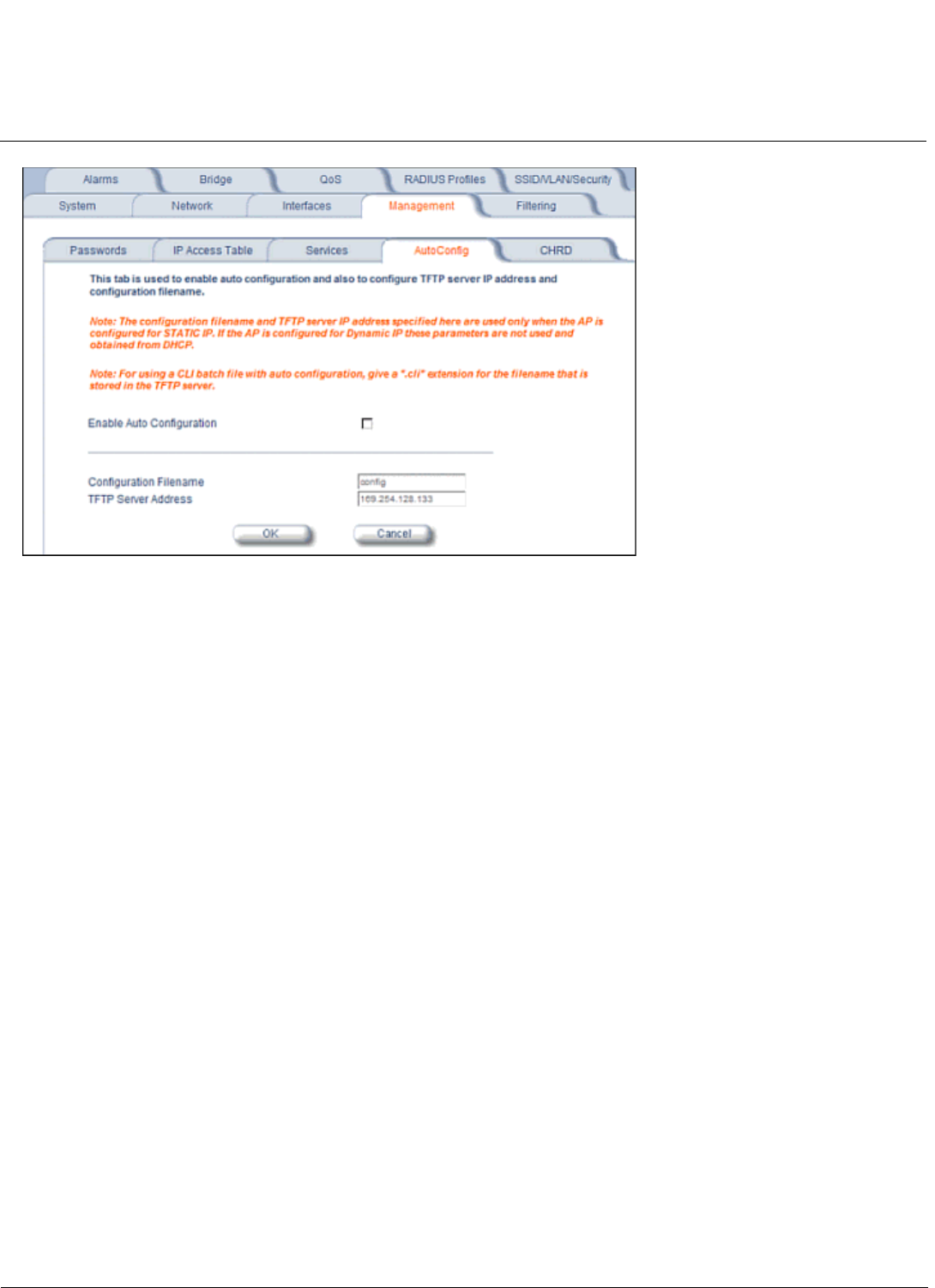
Advanced Configuration AP-700 User Guide
Management
69
Figure 4-19 Automatic Configuration Screen
Set up Automatic Configuration for Dynamic IP
Perform the following procedure to enable and set up Automatic Configuration when you have a dynamic IP address for
the TFTP server via DHCP.
The Configuration filename and the TFTP server IP address are contained in the DHCP response when the AP gets its IP
address dynamically from the DHCP server. A Syslog server address is also contained in the DHCP response, allowing
the AP to send Auto Configuration success and failure messages to a Syslog server.
NOTE: The configuration filename and TFTP server IP address are configured only when the AP is configured for Static
IP. If the AP is configured for Dynamic IP these parameters are not used and obtained from DHCP.
1. Click Configure > Management > AutoConfig.
The Automatic Configuration screen appears.
2. Check Enable Auto Configuration.
When the AP is Configured with Dynamic IP, the DHCP server should be configured with the TFTP Server IP address
("Boot Server Host Name", option 66) and Configuration file ("Bootfile name", option 67) as follows (note that this
example uses a Windows 2000 server):
3. Select DHCP Server > DHCP Option > Scope.
The DHCP Options: Scope screen appears.
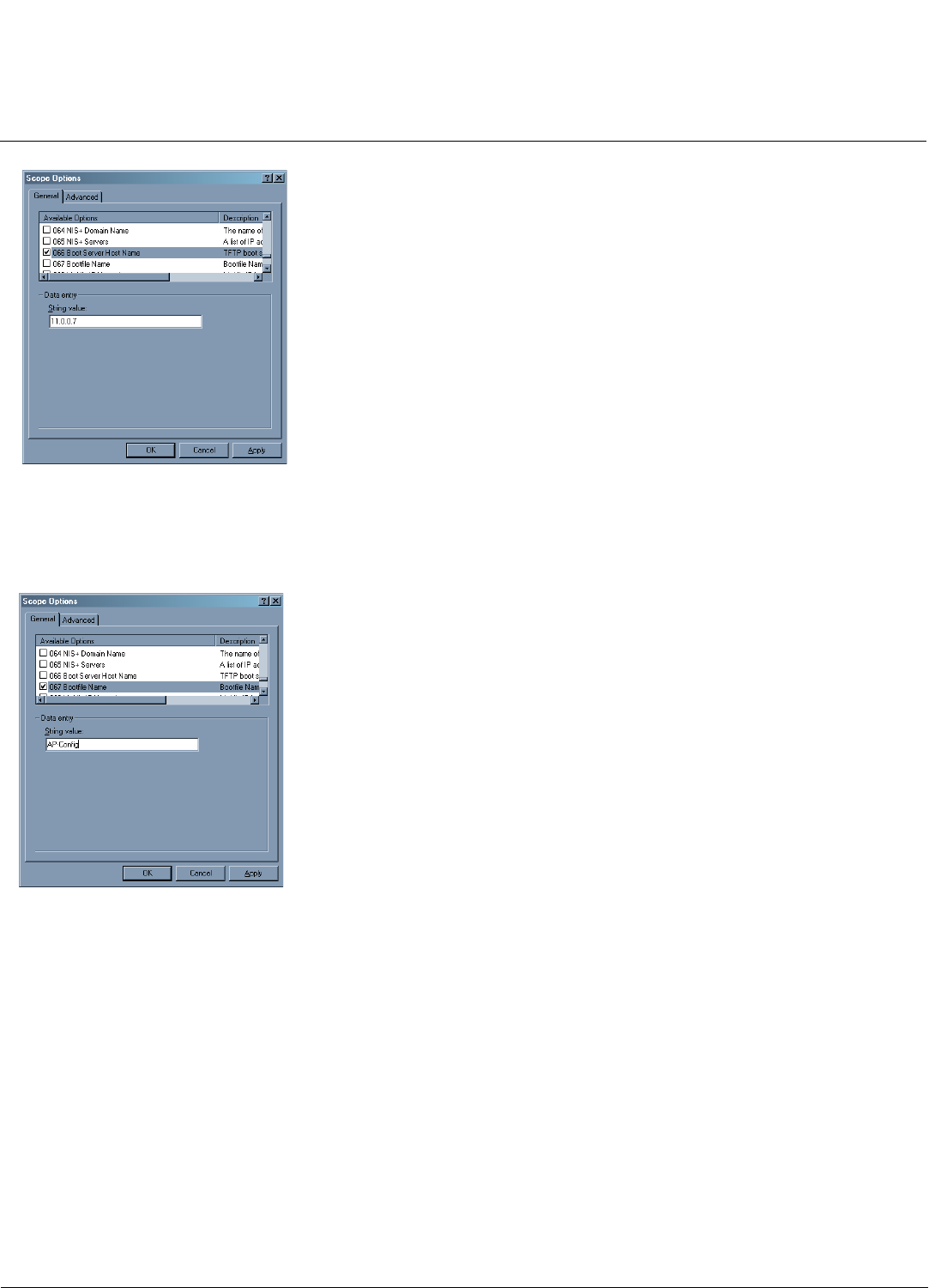
Advanced Configuration AP-700 User Guide
Management
70
Figure 4-20 DHCP Options: Setting the Boot Server Host Name
4. Add the Boot Server Hostname and Boot Filename parameters to the Available Options list.
5. Set the value of the Boot Server Hostname Parameter to the hostname or IP Address of the TFTP server. For
example: 11.0.0.7.
Figure 4-21 DHCP Options: Setting the Bootfile Name
6. Set the value of the Bootfile Name parameter to the Configuration filename. For example: AP-Config.
7. If using Syslog, set the Log server IP address (option 7, Log Servers).
8. Reboot the AP. When the AP reboots it receives the new configuration information and must reboot one additional
time. If a Syslog server was configured, the following messages can be observed on the Syslog server:
• AutoConfig for Dynamic IP
• TFTP server address and configuration filename
• AutoConfig Successful
Hardware Configuration Reset (CHRD)
Hardware Configuration Reset Status is a parameter that defines the hardware configuration reset behavior of the AP.
If a user loses or forgets the AP’s HTTP/Telnet/SNMP password, the Reload button on the power injector provides a way
to reset the AP to default configuration values and gain access to the AP. However, in AP deployments where physical
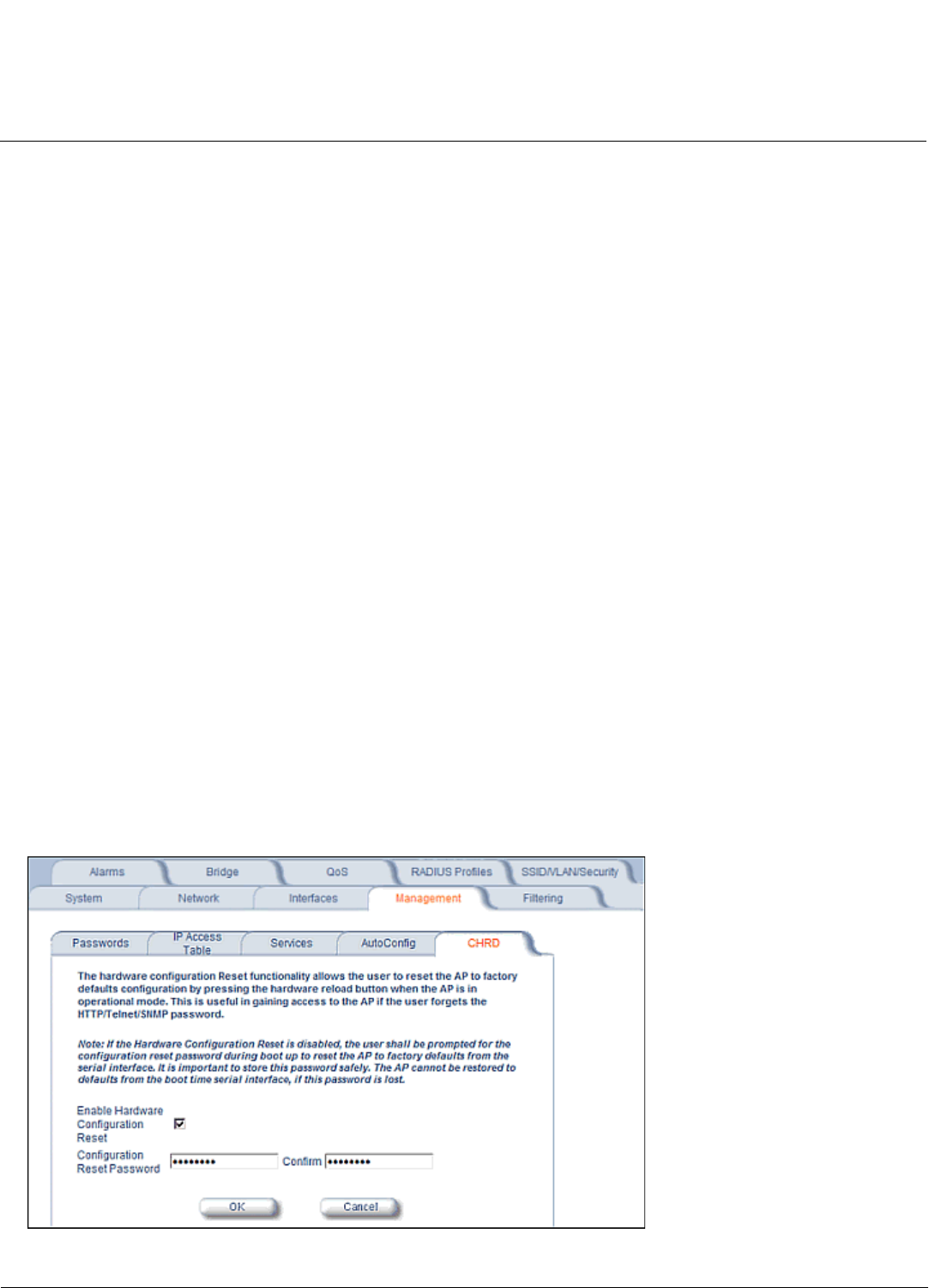
Advanced Configuration AP-700 User Guide
Management
71
access to the AP is not protected, an unauthorized person could reset the AP to factory defaults and thus gain control of
the AP. The user can disable the hardware configuration reset functionality to prevent unauthorized access.
The hardware configuration reset feature operates as follows:
• When hardware configuration reset is enabled, the user can press the Reload button on the power injector for 10
seconds when the AP is in normal operational mode in order to delete the AP configuration.
• When hardware configuration reset is disabled, pressing the Reload button when the AP is in normal operational
mode does not have any effect on the AP.
• The hardware configuration reset parameter does not have any effect on the functionality of the reload button to
delete the AP image during AP boot loader execution.
• The default hardware configuration reset status is enabled. When disabling hardware configuration reset, the user is
recommended to configure a configuration reset password. A configuration reset option appears on the serial port
during boot up, before the AP reads its configuration and initializes.
• Whenever the AP is reset to factory default configuration, hardware configuration reset status is enabled and the
configuration reset password is set to the default, “public”.
• If secure mode is enabled in the AP, only secure (SSL, SNMPv3, SSH) users can modify the values of the Hardware
Configuration Reset Status and the configuration reset password.
Configuration Reset via Serial Port During Bootup
If hardware configuration reset is disabled, the user gets prompted by a configuration reset option to reset the AP to
factory defaults during boot up from the serial interface. By pressing a key sequence (ctrl-R), the user gets prompted to
enter a configuration reset password before the configuration is reset.
NOTE: It is important to safely store the configuration reset password. If a user forgets the configuration reset password,
the user will be unable to reset the AP to factory default configuration if the AP becomes inaccessible and the
hardware configuration reset functionality is disable.
Configuring Hardware Configuration Reset
Perform the following procedure to configure Hardware Configuration Reset and to set the Configuration Reset
Password. See Figure 4-22.
1. Click Configure > Management > CHRD.
Figure 4-22 Hardware Configuration Reset

Advanced Configuration AP-700 User Guide
Management
72
2. Check (enable) or uncheck (disable) the Enable Hardware Configuration Reset checkbox.
3. Change the default Configuration Reset Password in the “Configuration Reset Password” and “Confirm” fields.
4. Click OK.
5. Reboot the AP.
NOTE: It is important to safely store the configuration reset password. If a user forgets the configuration reset password,
the user will be unable to reset the AP to factory default configuration if the AP becomes inaccessible and the
hardware configuration reset functionality is disable.
Procedure to Reset Configuration via the Serial Interface
1. During boot up, observe the message output on the serial interface.
The AP prompts the user with the message: “Press ctrl-R in 3 seconds to choose configuration reset option.”
2. Enter ctrl-R within 3 seconds after being prompted.
The AP prompts the user with “Press ctrl-Z to continue with normal boot up or enter password to reset configuration.”
If the user enters ctrl-Z, the AP continues to boot with the stored configuration.
3. Enter the configuration reset password. The default configuration reset password is “public”.
When the correct configuration reset password is entered, the AP gets reset to factory defaults and displays the
message “AP has been reset to Factory Default Settings.” The AP continues to boot up. If an incorrect configuration
reset password is entered, the AP shows an error message and reprompts the user. If the incorrect password is
entered three times in a row, the AP proceeds to boot up.
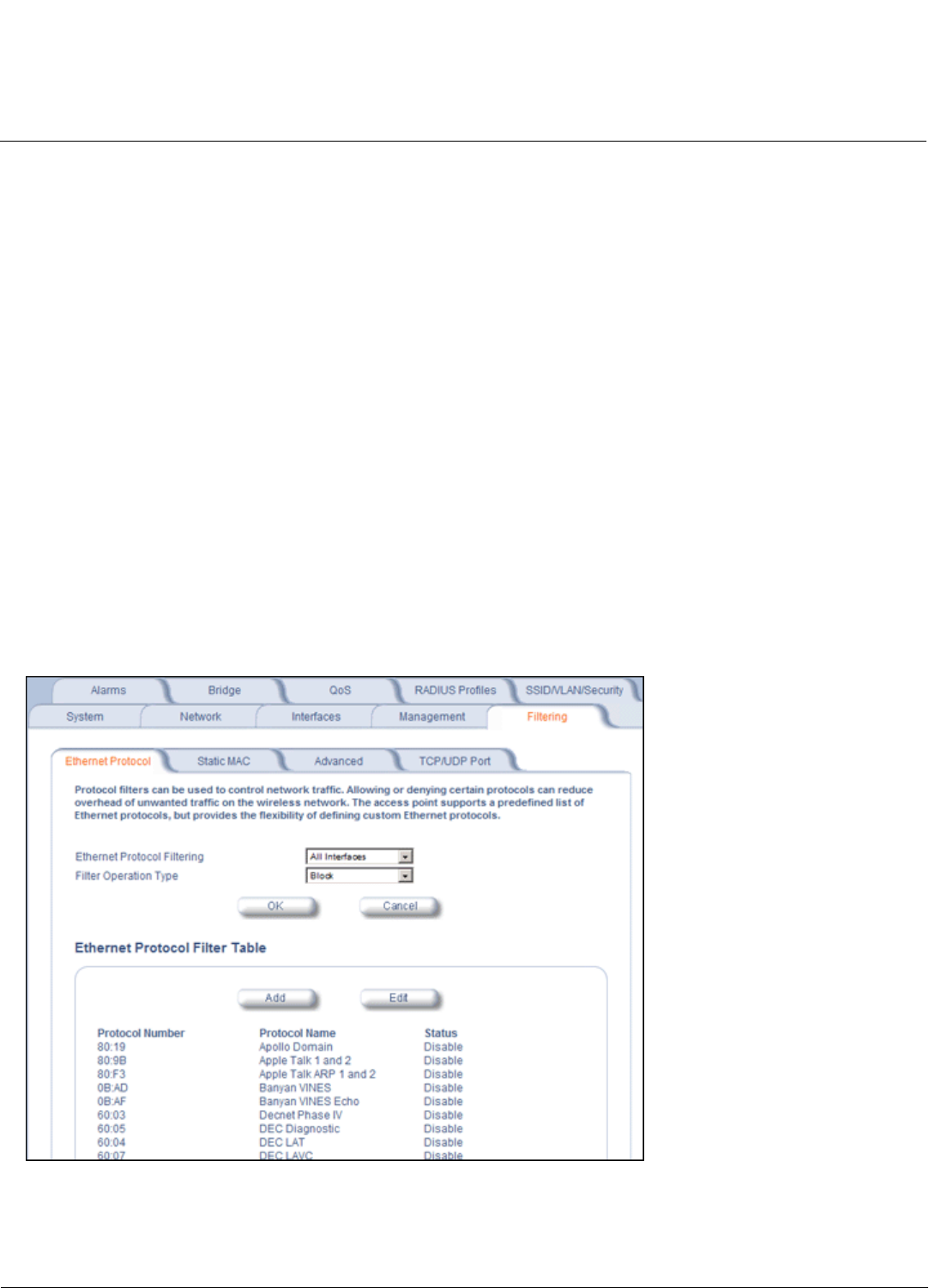
Advanced Configuration AP-700 User Guide
Filtering
73
Filtering
The Access Point’s Packet Filtering features help control the amount of traffic exchanged between the wired and wireless
networks. There are four sub-tabs under the Filtering heading:
•Ethernet Protocol
•Static MAC
•Advanced
•TCP/UDP Port
Ethernet Protocol
The Ethernet Protocol Filter blocks or forwards packets based on the Ethernet protocols they support.
Follow these steps to configure the Ethernet Protocol Filter:
1. Select the interface or interfaces that will implement the filter from the Ethernet Protocol Filtering drop-down menu.
•Ethernet: Packets are examined at the Ethernet interface
•Wireless: Packets are examined at the Wireless interface
•All Interfaces: Packets are examined at both interfaces
•Disabled: The filter is not used
2. Select the Filter Operation Type.
• If set to Passthru, only the enabled Ethernet Protocols listed in the Filter Table will pass through the bridge.
• If set to Block, the bridge will block enabled Ethernet Protocols listed in the Filter Table.
Figure 4-23 Ethernet Protocol Filter Configuration
3. Configure the Ethernet Protocol Filter Table. This table is pre-populated with existing Ethernet Protocol Filters,
however, you may enter additional filters by specifying the appropriate parameters.
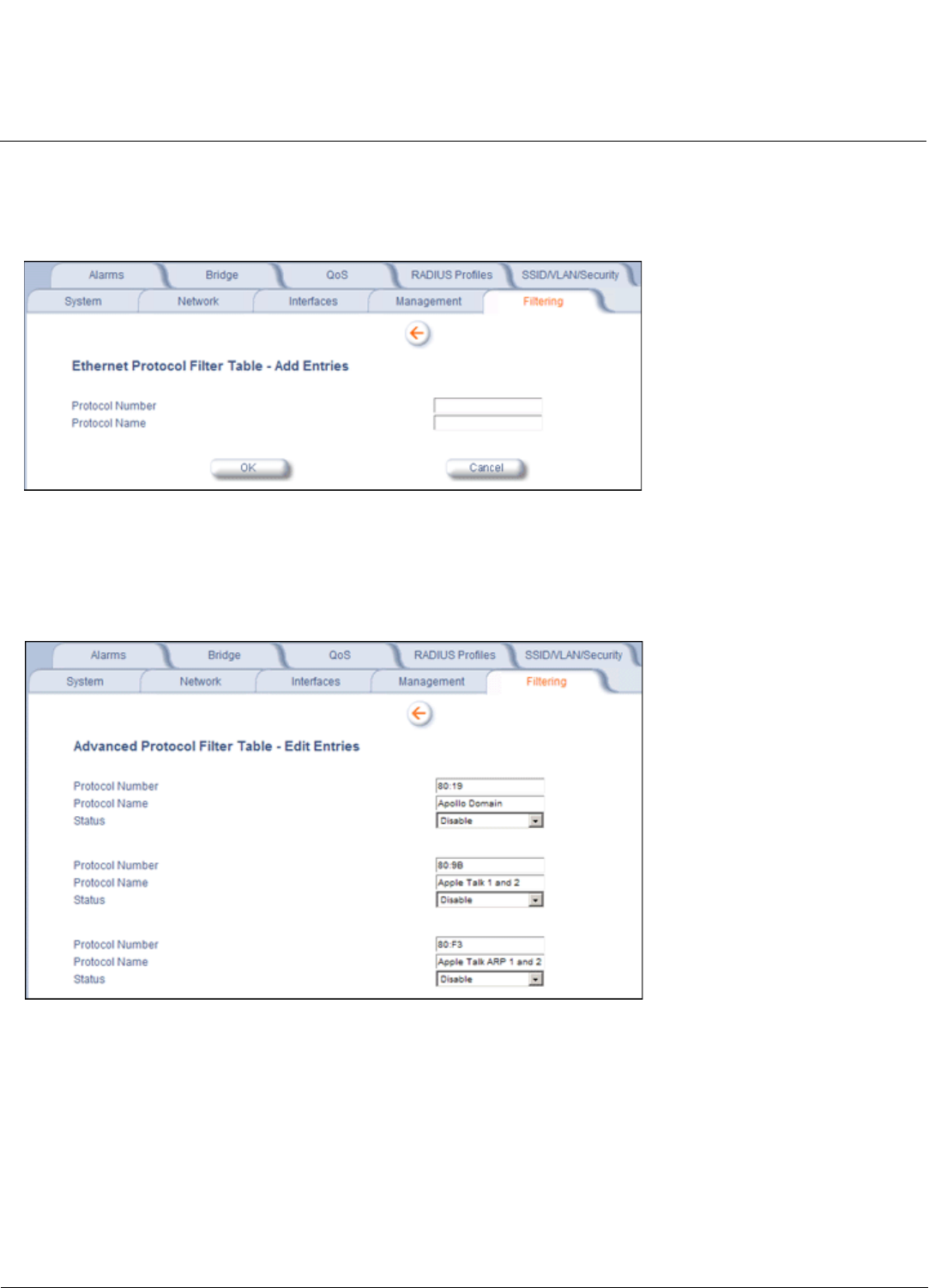
Advanced Configuration AP-700 User Guide
Filtering
74
• To add an entry, click Add, and then specify the Protocol Number and a Protocol Name.
–Protocol Number: Enter the protocol number. See http://www.iana.org/assignments/ethernet-numbers for a
list of protocol numbers.
–Protocol Name: Enter related information, typically the protocol name.
Figure 4-24 Ethernet Protocol Filter Table - Add Entries
• To edit or delete an entry, click Edit and change the information, or select Enable, Disable, or Delete from the
Status drop-down menu.
NOTE: An entry’s status must be enabled in order for the protocol to be subject to the filter.
Figure 4-25 Ethernet Protocol Filter Table - Edit Entries
Static MAC
The Static MAC Address filter optimizes the performance of a wireless (and wired) network. When this feature is properly
configured, the AP can block traffic between wired devices and wireless devices based on MAC address.
For example, you can set up a Static MAC filter to prevent wireless clients from communicating with a specific server on
the Ethernet network. You can also use this filter to block unnecessary multicast packets from being forwarded to the
wireless network.
NOTE: The Static MAC Filter is an advanced feature. You may find it easier to control wireless traffic via other filtering
options, such as Ethernet Protocol Filtering.
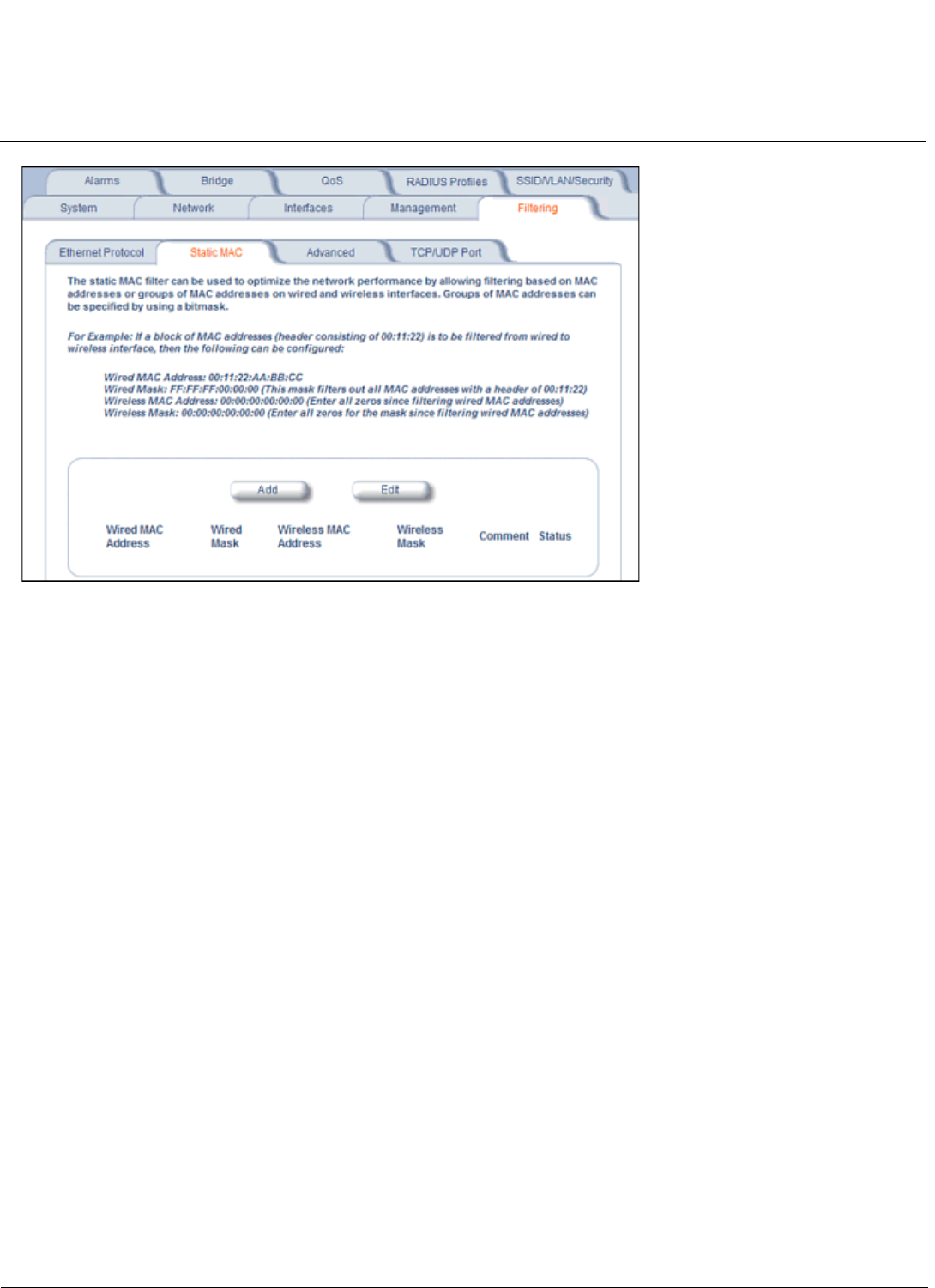
Advanced Configuration AP-700 User Guide
Filtering
75
Figure 4-26 Static MAC Filter Configuration
Each static MAC entry contains the following fields:
•Wired MAC Address
•Wired Mask
•Wireless MAC Address
•Wireless Mask
•Comment: This field is optional.
Each MAC Address or Mask is comprised of 12 hexadecimal digits (0-9, A-F) that correspond to a 48-bit identifier. (Each
hexadecimal digit represents 4 bits (0 or 1).)
Taken together, a MAC Address/Mask pair specifies an address or a range of MAC addresses that the AP will look for
when examining packets. The AP uses Boolean logic to perform an “AND” operation between the MAC Address and the
Mask at the bit level. However, for most users, you do not need to think in terms of bits. It should be sufficient to create a
filter using only the hexadecimal digits 0 and F in the Mask (where 0 is any value and F is the value specified in the MAC
address). A Mask of 00:00:00:00:00:00 corresponds to all MAC addresses, and a Mask of FF:FF:FF:FF:FF:FF applies
only to the specified MAC Address.
For example, if the MAC Address is 00:20:A6:12:54:C3 and the Mask is FF:FF:FF:00:00:00, the AP will examine the
source and destination addresses of each packet looking for any MAC address starting with 00:20:A6. If the Mask is
FF:FF:FF:FF:FF:FF, the AP will only look for the specific MAC address (in this case, 00:20:A6:12:54:C3).
When creating a filter, you can configure the Wired parameters only, the Wireless parameters only, or both sets of
parameters. Which parameters to configure depends upon the traffic that you want block:
• To prevent all traffic from a specific wired MAC address from being forwarded to the wireless network, configure only
the Wired MAC Address and Wired Mask (leave the Wireless MAC Address and Wireless Mask set to all zeros).
• To prevent all traffic from a specific wireless MAC address from being forwarded to the wired network, configure only
the Wireless MAC address and Wireless Mask (leave the Wired MAC Address and Wired Mask set to all zeros).
• To block traffic between a specific wired MAC address and a specific wireless MAC address, configure all four
parameters.
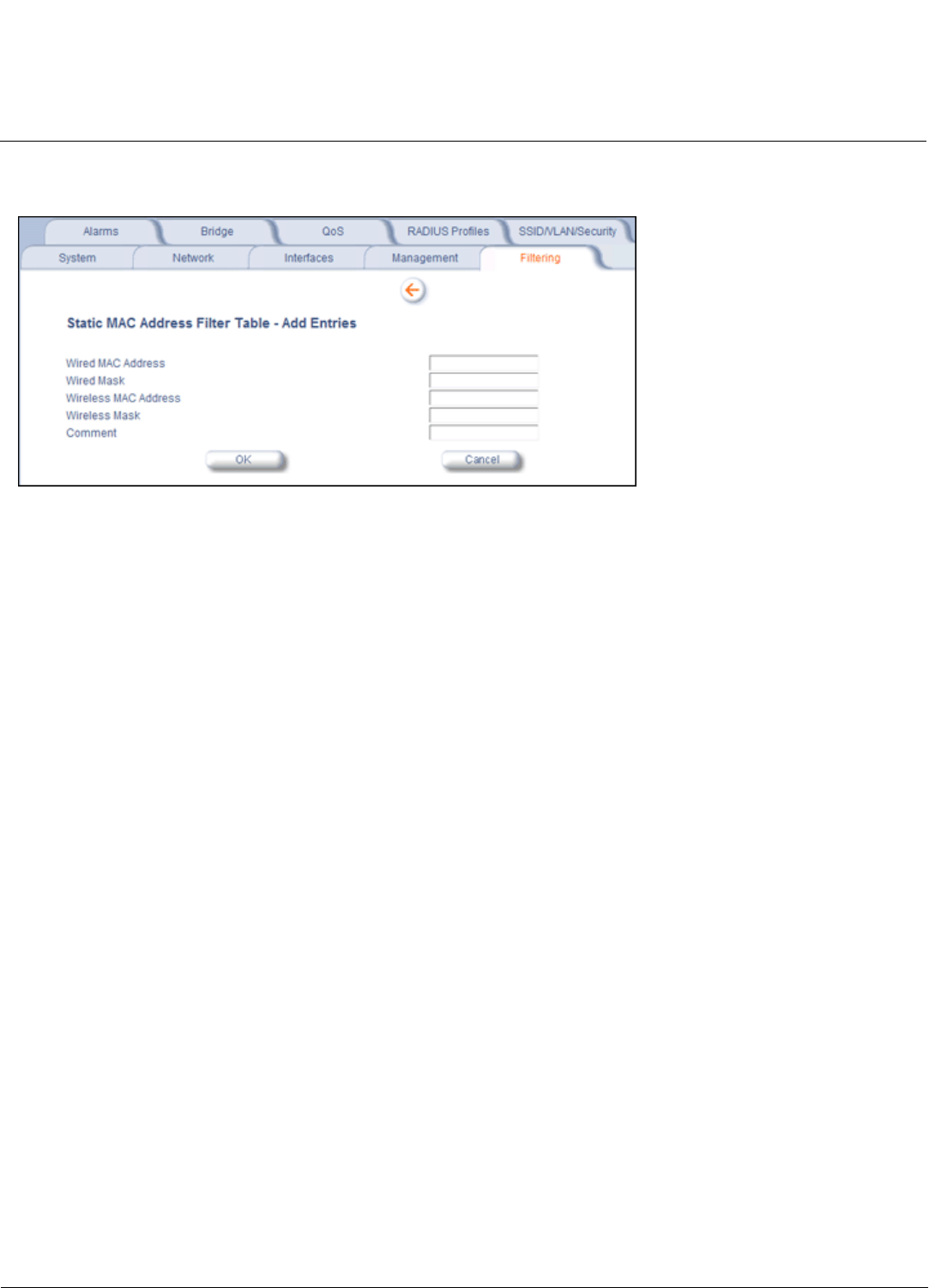
Advanced Configuration AP-700 User Guide
Filtering
76
A maximum of 200 entries can be created in the Static MAC filter table. To create an entry, click Add and enter the
appropriate MAC addresses and Masks to setup a filter. The entry is enabled automatically when saved.
Figure 4-27 Static MAC Filter Table - Add Entries
To edit an entry, click Edit. To disable or remove an entry, click Edit and change the Status field from Enable to Disable
or Delete.
Static MAC Filter Examples
Consider a network that contains a wired server and three wireless clients. The MAC address for each unit is as follows:
• Wired Server: 00:40:F4:1C:DB:6A
• Wireless Client 1: 00:02:2D:51:94:E4
• Wireless Client 2: 00:02:2D:51:32:12
• Wireless Client 3: 00:20:A6:12:4E:38
Prevent Two Specific Devices from Communicating
Configure the following settings to prevent the Wired Server and Wireless Client 1 from communicating:
•Wired MAC Address: 00:40:F4:1C:DB:6A
•Wired Mask: FF:FF:FF:FF:FF:FF
•Wireless MAC Address: 00:02:2D:51:94:E4
•Wireless Mask: FF:FF:FF:FF:FF:FF
Result: Traffic between the Wired Server and Wireless Client 1 is blocked. Wireless Clients 2 and 3 can still communicate
with the Wired Server.
Prevent Multiple Wireless Devices from Communicating with a Single Wired Device
Configure the following settings to prevent Wireless Clients 1 and 2 from communicating with the Wired Server:
•Wired MAC Address: 00:40:F4:1C:DB:6A
•Wired Mask: FF:FF:FF:FF:FF:FF
•Wireless MAC Address: 00:02:2D:51:94:E4
•Wireless Mask: FF:FF:FF:00:00:00
Result: When a logical “AND” is performed on the Wireless MAC Address and Wireless Mask, the result corresponds to
any MAC address beginning with the 00:20:2D prefix. Since Wireless Client 1 and Wireless Client 2 share the same
prefix (00:02:2D), traffic between the Wired Server and Wireless Clients 1 and 2 is blocked. Wireless Client 3 can still
communicate with the Wired Server since it has a different prefix (00:20:A6).

Advanced Configuration AP-700 User Guide
Filtering
77
Prevent All Wireless Devices from Communicating with a Single Wired Device
Configure the following settings to prevent all three Wireless Clients from communicating with Wired Server 1:
•Wired MAC Address: 00:40:F4:1C:DB:6A
•Wired Mask: FF:FF:FF:FF:FF:FF
•Wireless MAC Address: 00:00:00:00:00:00
•Wireless Mask: 00:00:00:00:00:00
Result: The Access Point blocks all traffic between Wired Server 1 and all wireless clients.
Prevent a Wireless Device from Communicating with the Wired Network
Configure the following settings to prevent Wireless Client 3 from communicating with any device on the Ethernet:
•Wired MAC Address: 00:00:00:00:00:00
•Wired Mask: 00:00:00:00:00:00
•Wireless MAC Address: 00:20:A6:12:4E:38
•Wireless Mask: FF:FF:FF:FF:FF:FF
Result: The Access Point blocks all traffic between Wireless Client 3 and the Ethernet network.
Prevent Messages Destined for a Specific Multicast Group from Being Forwarded to the Wireless LAN
If there are devices on your Ethernet network that use multicast packets to communicate and these packets are not
required by your wireless clients, you can set up a Static MAC filter to preserve wireless bandwidth. For example, if
routers on your network use a specific multicast address (such as 01:00:5E:00:32:4B) to exchange information, you can
set up a filter to prevent these multicast packets from being forwarded to the wireless network:
•Wired MAC Address: 01:00:5E:00:32:4B
•Wired Mask: FF:FF:FF:FF:FF:FF
•Wireless MAC Address: 00:00:00:00:00:00
•Wireless Mask: 00:00:00:00:00:00
Result: The Access Point does not forward any packets that have a destination address of 01:00:5E:00:32:4B to the
wireless network.
Advanced
You can configure the following advanced filtering options:
•Enable Proxy ARP: Place a check mark in the box provided to allow the Access Point to respond to Address
Resolution Protocol (ARP) requests for wireless clients. When enabled, the AP answers ARP requests for wireless
stations without actually forwarding them to the wireless network. If disabled, the Access Point will bridge ARP
requests for wireless clients to the wireless LAN.
•Enable IP/ARP Filtering: Place a check mark in the box provided to allow IP/ARP filtering based on the IP/ARP
Filtering Address and IP Mask. Leave the box unchecked to prevent filtering. If enabled, you should also configure the
IP/ARP Filtering Address and IP/ARP IP Mask.
–IP/ARP Filtering Address: Enter the Network filtering IP Address.
–IP/ARP IP Mask: Enter the Network Mask IP Address.
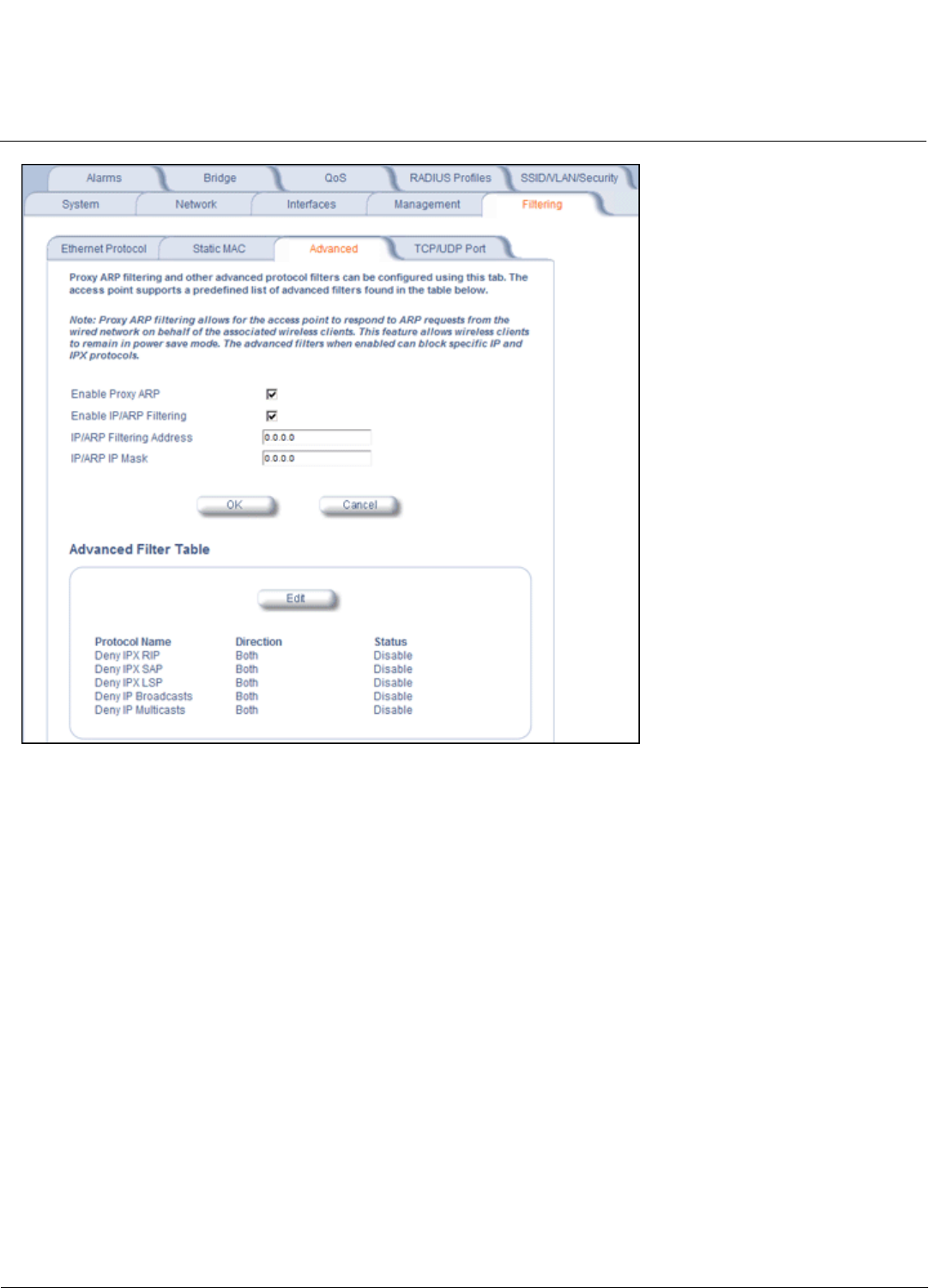
Advanced Configuration AP-700 User Guide
Filtering
78
Figure 4-28 Advanced Filter Configuration
The following protocols are listed in the Advanced Filter Table:
•Deny IPX RIP
•Deny IPX SAP
•Deny IPX LSP
•Deny IP Broadcasts
•Deny IP Multicasts
The AP can filter these protocols in the wireless-to-Ethernet direction, the Ethernet-to-wireless direction, or in both
directions. Click Edit and use the Status field to Enable or Disable the filter.
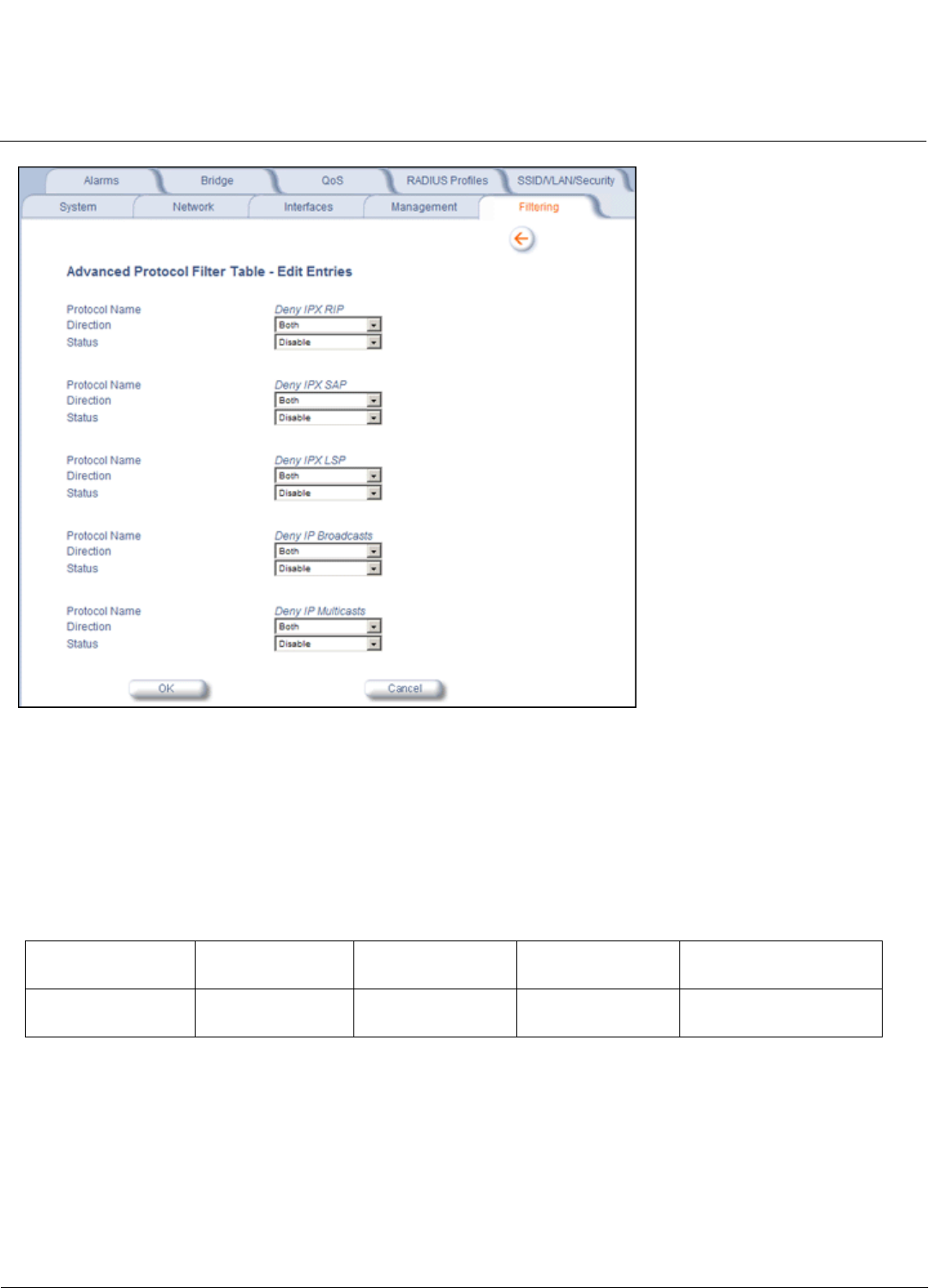
Advanced Configuration AP-700 User Guide
Filtering
79
Figure 4-29 Static MAC Filter Table - Edit Entries
TCP/UDP Port
Port-based filtering enables you to control wireless user access to network services by selectively blocking TCP/UDP
protocols through the AP. A user specifies a Protocol Name, Port Number, Port Type (TCP, UDP, or TCP/UDP), and
filtering interfaces (Wireless only, Ethernet only, a combination of Wireless and Ethernet, or all interfaces) in order to
block access to services, such as Telnet and FTP, and traffic, such as NETBIOS and HTTP.
For example, an AP with the following configuration would discard frames received on its Ethernet interface with a UDP
destination port number of 137, effectively blocking NETBIOS Name Service packets.
Adding TCP/UDP Port Filters
1. Place a check mark in the box labeled Enable TCP/UDP Port Filtering.
Protocol Type
(TCP/UDP)
Destination Port
Number
Protocol Name Interface Status (Enable/Disable)
UDP 137 NETBIOS Name
Service
Ethernet Enable
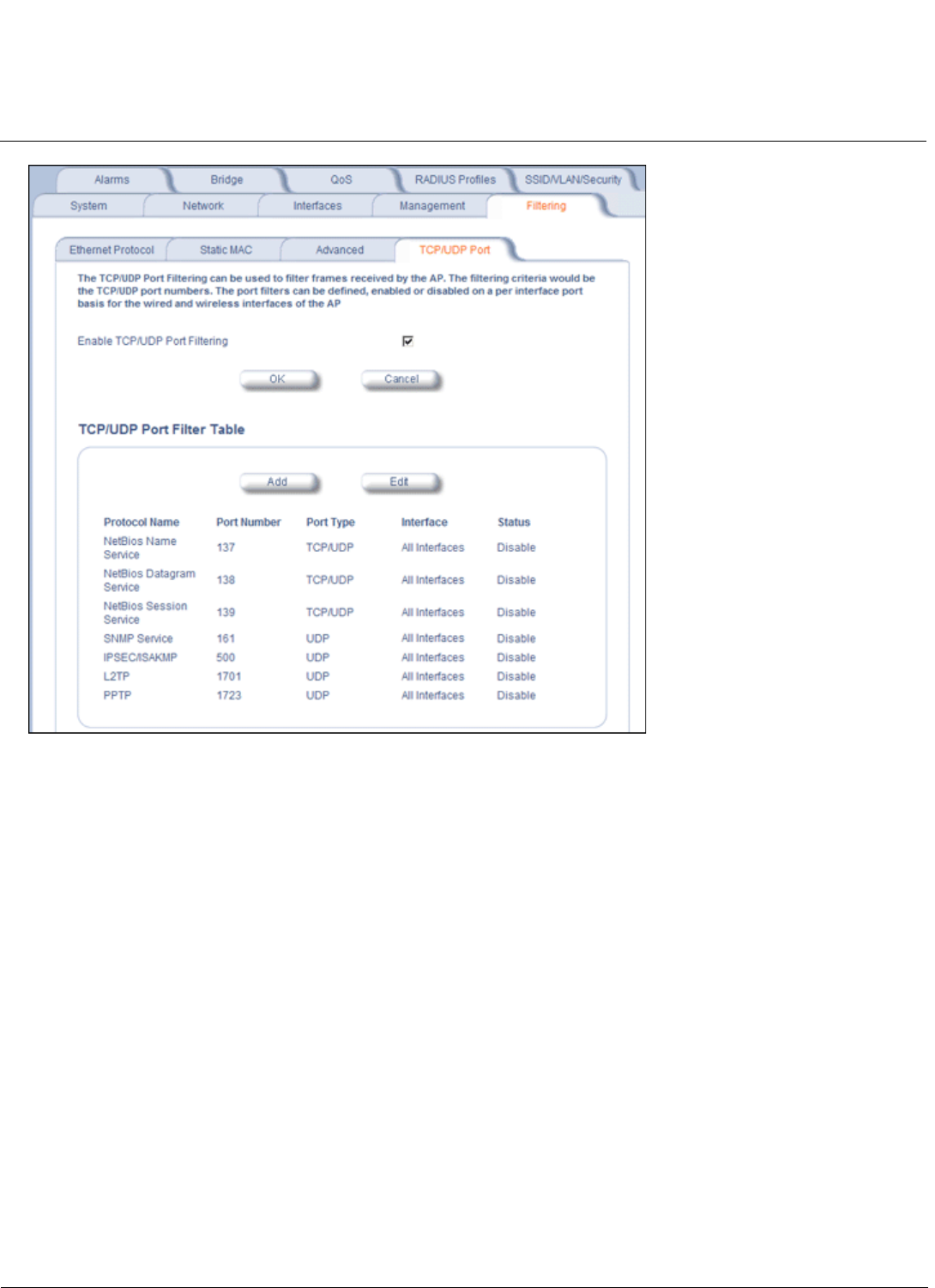
Advanced Configuration AP-700 User Guide
Filtering
80
Figure 4-30 TCP/UDP Port Filter Configuration
2. Click Add under the TCP/UDP Port Filter Table heading.
3. In the TCP/UDP Port Filter Table, enter the Protocol Names to filter.
4. Set the destination Port Number (a value between 1 and 65535) to filter. See the IANA Web site at
http://www.iana.org/assignments/port-numbers for a list of assigned port numbers and their descriptions.
5. Set the Port Type for the protocol: TCP, UDP, or both (TCP/UDP).
6. Set the Interface to filter:
• Only Ethernet
•Only Wireless
• All interfaces
7. Click OK.
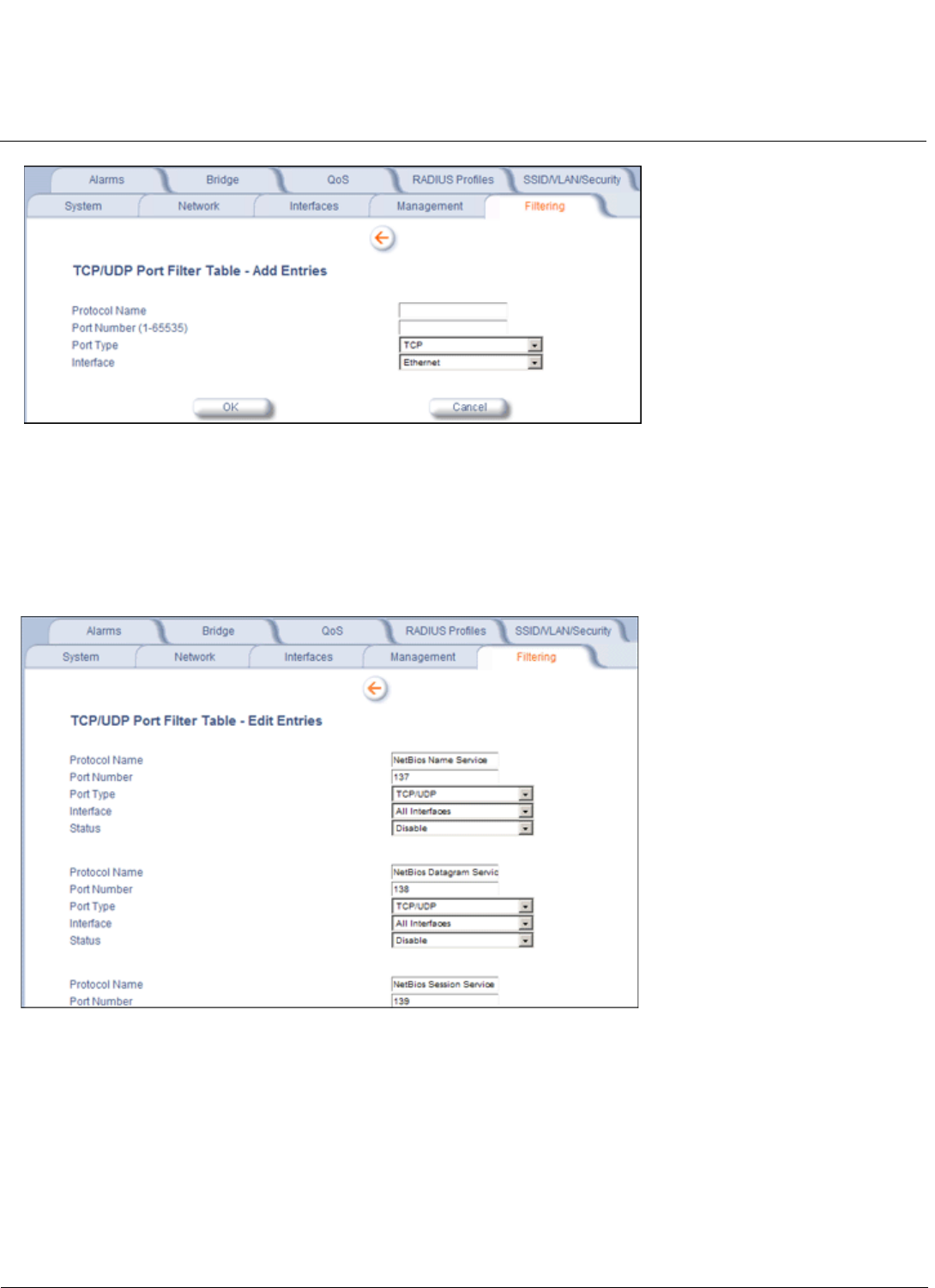
Advanced Configuration AP-700 User Guide
Filtering
81
Figure 4-31 TCP/UDP Port Filter Table - Add Entries
Editing TCP/UDP Port Filters
1. Click Edit under the TCP/UDP Port Filter Table heading.
2. Make any changes to the Protocol Name or Port Number for a specific entry, if necessary.
3. In the row that defines the port, set the Status to Enable, Disable, or Delete, as appropriate.
4. Select OK.
Figure 4-32 TCP/UDP Port Filter Table - Edit Entries

Advanced Configuration AP-700 User Guide
Alarms
82
Alarms
The Alarms tab has the following sub-tabs:
•Groups
•Alarm Host Table
•Syslog
•Rogue Scan
Groups
Alarm groups can be enabled or disabled via the Web interface. Place a check mark in the box provided to enable a
specific group. Remove the check mark from the box to disable the alarms. Alarm severity levels are as follows:
•Critical alarms will often result in severe disruption in network activity or an automatic reboot of the AP.
•Major alarms are usually activated due to a breach in the security of the system. Clients cannot be authenticated
because an attempt at unauthorized access into the AP has been detected.
•Informational alarms provide the network administrator with some general information about the activities the AP is
performing.
Configuration Trap Group
Security Trap Group
Trap Name Description Severity Level
oriTrapDNSIPNotConfigured DNS IP address not configured Major
oriTrapRADIUSAuthenticationNotConfigured RADIUS Authentication not configured Major
oriTrapRADIUSAccountingNotConfigured RADIUS Accounting not configured Major
oriTrapDuplicateIPAddressEncountered Another network device with the same IP address
exists
Major
oriTrapDHCPRelayServerTableNotConfigured The DHCP relay agent server table is empty or
not configured
Major
oriTrapVLANIDInvalidConfiguration A VLAN ID configuration is invalid Major
oriTrapAutoConfigFailure Auto configuration failed Minor
oriTrapBatchExecFailure The CLI Batch execution fails for the following
reasons:
• Illegal Command is parsed in the CLI Batch
file
• Execution error is encountered while
executing CLI Batch file
• Bigger file size than 100 Kbytes
Minor
oriTrapBatchFileExecStart The CLI Batch execution begins after file is
uploaded
Minor
oriTrapBatchFileExecEnd The execution of CLI Batch file ends. Minor
Trap Name Description Severity Level
oriTrapInvalidEncryptionKey Invalid encryption key has been detected. Critical

Advanced Configuration AP-700 User Guide
Alarms
83
Wireless Interface/Card Trap Group
Operational Trap Group
oriTrapAuthenticationFailure Client authentication failure has occurred.
Authentication failures can range from:
• MAC Access Control table
• RADIUS MAC authentication
• 802.1x authentication specifying the
EAP-Type
• WORP mutual authentication
• SSID authorization failure specifying the
SSID
• VLAN ID authorization failure specifying the
VLAN ID
Major
oriTrapUnauthorizedManagerDetected Unauthorized manager has attempted to view
and/or modify parameters
Major
oriTrapRADScanComplete RAD scan is successfully completed Informational
oriTrapRADScanResults Provides information on the RAD Scan results Informational
oriTrapRogueScanStationDetected Rogue station detected Informational
oriTrapRogueScanCycleComplete Rogue scan successfully completed Informational
Trap Name Description Severity Level
oriTrapWLCFailure General failure wireless interface/card failure. Critical
oriTrapWLCRadarInterferenceDetected Radar interference detected on the channel being
used by the wireless interface
Major
MIC Attack Detected Supported in Web interface only Major
MIC Attack Report Detected Supported in Web interface only Major
Trap Name Description Severity Level
oriTrapUnrecoverableSoftwareErrorDetected Unrecoverable software error detected. Causes
software watch dog timer to expire, which in turn
causes the device to reboot.
Critical
oriTrapRADIUSServerNotResponding RADIUS server not responding to authentication
requests sent from the RADIUS client in the
device
Major
oriTrapModuleNotInitialized Module (hardware or software) not initialized Major
oriTrapDeviceRebooting Device rebooting Informational
oriTrapTaskSuspended Task suspended Critical
oriTrapBootPFailed Response to the BootP request not received;
device not dynamically assigned an IP address
Major
Trap Name Description Severity Level

Advanced Configuration AP-700 User Guide
Alarms
84
Flash Memory Trap Group
TFTP Trap Group
Image Trap Group
oriTrapDHCPFailed Response to the DHCP client request not
received; device not dynamically assigned an IP
address
Major
oriTrapDNSClientLookupFailure DNS client attempts to resolve a specified
hostname (DNS lookup) and a failure occurs
because either the DNS server is unreachable or
there is an error for the hostname lookup. Trap
specifies the hostname that was being resolved.
Major
oriTrapSSLInitializationFailure SSL initialization failure Major
oriTrapWirelessServiceShutdown Wireless interface has shutdown services for
wireless clients
Informational
oriTrapWirelessServiceResumed Wireless interface has resumed service and is
ready for wireless client connections
Informational
oriTrapSSHInitializationStatus SSH initialization status Major
oriTrapVLANIDUserAssignment User is assigned a VLAN ID from the RADIUS
server
Informational
oriTrapDHCPLeaseRenewal AP requests DHCP renewal and receives new
information from the DHCP server. Information
includes the DHCP server IP address that replied
to the DHCP client request, and the IP address,
subnet mask, and gateway IP address returned
from the DHCP server.
Informational
oriTrapTemperatureAlert Temperature is above or below acceptable
operating margin.
Critical
Temperature is within 5°C of upper or lower limit. Major
Trap Name Description Severity Level
oriTrapFlashMemoryEmpty No data present in flash memory Informational
Flash Memory Corrupted Flash memory corrupted Critical
oriTrapFlashMemoryRestoringLastKnownGoo
dConfiguration
Current/original configuration data file is found to
be corrupted, and the device loads the last known
good configuration file
Informational
Trap Name Description Severity Level
oriTrapTFTPFailedOperation TFTP operation failed Major
oriTrapTFTPOperationInitiated TFTP operation Initiated Informational
oriTrapTFTPOperationCompleted TFTP operation completed Informational
Trap Name Description Severity Level
oriTrapZeroSizeImage Zero size image loaded onto device Major
Trap Name Description Severity Level

Advanced Configuration AP-700 User Guide
Alarms
85
SNTP Trap Group
In addition, the AP supports these standard traps, which are always enabled:
RFC 1215-Trap
Bridge MIB (RFC 1493) Alarms
All these alarm groups correspond to System Alarms that are displayed in the System Status Screen, including the traps
that are sent by the AP to the SNMP managers specified in the Alarm Host Table.
Alarm Host Table
To add an entry and enable the AP to send SNMP trap messages to a Trap Host, click Add, and then specify the IP
Address and Password for the Trap Host.
NOTE: Up to 10 entries are possible in the Alarm Host table.
•IP Address: Enter the Trap Host IP Address.
•Password: Enter the password in the Password field and the Confirm field.
•Comment: Enter an optional comment, such as the alarm (trap) host station name.
To edit or delete an entry, click Edit. Edit the information, or select Enable, Disable, or Delete from the Status
drop-down menu.
oriTrapInvalidImage Invalid image loaded onto device Major
oriTrapImageTooLarge Image loaded on the device exceeds the size
limitation of flash
Major
oriTrapIncompatibleImage Incompatible image loaded onto device Major
oriTrapInvalidImageDigitalSignature Image with invalid digital signature is loaded onto
device
Major
Trap Name Description Severity Level
oriTrapSNTPFailure SNTP time retrieval failure Minor
oriTrapSNTPFailure SNTP sync-up failure Minor
Trap Name Description Severity Level
coldStart AP is on or rebooted Informational
linkUp AP's Ethernet interface link is up (working) Informational
linkDown AP's Ethernet interface link is down (not working) Informational
Trap Name Description Severity Level
New Root AP has become the new root in the Spanning
Tree network
Informational
topologyChange Trap is not sent if a newRoot trap is sent for the
same transition
Informational
Trap Name Description Severity Level
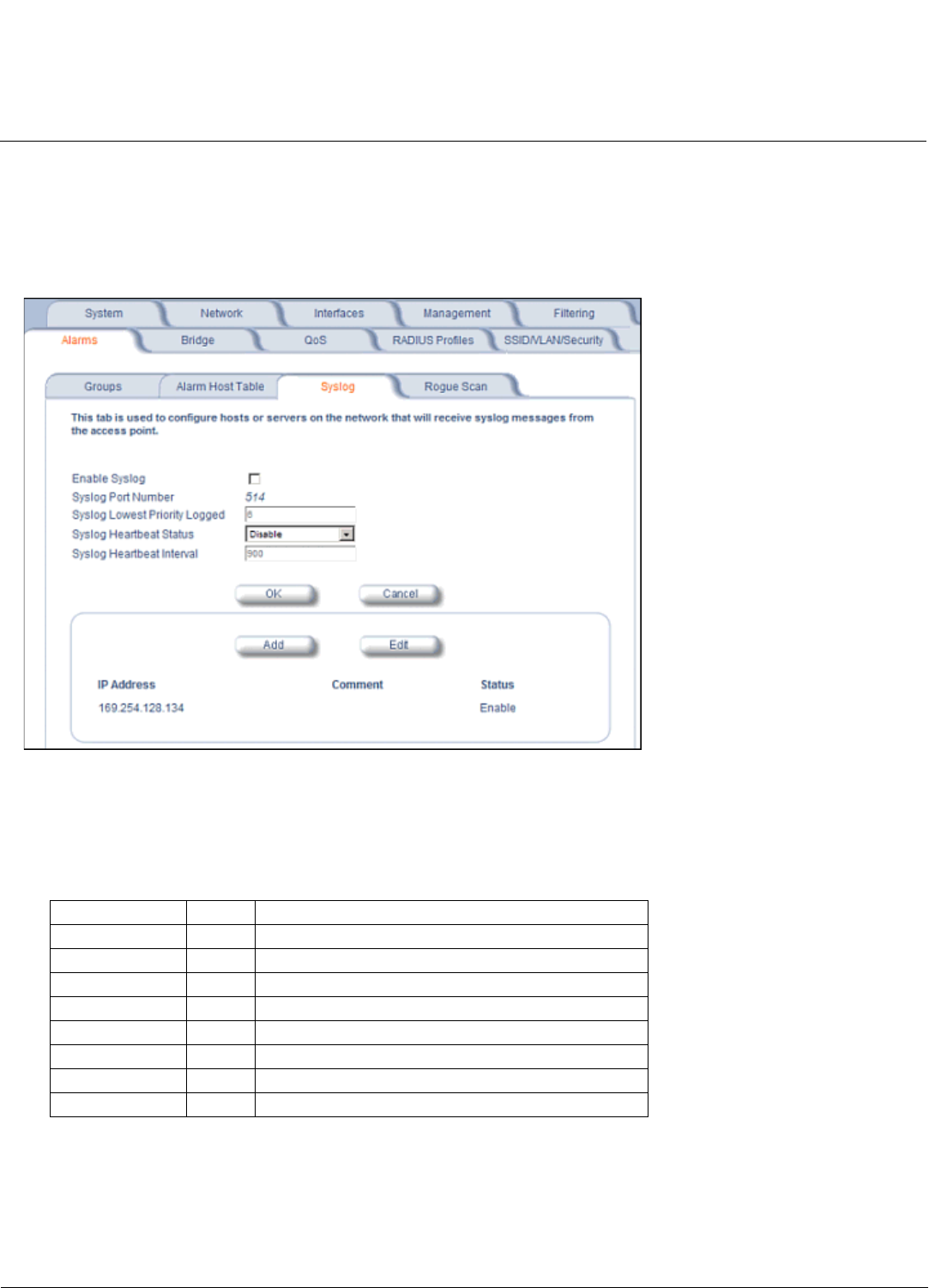
Advanced Configuration AP-700 User Guide
Alarms
86
Syslog
The Syslog messaging system enables the AP to transmit event messages to a central server for monitoring and
troubleshooting. The access point logs “Session Start (Log-in)” and “Session Stop (Log-out)” events for each wireless
client as an alternative to RADIUS accounting.
See RFC 3164 at http://www.rfc-editor.org for more information on the Syslog standard.
Figure 4-33 Syslog Configuration Screen
Setting Syslog Event Notifications
Syslog Events are logged according to the level of detail specified by the administrator. Logging only urgent system
messages will create a far smaller, more easily read log than a log of every event the system encounters. Determine
which events to log by selecting a priority defined by the following scale:
Configuring Syslog Event Notifications
You can configure the following Syslog settings from the HTTP interface:
•Enable Syslog: Place a check mark in the box provided to enable system logging.
•Syslog Port Number: This field is read-only and displays the port number (514) assigned for system logging.
Event Priority Description
LOG_EMERG 0 System is unusable
LOG_ALERT 1 Action must be taken immediately
LOG_CRIT 2 Critical conditions
LOG_ERR 3 Error conditions
LOG_WARNING 4 Warning conditions
LOG_NOTICE 5 Normal but significant condition
LOG_INFO 6 Informational
LOG_DEBUG 7 Debug-level messages

Advanced Configuration AP-700 User Guide
Alarms
87
•Syslog Lowest Priority Logged: The AP will send event messages to the Syslog server that correspond to the
selected priority number and any priority numbers below it. For example, if set to 6, the AP will transmit event
messages labeled priority 1 to 6 to the Syslog server. This parameter supports a range between 1 and 7; 6 is the
default.
•Syslog Heartbeat Status: When Heartbeat is enabled, the AP periodically sends a message to the Syslog server to
indicate that it is active.
•Syslog Heartbeat Interval: If Syslog Heartbeat Status is enabled this field provides the interval for the heartbeat in
seconds (between 1 and 604800). The default is 900 seconds.
•Syslog Host Table: This table specifies the IP addresses of a network servers that the AP will send Syslog messages
to. Click Add to create a new entry. Click Edit to change an existing entry. Each entry contains the following field:
–IP Address: Enter the IP Address for the management host.
–Comment: Enter an optional comment such as the host name.
–Status: The entry is enabled automatically when saved (so the Status field is only visible when editing an entry).
You can also disable or delete entries by changing this field’s value.
Syslog Messages
The following messages are supported in the AP:
Syslog Message Name Priority Severity Description
Auto Configuration using DHCP 6 Informational Configuration filename and TFTP server address
are obtained from DHCP when dynamic IP is
configured on the device.
Auto Configuration using Static IP 6 Informational Configured TFTP server address and configuration
filename is used when Static IP is configured on
the device.
TFTP Server IP and configuration
filename not present in DHCP
response
4 Minor Configuration filename and/or TFTP server
address is not present in the DHCP response when
using DHCP.
TFTP Server IP Address used in
AutoConfig feature
6 Informational TFTP server IP address used for AutoConfig.
TFTP Server filename used in
AutoConfig feature
6 Informational TFTP filename used for AutoConfig.
Auto Configuration TFTP
Download Failure
4 Minor TFTP download of a configuration file for
AutoConfig fails for the following reasons:
• Incorrect or non-reachable TFTP server
address
• Incorrect or unavailable configuration
filename
• TFTP transfer timeout.
Image Compatibility Check,
Invalid Image
2 Major One of the following failures occurs:
• Invalid Signature
• Zero File Size
• Large File
• Non VxWork Image
• Incompatible Image
AP Heartbeat Status 5 Informational AP syslog keep alive message.

Advanced Configuration AP-700 User Guide
Alarms
88
Client Login Authentication
Status
6 Informational Client logs in/authenticates. Message includes:
• Client MAC Address
• Authentication Type = None, ACL, RADIUS
MAC, 802.1X
• Cipher Type = None, WEP, TKIP, AES
• Status = Allow, Deny
• SSID to which client is connecting
Sample Message:
<client mac address> | Status = <value> | SSID =
<value> | Auth Type = <value> | Cipher Type =
<value>
Client De-Authentication Status 6 Informational Client de-authenticates. Message includes:
• Client MAC Address
• Cipher Type = None, WEP, TKIP, AES
• Status = De-authentication reason, which can
be any of the following:
– Unknown reason
– Stale authentication information
– Authenticated STA leaving BSS
– Inactivity
– Association error
– Class 2 frame received from
non-authenticated STA
– Class 3 frame received from
non-associated STA
– Associated STA leaving BSS
– STA requesting information, but not yet
authenticated
– Enhanced security (RSN) required
– Enhanced security (RSN) used
inconsistently
– Invalid Information Element
– MIC Failure
– WPA module de-auth
• SSID to which client was connected
Sample Message:
<client mac address> | Status = <value> | SSID =
<value> | Cipher Type = <value>
RADIUS Accounting Start and
Stop Messages
6 Informational Start and Stop accounting messages for wireless
clients.
CLI Configuration File Start
Execution
6 Informational CLI configuration file execution starts.
CLI Configuration File End
Execution
6 Informational CLI configuration file execution ends.
Syslog Message Name Priority Severity Description

Advanced Configuration AP-700 User Guide
Alarms
89
Rogue Scan
The Rogue Scan feature provides an additional security level for wireless LAN deployments. Rogue Scan uses the
selected wireless interface(s) for scanning its coverage area for Access Points and clients.
A centralized Network Manager receives MAC address information from the AP on all wireless clients detected by the AP.
The Network Manager then queries all wired switches to find out the inbound switch/port of these wireless clients. If the
switch/port does not have a valid Access Point connected to it as per a pre-configured database, the Network Manager
proceeds to block that switch/port and prevent the Rogue AP from connecting to the wired network.
Figure 4-34 Preventing Rogue AP Attacks
The figure above shows Client 1 connected to a Trusted AP and Client 2 connected to a Rogue AP. The Trusted AP
scans the networks, detects Client 2, and notifies the Network Manager. The Network Manager uses SNMP/CLI to query
the wired switch to find the inbound switch port of Client 2’s packets. The Network Manager verifies that this switch/router
CLI Configuration File Execution
Errors
4 Minor There is an error in execution of the CLI
configuration file. The message specifies the
filename, line number, and error reason.
SSH Initialization Failure 3 Major One of the following failures occurs:
Keys not present
Keys cannot be generated
Internal error (no available resources)
SSH Key Generation Successful 6 Informational SSH Key generation is successful.
Wireless Service Shutdown 6 Informational Wireless service is shutdown.
Wireless Service Resume 6 Informational Wireless service resumes.
MIC Attack Occurred 4 Minor MIC attack occurred; wireless interface is shut
down for 60 seconds
MIC Attack from Wireless Station 4 Minor A MIC attack is detected from a wireless station.
SNTP Time Retrieval Failure 4 Minor SNTP Client in the AP fails to retrieve time
information from the configured SNTP servers.
Also included in message: IP Address of SNTP
server.
SNTP Time Sync-Up Failure 4 Minor SNTP Client in the AP fails to synchronize the time
with the SNTP server it was communicating with.
Also included in message: IP Address of SNTP
server.
Syslog Message Name Priority Severity Description

Advanced Configuration AP-700 User Guide
Alarms
90
and port does not have a valid Access Point as per the administrator’s database. Thus it labels Client 2’s AP as a Rogue
AP and proceeds to prevent the Rogue AP attack by blocking this switch’s port.
APs can be detected either by active scanning using 802.11 probe request frames or passively by detecting periodic
beacons, or both. Wireless clients are detected by monitoring 802.11 connection establishment messages such as
association/authentication messages or data traffic to or from the wireless clients.
There are two scanning modes available per wireless interface: continuous scanning mode and background scanning
mode.
Continuous Scanning Mode
The continuous scanning mode is a dedicated scanning mode where the wireless interface performs scanning alone and
does not perform the normal AP operation of servicing client traffic.
In continuous scanning mode the AP scans each channel for a channel scan time of one second and then moves to the
next channel in the scan channel list. With a channel scan time of one second, the scan cycle time will take less than a
minute (one second per channel). Once the entire scan channel list has been scanned the AP restarts scanning from the
beginning of the scan channel list.
Background Scanning Mode
In background scanning mode the AP performs background scanning while performing normal AP operations on the
wireless interface.
You can configure the scan cycle time between 1-1440 minutes (24 hours). The scan cycle time indicates how
frequently a channel is sampled and defines the minimum attack period that can go unnoticed.
In background scanning mode the AP will scan one channel then wait for a time known as channel scan time. The
channel scan time affects the amount of data collected during scanning and defines the maximum number of samples
(possible detections) in one scan. This is increased to improve scanning efficiency; the tradeoff is that it decreases
throughput. The optimum value for this parameter during background scanning mode is 20ms.The channel scan time is
calculated from the scan cycle time parameter and the number of channels in the scan channel list as follows:
intra-channel scan time = (scan cycle time - (channel scan time * number of channels in the scan list))/number of
channels in the scan list.
Rogue Scan Data Collection
The AP stores information gathered about detected stations during scanning in a Rogue Scan result table. The Rogue
Scan result table can store a maximum of 2000 entries. When the table fills, the oldest entry gets overwritten. The Rogue
Scan result table lists the following information about each detected station:
• Station Type: indicates one of the following types of station:
– Unknown station
– AP station
– Infrastructure Client Station
– IBSS Client Station
• MAC Address of the detected station
• Channel: the working channel of the detected station
• SNR: the SNR value of the last frame from the station as received by the AP
• BSSID: the BSSID field stores the:
– MAC address of the associated Access Point in the case of a client.
– Zero MAC address or MAC address of the partner Access Point if the AP is a partner of a WDS link
The AP ages out older entries in the Rogue Scan result table if a detected station is inactive for more than the Scan
Result Table Ageing Time.

Advanced Configuration AP-700 User Guide
Alarms
91
Rogue Scan
Perform this procedure to enable Rogue Scan and define the Scan Interval and Scan Interface. See Figure 4-35.
The Rogue Scan screen also displays the number of new access points and clients detected in the last scan on each
wireless interface.
1. Enable the Security Alarm Group. Select the Security Alarm Group link from the Rogue Scan screen. Configure a
Trap Host to receive the list of access points (and clients) detected during the scan.
2. Click Configure > Alarms > Rogue Scan.
3. Enable Rogue Scan by checking Enable Rogue Scan.
NOTE: Rogue Scan cannot be enabled on a wireless interface when the Wireless Service Status on that interface is
shutdown. First, resume service on the wireless interface.
NOTE: Enabling Rogue Scan simultaneously with Broadcast Unique Beacon will cause a drift in the beacon interval
and the occasional missing of beacons.
4. Enter the Scan Mode. Select Background Scanning or Continuous Scanning. In Continuous Scanning mode the AP
stops normal operation and scans continuously on that interface. In Background Scanning mode, the AP performs
background scanning while doing normal AP operation on that interface.
5. If the Scan Mode is Background Scanning, then enter the Scan Interval.
• The Scan Interval specifies the time period in minutes between scans in Background Scanning mode and can be
set to any value between 1 and 1440 minutes.
6. Configure the Scan Result Table Ageing Time. The AP ages out older entries in the Rogue Scan result table if a
detected station is inactive for more than this time. The valid range is from 60-7200 minutes, the default is 60 minutes.
7. Configure the Scan Results Trap Notification Mode to control the notification behavior when APs or stations are
detected in a scan:
• No Notification
•Notify AP
• Notify Client
• Notify All (Notify both AP and Client detection)
8. Configure the Scan Results Trap Report Style to control the way detected stations are reported in the notification:
• Report all detected stations since last scan (default)
• Report all detected stations since start of scan
9. Click OK.
The results of the Rogue Scan can be viewed in the Status page in the HTTP interface.
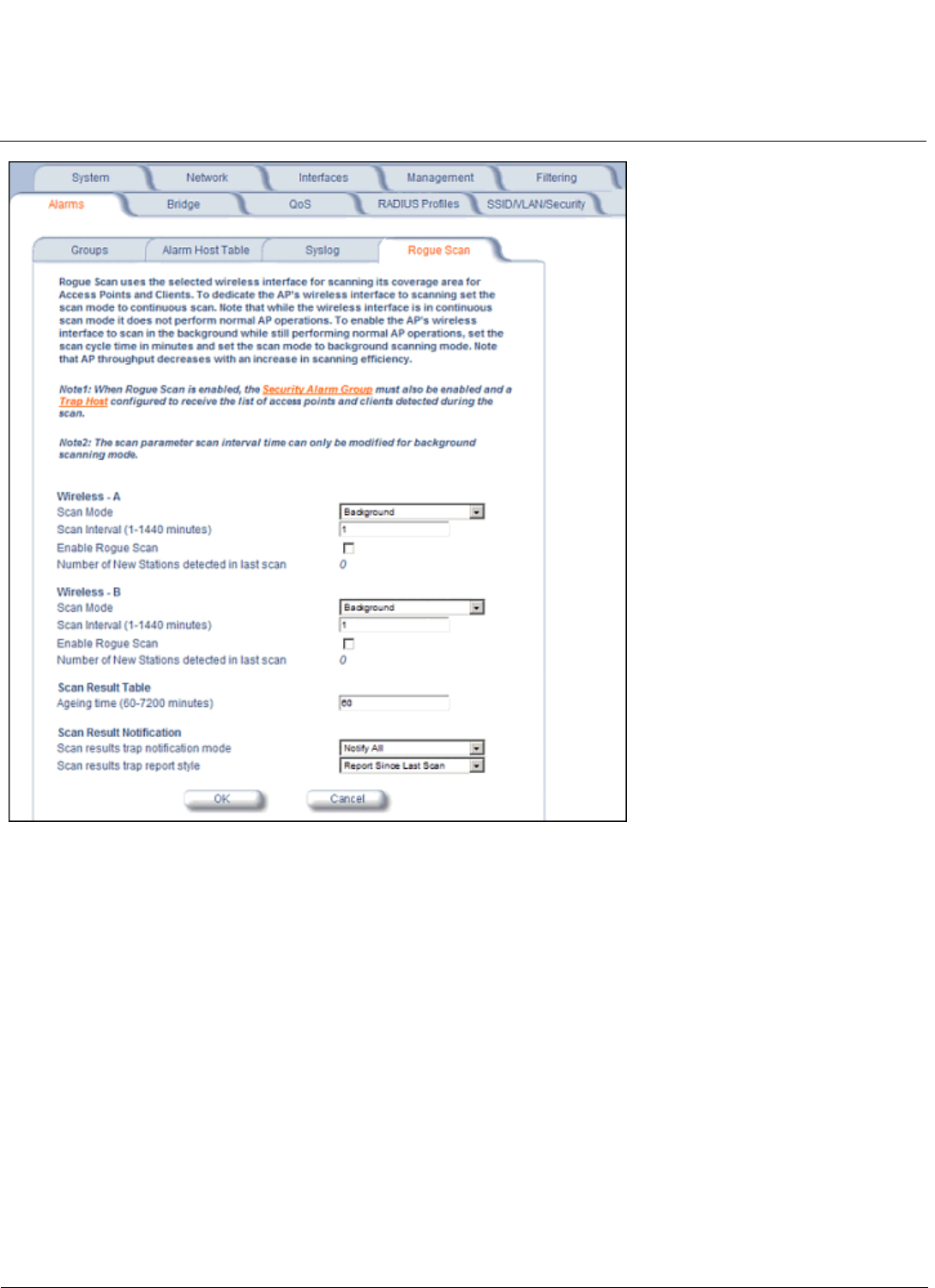
Advanced Configuration AP-700 User Guide
Alarms
92
Figure 4-35 Rogue Scan Screen

Advanced Configuration AP-700 User Guide
Bridge
93
Bridge
The AP is a bridge between your wired and wireless networking devices. As a bridge, the functions performed by the AP
include:
• MAC address learning
• Forward and filtering decision making
• Spanning Tree protocol used for loop avoidance
Once the AP is connected to your network, it learns which devices are connected to it and records their MAC addresses
in the Learn Table. The table can hold up to 10,000 entries. To view the Learn Table, click on the Monitor button in the
web interface and select the Learn Table tab.
The Bridge tab has four sub-tabs:
•Spanning Tree
•Intra BSS
•Packet Forwarding
Spanning Tree
A Spanning Tree is used to avoid redundant communication loops in networks with multiple bridging devices. Bridges do
not have any inherent mechanism to avoid loops, because having redundant systems is a necessity in certain networks.
However, redundant systems can cause Broadcast Storms, multiple frame copies, and MAC address table instability
problems.
Complex network structures can create multiple loops within a network. The Spanning Tree configuration blocks certain
ports on AP devices to control the path of communication within the network, avoiding loops and following a spanning
tree structure.
For more information on Spanning Tree protocol, please see Section 8.0 of the IEEE 802.1d standard. The Spanning
Tree configuration options are advanced settings. Proxim recommends that you leave these parameters at their default
values unless you are familiar with the Spanning Tree protocol.
NOTE: Spanning Tree protocol is disabled by default. When WDS is enabled, Spanning Tree protocol is automatically
enabled. It may be manually disabled. If Spanning Tree protocol is enabled by WDS and WDS is subsequently
disabled, Spanning tree will remain enabled until it is manually disabled.
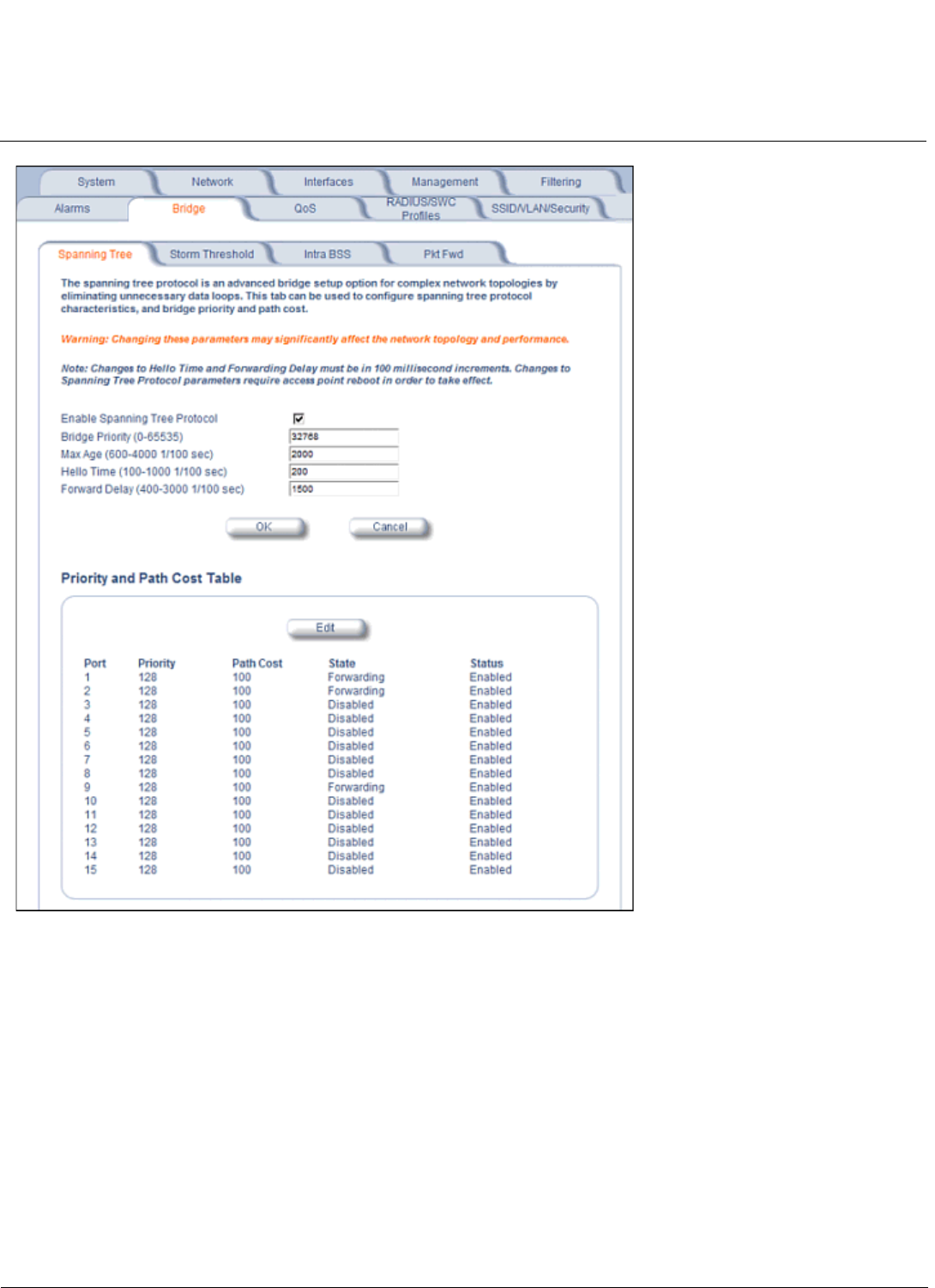
Advanced Configuration AP-700 User Guide
Bridge
94
Figure 4-36 Spanning Tree Sub-Tab
Storm Threshold
Storm Threshold is an advanced Bridge setup option that you can use to protect the network against data overload by:
• Specifying a maximum number of frames per second as received from a single network device (identified by its MAC
address).
• Specifying an absolute maximum number of messages per interface.
The Storm Threshold parameters allow you to specify a set of thresholds for each interface of the AP, identifying separate
values for the number of broadcast messages/second and Multicast messages/second.
When the number of frames for an interface or from a single network device exceeds the maximum value per second, the
AP will ignore all subsequent messages in that second received on that interface or from that network device.
•Address Threshold: Enter the maximum allowed number of packets per second.
•Ethernet Threshold: Enter the maximum allowed number of packets per second.

Advanced Configuration AP-700 User Guide
Bridge
95
•Wireless Threshold: Enter the maximum allowed number of packets per second.
Intra BSS
The wireless clients (or subscribers) that associate with a certain AP form the Basic Service Set (BSS) of a network
infrastructure. By default, wireless subscribers in the same BSS can communicate with each other. However, some
administrators (such as wireless public spaces) may wish to block traffic between wireless subscribers that are
associated with the same AP to prevent unauthorized communication and to conserve bandwidth. This feature enables
you to prevent wireless subscribers within a BSS from exchanging traffic.
Although this feature is generally enabled in public access environments, Enterprise LAN administrators use it to
conserve wireless bandwidth by limiting communication between wireless clients. For example, this feature prevents
peer-to-peer file sharing or gaming over the wireless network.
To block Intra BSS traffic, set Intra BSS Traffic Operation to Block.
To allow Intra BSS traffic, set Intra BSS Traffic Operation to Passthru.
Packet Forwarding
The Packet Forwarding feature enables you to redirect traffic generated by wireless clients that are all associated to the
same AP to a single MAC address. This filters wireless traffic without burdening the AP and provides additional security
by limiting potential destinations or by routing the traffic directly to a firewall. You can redirect to a specific port (Ethernet
or WDS) or allow the bridge’s learning process (and the forwarding table entry for the selected MAC address) to
determine the optimal port.
NOTE: The gateway to which traffic will be redirected should be node on the Ethernet network. It should not be a
wireless client.
Configuring Interfaces for Packet Forwarding
Configure your AP to forward packets by specifying port(s) to which packets are redirected and a destination MAC
address.
1. Within the Packet Forwarding Configuration screen, check the box labeled Enable Packet Forwarding.
2. Specify a destination Packet Forwarding MAC Address. The AP will redirect all unicast, multicast, and broadcast
packets received from wireless clients to the address you specify.
3. Select a Packet Forwarding Interface Port from the drop-down menu. You can redirect traffic to:
– Ethernet
– A WDS connection (see Wireless Distribution System (WDS) for details)
– Any (traffic is redirected to a port based on the bridge learning process)
4. Click OK to save your changes.
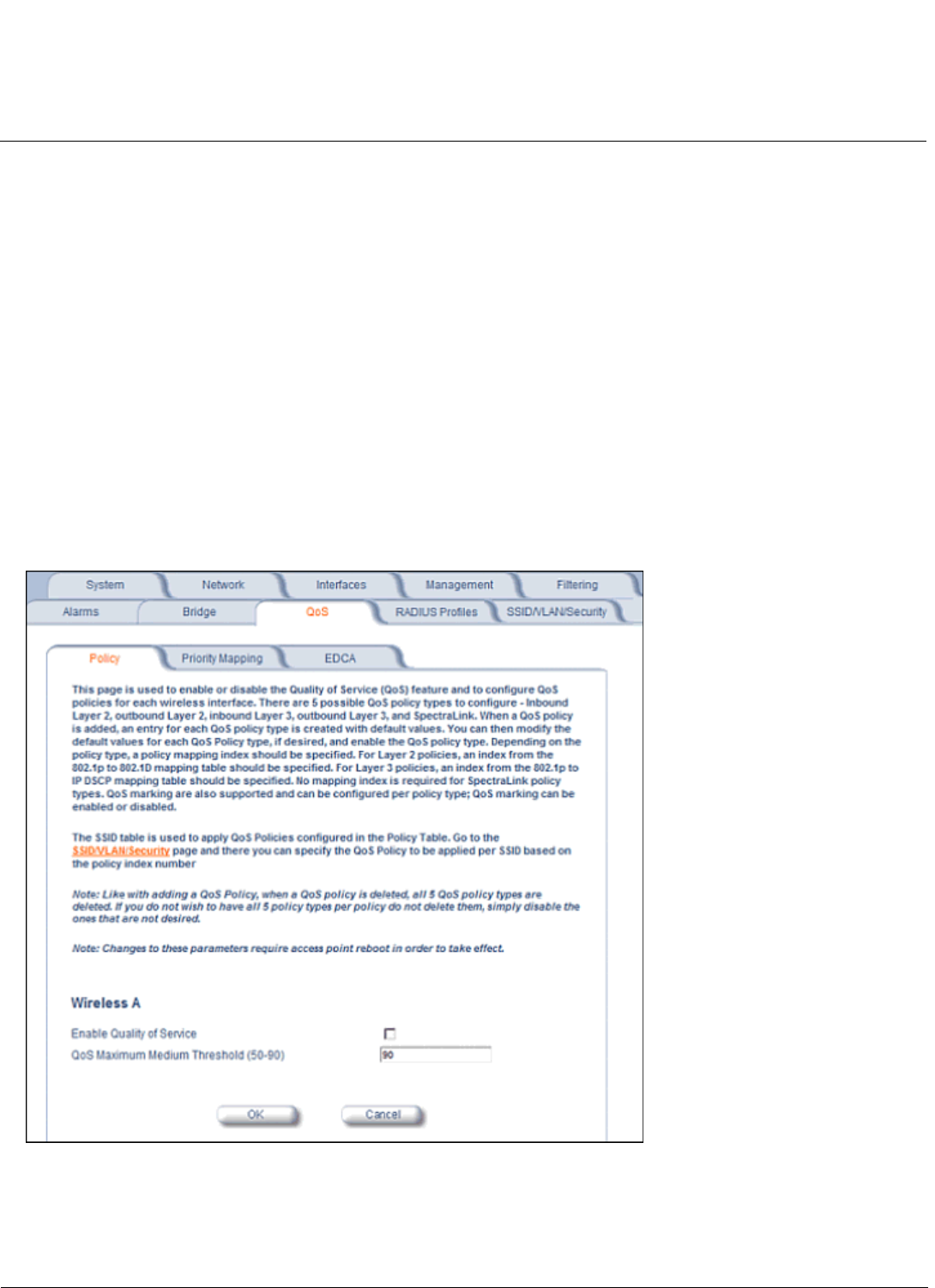
Advanced Configuration AP-700 User Guide
QoS
96
QoS
Wi-Fi Multimedia (WMM)/Quality of Service (QoS) Introduction
The AP supports Wi-Fi Multimedia (WMM), which is a solution for QoS functionality based on the IEEE 802.11e
specification. WMM defines enhancements to the MAC for wireless LAN applications with Quality of Service
requirements, which include transport of voice traffic over IEEE 802.11 wireless LANs.
The enhancement are in the form of changes in protocol frame formats (addition of new fields and information elements),
addition of new messages, definition of new protocol actions, channel access mechanisms (differentiated control of
access to medium) and network elements (QoS/WME aware APs, STAs), and configuration management.
WME supports Enhanced Distributed Channel Access (EDCA) for prioritized QoS services. The WME/QoS feature can
be enabled or disabled per wireless interface. For more information on QoS, see “Technical Bulletin 69504 Revision 2” at
<http://keygen.proxim.com/support/orinoco/tb/tb69504_3wmm.pdf>.
Policy
Perform the following procedure to enable QoS and add QoS policies:
1. Click Configure > QoS > Policy.
Figure 4-37 QoS Policy Sub-Tab
2. To enable QoS, check the Enable Quality of Service checkbox.
3. Configure the QoS Maximum Medium Threshold for all Admission Controls. Admission will be granted if the new
requested traffic stream and already admitted time is less than the medium maximum threshold.
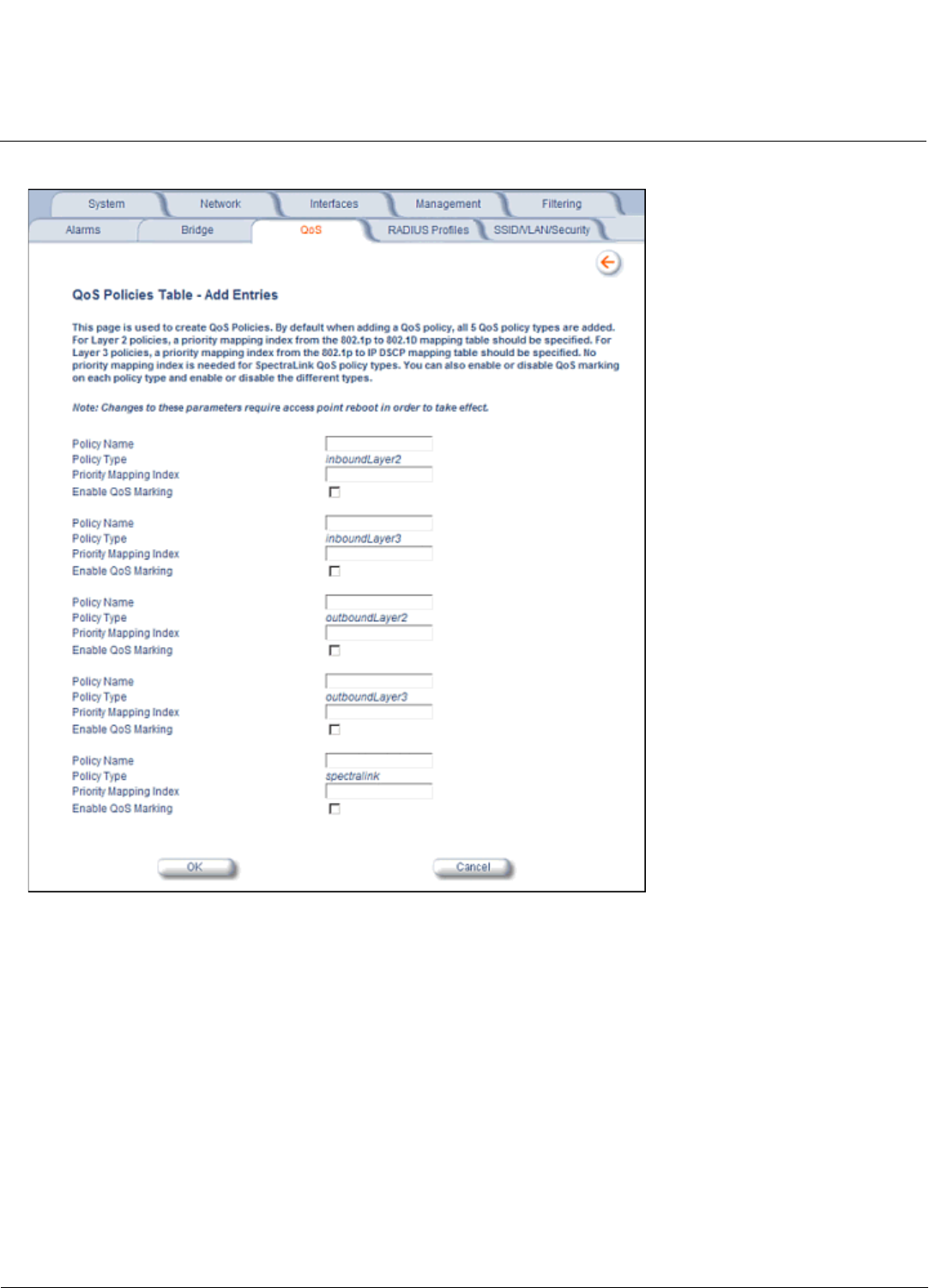
Advanced Configuration AP-700 User Guide
QoS
97
4. To add a QoS Policy, click the Add button in the “QoS Policies Table” box. The Add Entries box appears.
Figure 4-38 Add QoS Policy
5. Enter the Policy Name.
6. Select the Policy Type:
•inlayer2: inbound traffic direction, Layer 2 traffic type
•inlayer3: inbound traffic direction, Layer 3 traffic type
•outlayer2: outbound traffic direction, Layer 2 traffic type
•outlayer3: inbound traffic direction, Layer 3 traffic type
•spectralink: SpectraLink traffic
7. Enter the Priority Mapping Index.
For layer 2 policies, an index from the 802.1p to 802.1d mapping table should be specified. For layer 3 policies, an
index from the 802.1p to IP DSCP mapping table should be specified. No mapping index is required for SpectraLink.
8. Select whether to Enable QoS Marking.
9. Click OK.
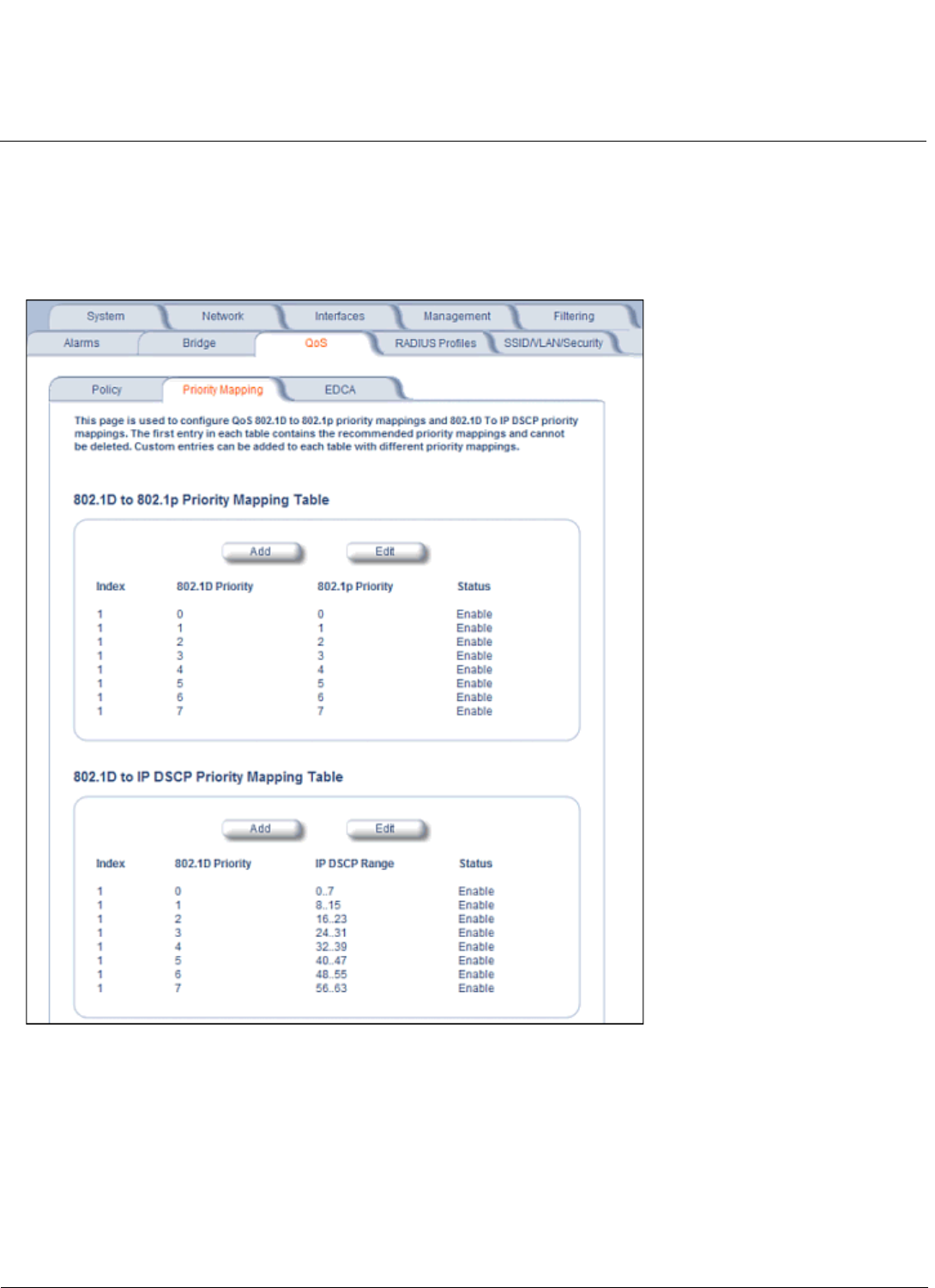
Advanced Configuration AP-700 User Guide
QoS
98
Priority Mapping
Use this page to configure QoS 802.1p to 802.1d priority mappings (for layer 2 policies) and IP DSCP to 802.1d priority
mappings (for layer 3 policies). The first entry in each table contains the recommended priority mappings. Custom entries
can be added to each table with different priority mappings.
1. Click Configure > QoS > Priority Mapping.
Figure 4-39 Priority Mapping
2. Click Add in the 802.1p and 802.1d priority mapping table.
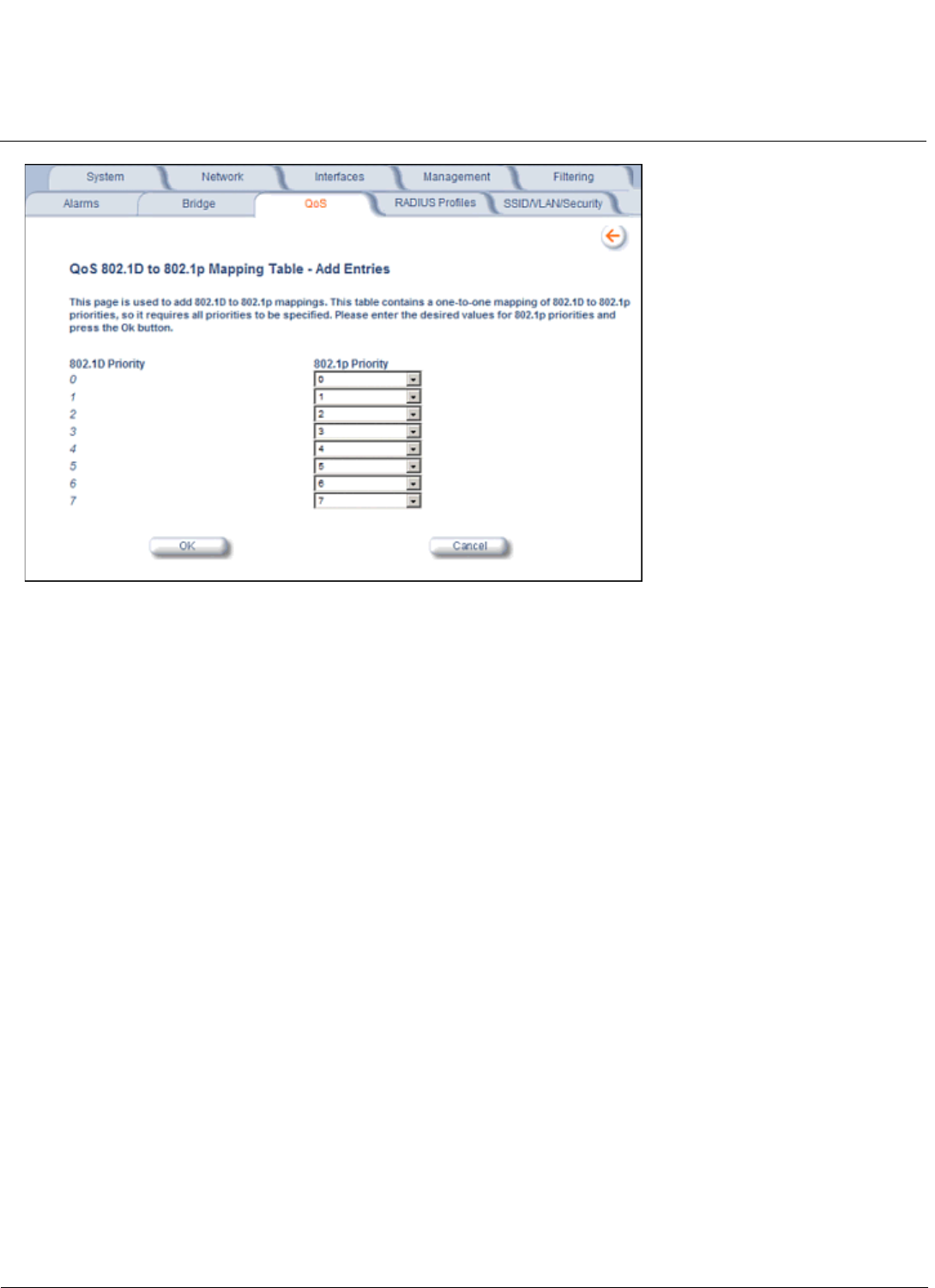
Advanced Configuration AP-700 User Guide
QoS
99
Figure 4-40 Add Priority Mapping Entry
3. Select the 802.1p Priority (from 0-7) for 802.1d Priorities 0-7.
4. Click OK.
5. Click Add in the IP Precedence/DSCP ranges and 802.1d Priority table.
6. Select the IP DSCP Range for each 802.1d Priority.
7. Click OK.
NOTE: Changes to Priority Mapping require a reboot of the AP to take effect.
Enhanced Distributed Channel Access (EDCA)
WME uses Enhanced Distributed Channel Access, a prioritized CSMA/CA access mechanism used by WME-enabled
clients/AP in a WME enabled BSS to realize different classes of differentiated Channel Access.
A wireless Entity is defined as all wireless clients and APs in the wireless medium contending for the common wireless
medium. EDCA uses a separate channel access function for each of the Access Categories (Index) within a wireless
entity. Each channel access function in a wireless entity that contends for the wireless medium as if it were a separate
client contending for the wireless medium. Different channel access functions in a given Wireless Entity contend among
themselves for access to the wireless medium in addition to contending with other clients.
STA EDCA Table and AP EDCA Table
This page is used to configure the client (STA) and AP Enhanced Distributed Channel Access (EDCA) parameters. You
can modify the EDCA values.
The EDCA parameter set provides information needed by the client stations for proper QoS operation during the wireless
contention period. These parameters are used by the QoS enabled AP to establish policy, to change policies when
accepting new stations or new traffic, or to adapt to changes in the offered load. The EDCA parameters assign priorities
to traffic types where higher priority packets gain access to the wireless medium more frequently than lower priority
packets.
NOTE: Default recommended values for EDCA parameters have been defined; Proxim recommends not modifying
EDCA parameters unless strictly necessary.
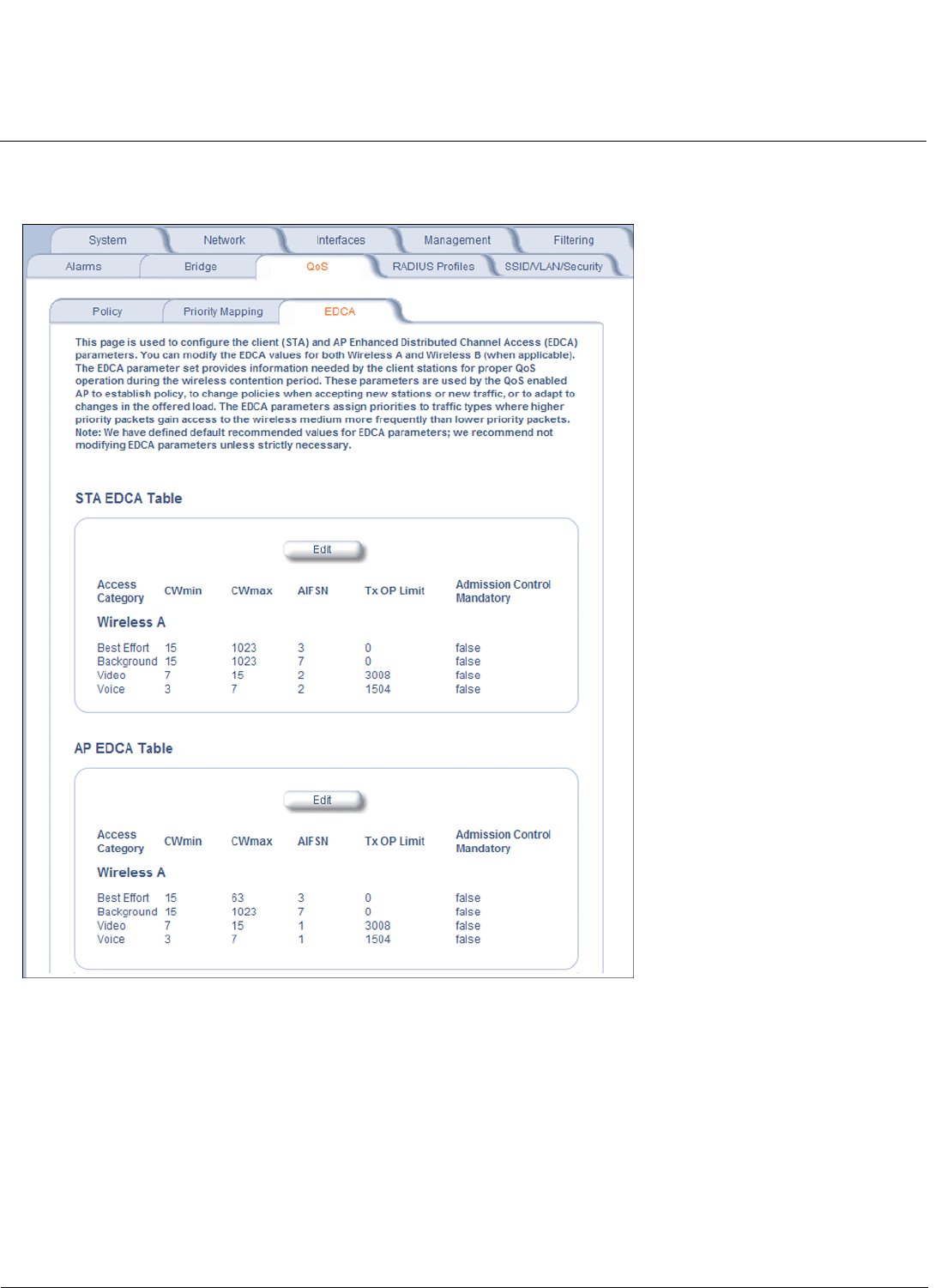
Advanced Configuration AP-700 User Guide
QoS
100
Perform the following procedure to configure the Station and AP EDCA tables.
1. Click Configure > QoS > EDCA.
Figure 4-41 EDCA Tables
2. Click Edit and configure the following parameters in each table:
NOTE: Changes to EDCA parameters require a reboot of the AP to take effect.
•Index: read-only. Indicates the index of the Access Category (1-4) being defined:
– 1 = Best Effort
– 2 = Background
–3 = Video
–4 = Voice
•CWMin: minimum Contention Window. Configurable range is 0 to 255.
•CWMax: maximum Contention Window. Configurable range is 0 to 65535.

Advanced Configuration AP-700 User Guide
QoS
101
•AIFSN: Arbitration IFS per access category. Configurable range is 2 to 15.
•Tx OP Limit: The Transmission Opportunity Limit. The Tx OP is an interval of time during which a particular QoS
enhanced client has the right to initiate a frame exchange sequence onto the wireless medium. The Tx OP Limit
defines the upper limit placed on the value of Tx OP a wireless entity can obtain for a particular access category.
Configurable range is 0 to 65535.
•MSDU Lifetime: specifies the maximum elapsed time between a MSDU transfer request and delivery to the
destination, beyond which delivery becomes unnecessary. Configurable range is 0 to 500 seconds.
•Admission Control Mandatory: Possible values are True or False. Admission control defines if an Access Point
accepts or rejects a requested traffic stream with certain QoS specifications, based on available channel capacity
and link conditions. Admission control can be configured for each Access Category (Index).
On the Policy sub-tab, the user can also configure a medium maximum threshold for all Admission Controls.
Admission will be granted if the new requested traffic stream and already admitted time is less than the medium
maximum threshold.

Advanced Configuration AP-700 User Guide
Radius Profiles
102
Radius Profiles
Configuring Radius Profiles on the AP allows the administrator to define a profile for RADIUS Servers used by the system
or by a VLAN. The network administrator can define RADIUS Servers per Authentication Mode and per VLAN.
The AP communicates with the RADIUS server defined in a profile to provide the following features:
•MAC Access Control Via RADIUS Authentication
•802.1x Authentication using RADIUS
•RADIUS Accounting
Also, RADIUS Based Management Access allows centralized user management.
The network administrator can configure default RADIUS authentication servers to be used on a system-wide basis, or in
networks with VLANs enabled the administrator can also configure separate authentication servers to be used for MAC
authentication, EAP authentication, or Accounting in each VLAN. You can configure the AP to communicate with up to six
different RADIUS servers per VLAN/SSID:
• Primary Authentication Server (MAC-based authentication)
• Back-up Authentication Server (MAC-based authentication)
• Primary Authentication Server (EAP/802.1x authentication)
• Back-up Authentication Server (EAP/802.1x authentication)
• Primary Accounting Server
• Back-up Accounting Server
The back-up servers are optional, but when configured, the AP will communicate with the back-up server if the primary
server is off-line. After the AP has switched to the backup server, it will periodically check the status of the primary
RADIUS server every five (5) minutes. Once the primary RADIUS server is again online, the AP automatically reverts
from the backup RADIUS server back to the primary RADIUS server. All subsequent requests are then sent to the
primary RADIUS server.
You can view monitoring statistics for each of the configured RADIUS servers.
RADIUS Servers per Authentication Mode and per VLAN
The user can configure separate RADIUS authentication servers for each authentication mode and for each SSID
(VLAN). For example:
• The user can configure separate RADIUS servers for RADIUS MAC authentication and 802.1x authentication
• The user can configure separate RADIUS servers for each VLAN: VLAN1 could support only WEP clients, whereas
VLAN2 could support 802.1x and WEP clients.
Figure 4-42 RADIUS Servers per VLAN
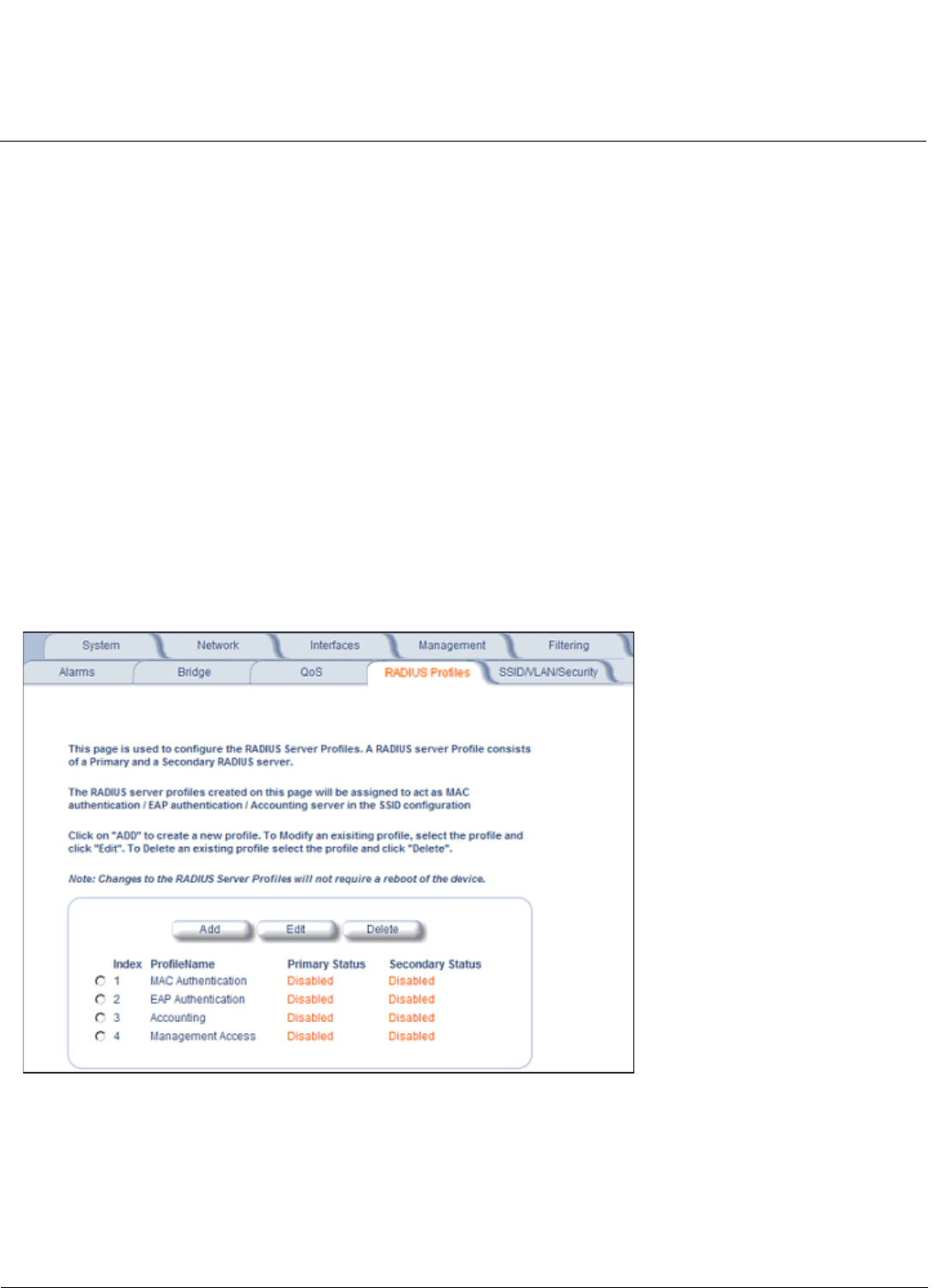
Advanced Configuration AP-700 User Guide
Radius Profiles
103
This figure shows a network with separate authentication servers for each authentication type and for each VLAN. The
clients in VLAN 1 are authenticated using the authentication servers configured for VLAN 1. The type of authentication
server used depends on whether the authentication is done for an 802.1x client or a non-802.1x client. The clients in
VLAN 2 are authenticated using a different set of authentication servers configured for authenticating users in VLAN 2.
Authentication servers for each VLAN are configured as part of the configuration options for that VLAN. RADIUS profiles
are independent of VLANs. The user can define any profile to be the default and associate all VLANs to that profile. Four
profiles are created by default, “MAC Authentication”, “EAP Authentication”, Accounting”, and “Management”.
RADIUS Servers Enforcing VLAN Access Control
A RADIUS server can be used to enforce VLAN access control in two ways:
• Authorize the SSID the client uses to connect to the AP. The SSID determines the VLAN that the client gets assigned
to.
• Assigning the user to a VLAN by specifying the VLAN membership information of the user.
Configuring Radius Profiles
A RADIUS server Profile consists of a Primary and a Secondary RADIUS server that get assigned to act as either MAC
Authentication servers, 802.1x/EAP Authentication servers, or Accounting Servers in the VLAN Configuration. See
Configuring Security Profiles.
The RADIUS Profiles tab allows you to add new RADIUS profiles or modify or delete existing profiles.
Figure 4-43 RADIUS Server Profiles
Adding or Modifying a RADIUS Server Profile
Perform the following procedure to add a RADIUS server profile and to configure its parameters.
1. Click Add to create a new profile. To Modify an existing profile, select the profile and click Edit. To delete an existing
profile, select the profile and click Delete. You cannot delete a RADIUS server profile if it is applied to an SSID.
2. Configure the following parameters for the RADIUS Server profile (see Figure 4-44):
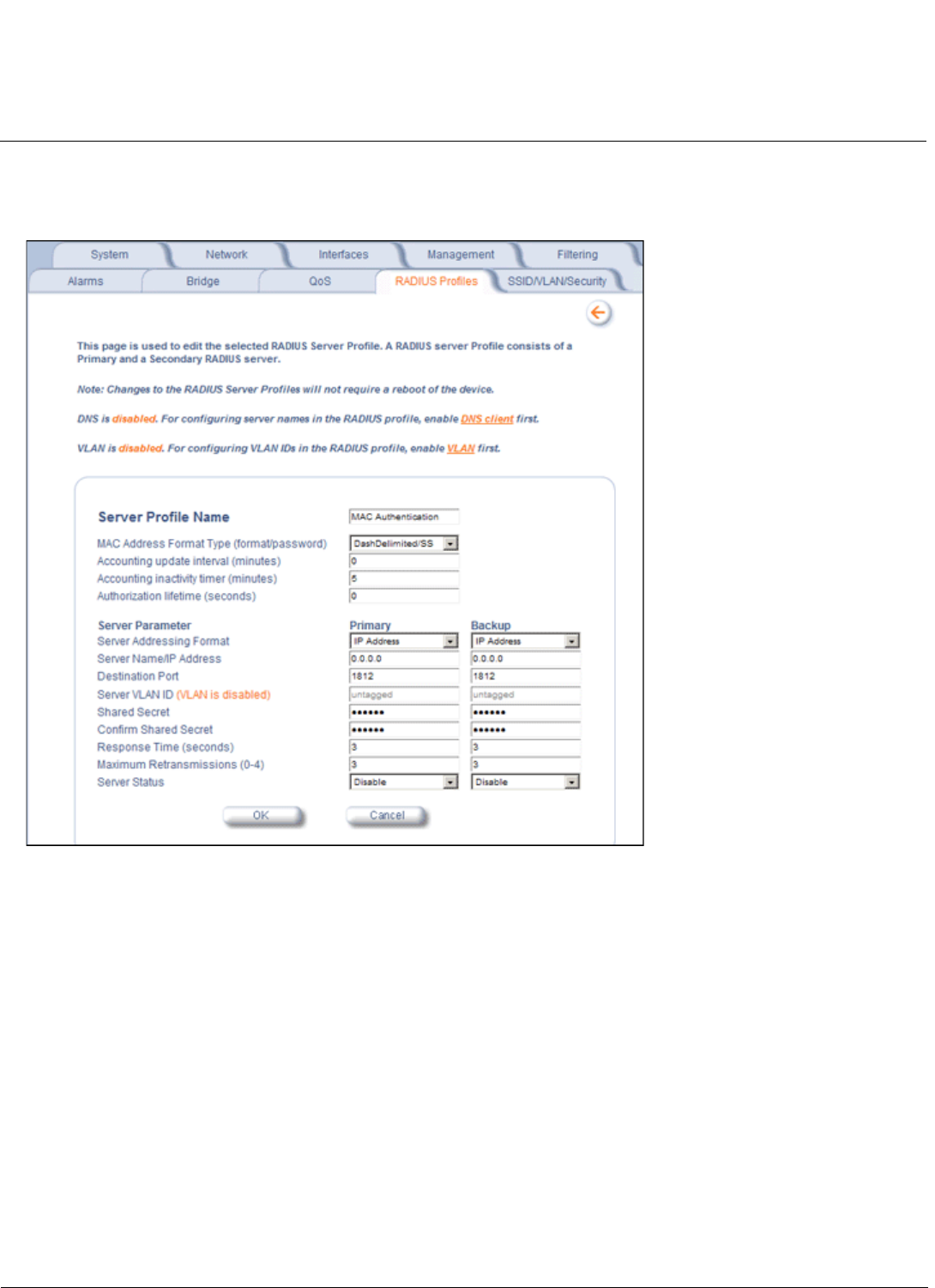
Advanced Configuration AP-700 User Guide
Radius Profiles
104
NOTE: This page configures only the Primary RADIUS Server associated with the profile. After configuring these
parameters, save them by clicking OK. Then, to configure the Secondary RADIUS Server, edit the profile from
the main page.
Figure 4-44 Add RADIUS Server Profile
•Server Profile Name: the profile name. This is the name used to associated a VLAN to the profile. See
Configuring Security Profiles. The Server Profile Name is also used in the Configure > Management > Services
page to specify the RADIUS profile to be used for RADIUS Based Management Access.
•MAC Address Format Type: This parameter should correspond to the format in which the clients’ 12-digit MAC
addresses are listed within the RADIUS server and the way passwords are sent to the RADIUS server. Available
options are:
– Dash delimited/SS: MAC addresses are formatted with a dash between each pair of digits (xx-yy-zz-aa-bb),
and the password sent to the RADIUS server is the shared secret (configured below).
– Colon delimited/SS: MAC addresses are formatted with a colon between each pair of digits (xx:yy:zz:aa:bb:cc)
and the password sent to the RADIUS server is the shared secret (configured below).
– Single dash delimited/SS: MAC addresses are formatted with a dash between the sixth and seventh digits
(xxyyzz-aabbcc) and the password sent to the RADIUS server is the shared secret (configured below).
– No delimiters/SS: MAC addresses are formatted with no characters or spaces between pairs of hexadecimal
digits (xxyyzzaabbcc) and the password sent to the RADIUS server is the shared secret (configured below).
– Dash delimited/MAC: MAC addresses are formatted with a dash between each pair of digits (xx-yy-zz-aa-bb),
and the password sent to the RADIUS server is the MAC address of the client.

Advanced Configuration AP-700 User Guide
Radius Profiles
105
– Colon delimited/MAC: MAC addresses are formatted with a colon between each pair of digits
(xx:yy:zz:aa:bb:cc) and the password sent to the RADIUS server is the MAC address of the client.
– Single dash delimited/MAC: MAC addresses are formatted with a dash between the sixth and seventh digits
(xxyyzz-aabbcc) and the password sent to the RADIUS server is the MAC address of the client.
– No delimiters/MAC: MAC addresses are formatted with no characters or spaces between pairs of hexadecimal
digits (xxyyzzaabbcc) and the password sent to the RADIUS server is the MAC address of the client.
•Accounting update interval: Enter the time interval (in minutes) for sending Accounting Update messages to the
RADIUS server. A value of 0 (default) means that the AP will not send Accounting Update messages.
•Accounting inactivity timer: Enter the accounting inactivity timer. This parameter supports a value from 1-60
minutes. The default is 5 minutes.
•Authorization lifetime: Enter the time, in seconds, each client session may be active before being automatically
re-authenticated. This parameter supports a value between 900 and 43200 seconds. The default is 0 (disabled).
•Server Addressing Format: select IP Address or Name. If you want to identify RADIUS servers by name, you
must configure the AP as a DNS Client. See DNS Client for details.
•Server Name/IP Address: Enter the server’s name or IP address.
•Destination Port: Enter the port number which the AP and the server will use to communicate. By default,
RADIUS servers communicate on port 1812.
•Server VLAN ID: Indicates the VLAN that uses this RADIUS server profile. If VLAN is disabled, this field will be
grayed out.
•Shared Secret and Confirm Shared Secret: Enter the password shared by the RADIUS server and the AP. The
same password must also be configured on the RADIUS server. The default password is “public.”
•Response Time (seconds): Enter the maximum time, in seconds, that the AP should wait for the RADIUS server
to respond to a request. The range is 1-10 seconds; the default is 3 seconds.
•Maximum Retransmissions (0-4): Enter the maximum number of times an authentication request may be
transmitted. The range is 0 to 4, the default is 3.
•Server Status: Select Enable from the drop-down box to enable the RADIUS Server Profile.
3. Click OK.
4. Select the Profile and click Edit to configure the Secondary RADIUS Server, if required.
MAC Access Control Via RADIUS Authentication
If you want to control wireless access to the network and if your network includes a RADIUS Server, you can store the list
of MAC addresses on the RADIUS server rather than configure each AP individually. You can define a RADIUS Profile
that specifies the IP Address of the server that contains a central list of MAC Address values identifying the authorized
stations that may access the wireless network. You must specify information for at least the primary RADIUS server. The
back-up RADIUS server is optional.
NOTE: Each VLAN can be configured to use a separate RADIUS server (and backup server) for MAC authentication.
MAC access control can be separately enabled for each VLAN.
NOTE: Contact your RADIUS server manufacturer if you have problems configuring the server or have problems using
RADIUS authentication.
802.1x Authentication using RADIUS
You must configure a primary EAP/802.1x Authentication server to use 802.1x security. A back-up server is optional.
NOTE: Each VLAN can be configured to use a separate RADIUS server (and backup server) for 802.1x authentication.
802.1x authentication (“EAP authentication”) can be separately enabled for each VLAN.

Advanced Configuration AP-700 User Guide
Radius Profiles
106
RADIUS Accounting
Using an external RADIUS server, the AP can track and record the length of client sessions on the access point by
sending RADIUS accounting messages per RFC2866. When a wireless client is successfully authenticated, RADIUS
accounting is initiated by sending an “Accounting Start” request to the RADIUS server. When the wireless client session
ends, an “Accounting Stop” request is sent to the RADIUS server.
NOTE: Each VLAN can be configured to use a separate RADIUS accounting server (and backup accounting server).
Session Length
Accounting sessions continue when a client reauthenticates to the same AP. Sessions are terminated when:
• A client disassociates.
• A client does not transmit any data to the AP for a fixed amount of time.
• A client is detected on a different interface.
• Idle-Timeout or Session-Timeout attributes are configured in the Radius server.
If the client roams from one AP to another, one session is terminated and a new session is begun.
NOTE: This feature requires RADIUS authentication using MAC Access Control or 802.1x. Wireless clients configured in
the Access Point’s static MAC Access Control list are not tracked.
Authentication and Accounting Attributes
Additionally, the AP supports a number of Authentication and Accounting Attributes defined in RFC2865, RFC2866,
RFC2869, and RFC3580.
Authentication Attributes
• State: Received in Access-Accept Packet by the AP during Authentication and sent back as-is during
Re-Authentication.
• Class: Received in Access-Accept Packet by the AP during Authentication and back as in Accounting Packets.
• Session-Timeout
– If the RADIUS server does not send a Session-Timeout, the AP will set the subscriber expiration time to 0, which
means indefinite access.
– The Termination Action attribute defines how the Session-Timeout attribute will be interpreted. If the Termination
Action is DEFAULT, then the session is terminated on expiration of the Session-Timeout time interval. If
Termination Action is RADIUS-Request, then re-authentication is done on expiration on the session.
– If the RADIUS server sends a Session-Timeout, the value specified by the Session-Timeout attribute will take
precedence over the configured Authorization Lifetime value.
• Termination-Action
– Valid values are: Default (0), RADIUS-Request (1). When the value is “default,” the Termination-Action attribute
sends an accounting stop message and then reauthenticates. If the value is “RADIUS-Request,” the
Termination-Action attribute reauthenticates without sending an accounting stop.
• Idle Timeout
– The AP internally maintains the Idle-Timeout attribute obtained for each of the users during their authentication
process, and uses this time interval in place of accounting inactivity time for timing out clients.
• Calling Station Id
– MAC address of the client being authenticated.
• Called Station Id
– The AP sends the MAC address of its own wireless interface with which the client getting authenticated is getting
associated, appended with the SSID. If VLAN is enabled, the SSID and corresponding VLAN ID get appended.
• Acct-Interim-Interval

Advanced Configuration AP-700 User Guide
Radius Profiles
107
– Obtained during the Authentication process and used for determining the time interval for sending Accounting
Update messages.
– This attribute value takes precedence over the value of the Accounting Update Interval.
Accounting Attributes
• Acct-Delay-Time
– Indicates how many seconds the AP has been trying to send a particular packet related to a particular user. This
time can be used at the server to determine the approximate time of the event generating this accounting request.
• Acct-Session-Id
– Unique accounting ID that aids in tracking client accounting records. This attribute is sent in Start and Stop
RADIUS accounting messages, and contains the client MAC address appended with the unique session ID.
•Acct-Session-Time
– Acct-Session-Time is calculated the following way (for each transmitted/retransmitted Acct-Stop):
Acct-Session-Time = time of last sent packet - subscriber login time.
• Acct-Input-Octets
– Number of octets (bytes) received by subscriber.
• Acct-Output-Octets
– Number of octets (bytes) sent by subscriber.
• Acct-Input-Packets
– Number of packets received by subscriber.
• Acct-Output-Packets
– Number of packets sent by subscriber.
• Acct-Terminate Cause
– Indicates how the session was terminated.
• Vendor Specific Attributes

Advanced Configuration AP-700 User Guide
SSID/VLAN/Security
108
SSID/VLAN/Security
The AP provides several security features to protect your network from unauthorized access. This section gives an
overview of VLANs and then discusses the SSID/VLAN/Security configuration options in the AP:
•VLAN Overview
•Management VLAN
•Security Profile
•MAC Access
•Wireless
The AP also provides Broadcast Unique Beacon/Closed System and Rogue Scan to protect your network from
unauthorized access. See the Wireless and Rogue Scan sections from more information.
VLAN Overview
Virtual Local Area Networks (VLANs) are logical groupings of network hosts. Defined by software settings, other VLAN
members or resources appear (to clients) to be on the same physical segment, no matter where they are attached on the
logical LAN or WAN segment. They simplify traffic flow between clients and their frequently-used or restricted resources.
VLANs now extend as far as the reach of the access point signal. Clients can be segmented into wireless sub-networks
via SSID and VLAN assignment. A Client can access the network by connecting to an AP configured to support its
assigned SSID/VLAN.
AP devices are fully VLAN-ready; however, by default VLAN support is disabled. Before enabling VLAN support, certain
network settings should be configured, and network resources such as a VLAN-aware switch, a RADIUS server, and
possibly a DHCP server should be available.
Once enabled, VLANs are used to conveniently, efficiently, and easily manage your network in the following ways:
• Manage adds, moves, and changes from a single point of contact
• Define and monitor groups
• Reduce broadcast and multicast traffic to unnecessary destinations
– Improve network performance and reduce latency
• Increase security
– Secure network restricts members to resources on their own VLAN
– Clients roam without compromising security
VLAN tagged data is collected and distributed through an AP's wireless interface(s) based on Network Name (SSID). An
Ethernet port on the access point connects a wireless cell or network to a wired backbone. The access points
communicate across a VLAN-capable switch that analyzes VLAN-tagged packet headers and directs traffic to the
appropriate ports. On the wired network, a RADIUS server authenticates traffic and a DHCP server manages IP
addresses for the VLAN(s). Resources like servers and printers may be present, and a hub may include multiple APs,
extending the network over a larger area.
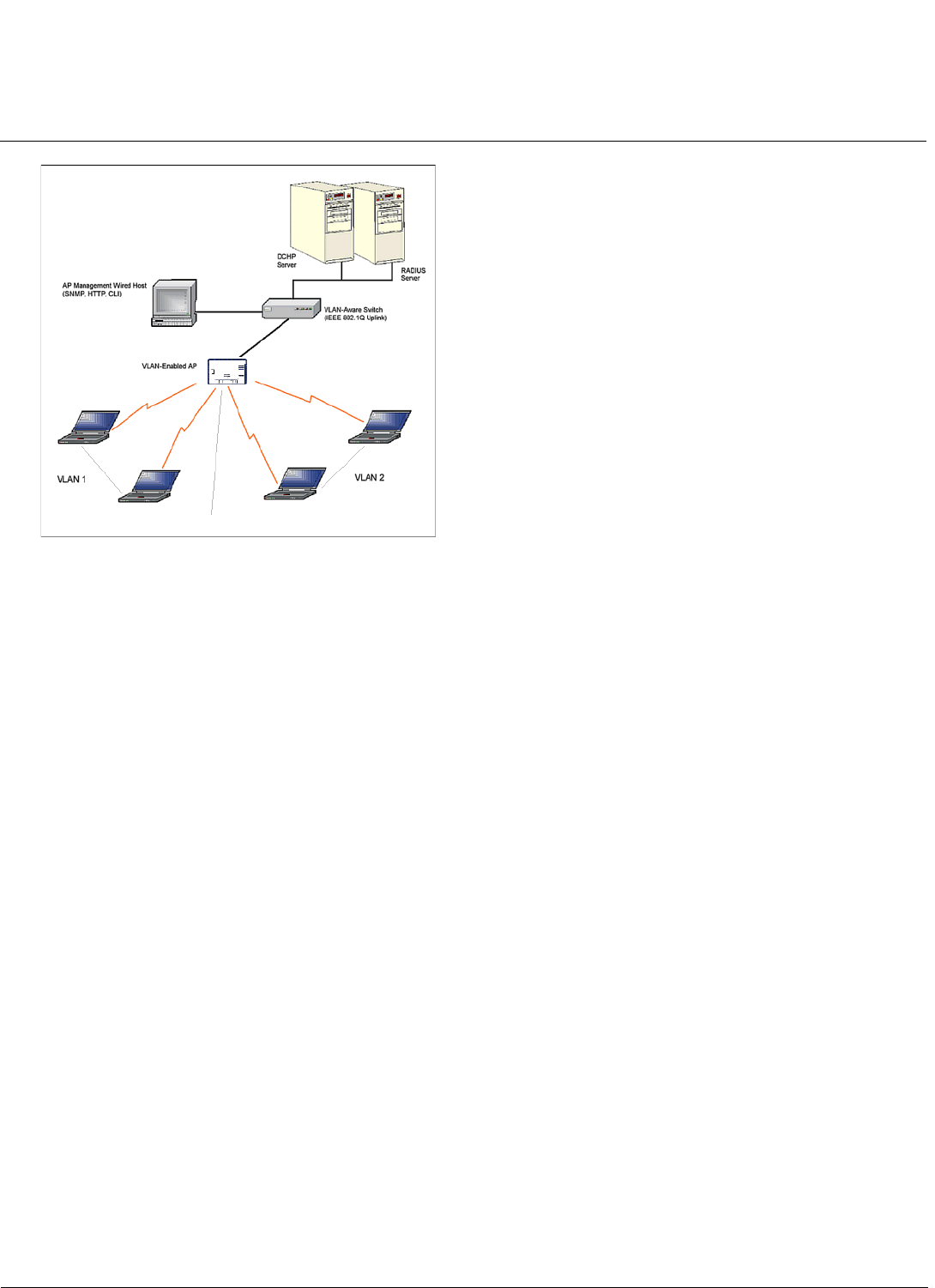
Advanced Configuration AP-700 User Guide
SSID/VLAN/Security
109
Figure 4-45 Components of a Typical VLAN
VLAN Workgroups and Traffic Management
Access Points that are not VLAN-capable typically transmit broadcast and multicast traffic to all wireless Network
Interface Cards (NICs). This process wastes wireless bandwidth and degrades throughput performance. In comparison,
a VLAN-capable AP is designed to efficiently manage delivery of broadcast, multicast, and unicast traffic to wireless
clients.
The AP assigns clients to a VLAN based on a Network Name (SSID). The AP can support up to 16 SSIDs per radio, with
a unique VLAN configurable per SSID.
The AP matches packets transmitted or received to a network name with the associated VLAN. Traffic received by a
VLAN is only sent on the wireless interface associated with that same VLAN. This eliminates unnecessary traffic on the
wireless LAN, conserving bandwidth and maximizing throughput.
In addition to enhancing wireless traffic management, the VLAN-capable AP supports easy assignment of wireless users
to workgroups. In a typical scenario, each user VLAN represents a workgroup; for example, one VLAN could be used for
an EMPLOYEE workgroup and the other for a GUEST workgroup.
In this scenario, the AP would assign every packet it accepted to a VLAN. Each packet would then be identified as
EMPLOYEE or GUEST, depending on which wireless NIC received it. The AP would insert VLAN headers or “tags” with
identifiers into the packets transmitted on the wired backbone to a network switch.
Finally, the switch would be configured to route packets from the EMPLOYEE workgroup to the appropriate corporate
resources such as printers and servers. Packets from the GUEST workgroup could be restricted to a gateway that
allowed access to only the Internet. A member of the GUEST workgroup could send and receive e-mail and access the
Internet, but would be prevented from accessing servers or hosts on the local corporate network.
Typical User VLAN Configurations
VLANs segment network traffic into workgroups, which enable you to limit broadcast and multicast traffic. Workgroups
enable clients from different VLANs to access different resources using the same network infrastructure. Clients using the
same physical network are limited to those resources available to their workgroup.
The AP can segment users into a maximum of 16 different workgroups, based on an SSID/VLAN grouping (also referred
as a VLAN Workgroup or a Sub-network).
The primary scenarios for using VLAN workgroups are as follows:
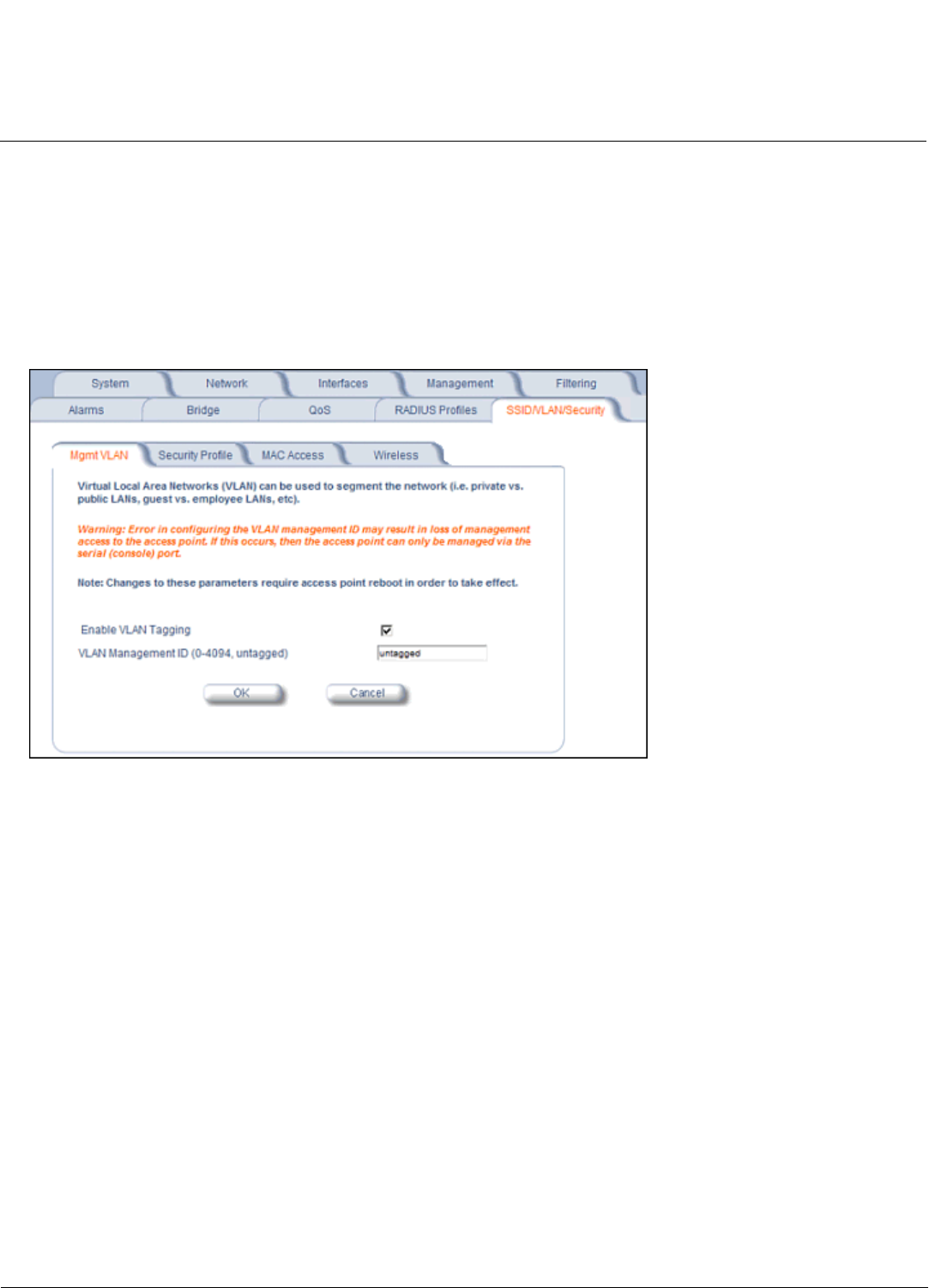
Advanced Configuration AP-700 User Guide
SSID/VLAN/Security
110
1. VLAN disabled: Your network does not use VLANs, and you cannot configure the AP to use multiple SSIDs.
2. VLAN enabled, each VLAN workgroup uses a different VLAN ID Tag.
3. VLAN enabled, a mixture of Tagged and Untagged workgroups exist.
4. VLAN enabled, all VLANs untagged: VLAN is enabled in order to use SSID. (Note that typical use of SSIDs assumes
actual use of VLANs.)
NOTE: VLAN must be enabled to configure security per SSID.
Management VLAN
Figure 4-46 Mgmt VLAN
VLAN Tagging Management
Control Access to the AP
Management access to the AP can easily be secured by making management stations or hosts and the AP itself
members of a common VLAN. Simply configure a non-zero management VLAN ID and enable VLAN to restrict
management of the AP to members of the same VLAN.
CAUTION: If a non-zero management VLAN ID is configured then management access to the AP is restricted to wired
or wireless hosts that are members of the same VLAN. Ensure your management platform or host is a
member of the same VLAN before attempting to manage the AP.
NOTE: When VLAN is enabled, ensure that all devices in the network share the same VLAN ID.
1. Click Configure > SSID/VLAN/Security > Mgmt VLAN.
2. Set the VLAN Management ID to a value of between 1 and 4094. (A value of -1 disables VLAN Tagging).
3. Place a check mark in the Enable VLAN Tagging box.
Provide Access to a Wireless Host in the Same Workgroup
The VLAN feature can allow wireless clients to manage the AP. If the VLAN Management ID matches a VLAN User ID,
then those wireless clients who are members of that VLAN will have AP management access.

Advanced Configuration AP-700 User Guide
SSID/VLAN/Security
111
CAUTION: Once a VLAN Management ID is configured and is equivalent to one of the VLAN User IDs on the AP, all
members of that User VLAN will have management access to the AP. Be careful to restrict VLAN
membership to those with legitimate access to the AP.
NOTE: When VLAN is enabled, ensure that all devices in the network share the same VLAN ID.
1. Click Configure > SSID/VLAN/Security > Mgmt VLAN.
2. Set the VLAN Management ID to use the same VLAN ID as one of the configured SSIDs.
3. Place a check mark in the Enable VLAN Tagging box.
Disable VLAN Tagging
1. Click Configure > SSID/VLAN/Security > Mgmt VLAN.
2. Remove the check mark from the Enable VLAN Tagging box (to disable all VLAN functionality) or set the VLAN
Management ID to -1 (to disable VLAN Tagging only).
NOTE: If you disable VLAN Tagging, you will be unable to configure security per SSID.
Security Profile
See the following sections:
•Security Features
•Authentication Protocol Hierarchy
•VLANs and Security Profiles
•Configuring Security Profiles
Security Features
The AP supports the following security features:
•WEP Encryption: The original encryption technique specified by the IEEE 802.11 standard.
•802.1x Authentication: An IEEE standard for client authentication.
•Wi-Fi Protected Access (WPA/802.11i [WPA2]): A new standard that provides improved encryption security over WEP.
NOTE: The AP does not support shared key 802.11 MAC level authentication. Clients with this MAC level feature must
disable it.
WEP Encryption
The IEEE 802.11 standards specify an optional encryption feature, known as Wired Equivalent Privacy or WEP, that is
designed to provide a wireless LAN with a security level equal to what is found on a wired Ethernet network. WEP
encrypts the data portion of each packet exchanged on an 802.11 network using an Encryption Key (also known as a
WEP Key).
When Encryption is enabled, two 802.11 devices must have the same Encryption Keys and both devices must be
configured to use Encryption in order to communicate. If one device is configured to use Encryption but a second device
is not, then the two devices will not communicate, even if both devices have the same Encryption Keys.
802.1x Authentication
IEEE 802.1x is a standard that provides a means to authenticate and authorize network devices attached to a LAN port.
A port in the context of IEEE 802.1x is a point of attachment to the LAN, either a physical Ethernet connection or a
wireless link to an Access Point. 802.1x requires a RADIUS server and uses the Extensible Authentication Protocol
(EAP) as a standards-based authentication framework, and supports automatic key distribution for enhanced security.
The EAP-based authentication framework can easily be upgraded to keep pace with future EAP types.
Popular EAP types include:
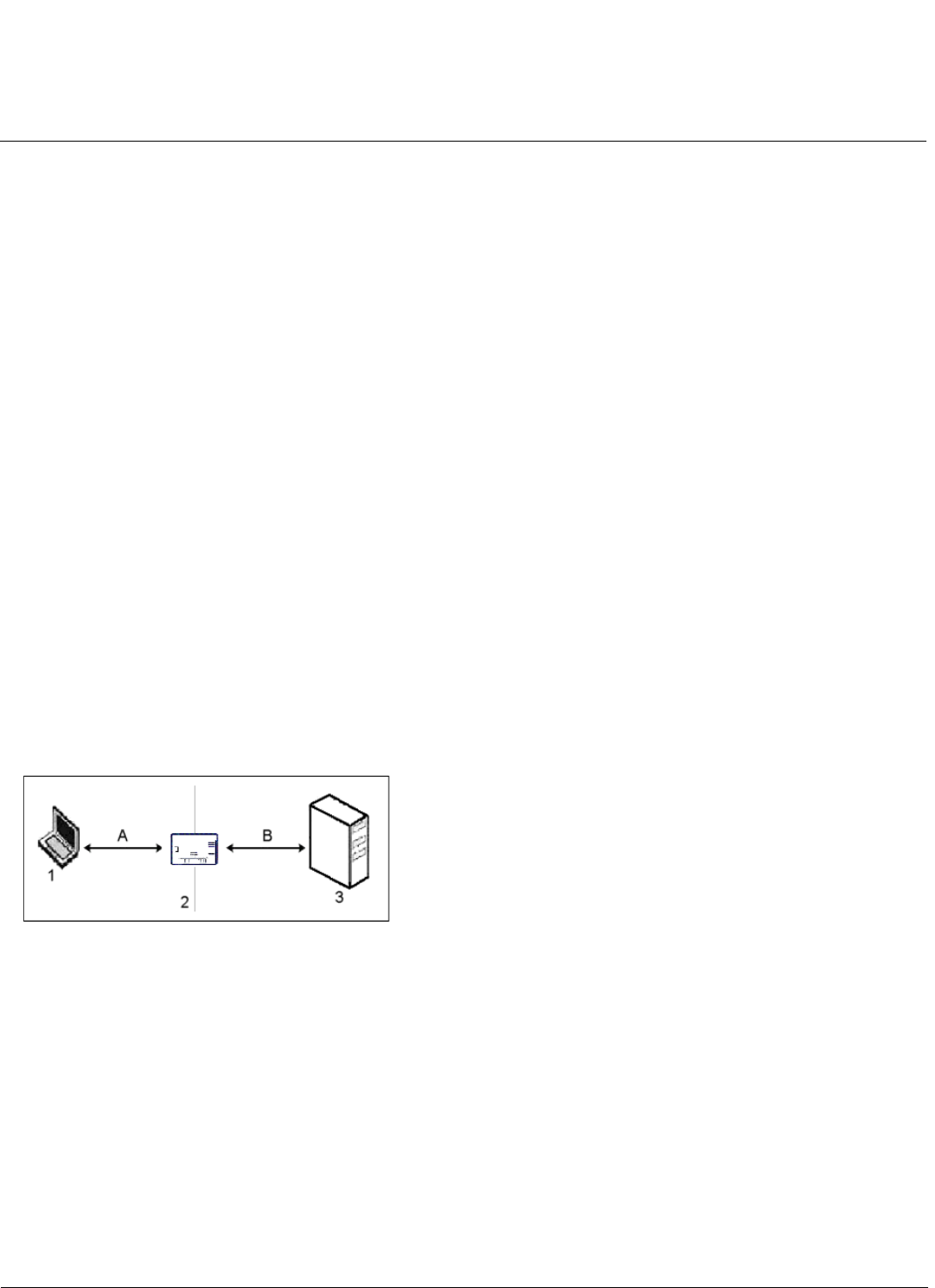
Advanced Configuration AP-700 User Guide
SSID/VLAN/Security
112
• EAP-Message Digest 5 (MD5): Username/Password-based authentication; does not support automatic key
distribution
• EAP-Transport Layer Security (TLS): Certificate-based authentication (a certificate is required on the server and each
client); supports automatic key distribution
• EAP-Tunneled Transport Layer Security (TTLS): Certificate-based authentication (a certificate is required on the
server; a client’s username/password is tunneled to the server over a secure connection); supports automatic key
distribution
• PEAP - Protected EAP with MS-CHAP: Secure username/password-based authentication; supports automatic key
distribution
Different servers support different EAP types and each EAP type provides different features. See the documentation that
came with your RADIUS server to determine which EAP types it supports.
NOTE: The AP supports the following EAP types when Security Mode is set to 802.1x, WPA, or 802.11i (WPA2):
EAP-TLS, PEAP, EAP-TTLS, EAP-MD5, and EAP-SIM.
Authentication Process
There are three main components in the authentication process. The standard refers to them as:
1. Supplicant (client PC)
2. Authenticator (Access Point)
3. Authentication server (RADIUS server)
When the Security Mode is set to 802.1x Station, WPA Station, or 802.11i Station you need to configure your RADIUS
server for authentication purposes.
Prior to successful authentication, an unauthenticated client PC cannot send any data traffic through the AP device to
other systems on the LAN. The AP inhibits all data traffic from a particular client PC until the client PC is authenticated.
Regardless of its authentication status, a client PC can always exchange 802.1x messages in the clear with the AP (the
client begins encrypting data after it has been authenticated).
Figure 4-47 RADIUS Authentication Illustrated
The AP acts as a pass-through device to facilitate communications between the client PC and the RADIUS server. The
AP (2) and the client (1) exchange 802.1x messages using an EAPOL (EAP Over LAN) protocol (A). Messages sent from
the client station are encapsulated by the AP and transmitted to the RADIUS (3) server using EAP extensions (B).
Upon receiving a reply EAP packet from the RADIUS, the message is typically forwarded to the client, after translating it
back to the EAPOL format. Negotiations take place between the client and the RADIUS server. After the client has been
successfully authenticated, the client receives an Encryption Key from the AP (if the EAP type supports automatic key
distribution). The client uses this key to encrypt data after it has been authenticated.
For 802.11a and 802.11b/g clients that communicate with an AP, each client receives its own unique encryption key; this
is known as Per User Per Session Encryption Keys.

Advanced Configuration AP-700 User Guide
SSID/VLAN/Security
113
Wi-Fi Protected Access (WPA/802.11i [WPA2])
Wi-Fi Protected Access (WPA) is a security standard designed by the Wi-Fi Alliance in conjunction with the Institute of
Electrical and Electronics Engineers (IEEE). The AP supports 802.11i (WPA2), based on the IEEE 802.11i security
standard.
WPA is a replacement for Wired Equivalent Privacy (WEP), the encryption technique specified by the original 802.11
standard. WEP has several vulnerabilities that have been widely publicized. WPA addresses these weaknesses and
provides a stronger security system to protect wireless networks.
WPA provides the following new security measures not available with WEP:
• Improved packet encryption using the Temporal Key Integrity Protocol (TKIP) and the Michael Message Integrity
Check (MIC).
• Per-user, per-session dynamic encryption keys:
– Each client uses a different key to encrypt and decrypt unicast packets exchanged with the AP
– A client's key is different for every session; it changes each time the client associates with an AP
– The AP uses a single global key to encrypt broadcast packets that are sent to all clients simultaneously
– Encryption keys change periodically based on the Re-keying Interval parameter
– WPA uses 128-bit encryption keys
• Dynamic Key distribution
– The AP generates and maintains the keys for its clients
– The AP securely delivers the appropriate keys to its clients
• Client/server mutual authentication
–802.1x
– Pre-shared key (for networks that do not have an 802.1x solution implemented)
The AP supports the following WPA security modes:
•WPA: The AP uses 802.1x to authenticate clients and TKIP for encryption. You should only use an EAP that supports
mutual authentication and session key generation, such as EAP-TLS, EAP-TTLS, and PEAP. See 802.1x
Authentication for details.
•WPA-PSK (Pre-Shared Key): For networks that do not have 802.1x implemented, you can configure the AP to
authenticate clients based on a Pre-Shared Key. This is a shared secret that is manually configured on the AP and
each of its clients. The Pre-Shared Key must be 256 bits long, which is either 64 hexadecimal digits or 32
alphanumeric characters. The AP also supports a PSK Pass Phrase option to facilitate the creation of the TKIP
Pre-Shared Key (so a user can enter an easy-to-remember phrase rather than a string of characters).
•802.11i (also known as WPA2): The AP provides security to clients according to the 802.11i draft standard, using
802.1x authentication, a CCMP cipher based on AES, and re-keying.
•802.11i-PSK (also known as WPA2 PSK): The AP uses a CCMP cipher based on AES, and encrypts frames to clients
based on a Pre-Shared Key. The Pre-Shared Key must be 256 bits long, which is either 64 hexadecimal digits or 32
alphanumeric characters. The AP also supports a PSK Pass Phrase option to facilitate the creation of the Pre-Shared
Key (so a user can enter an easy-to-remember phrase rather than a string of characters).
NOTE: For more information on WPA, see the Wi-Fi Alliance Web site at http://www.wi-fi.org.
Authentication Protocol Hierarchy
There is a hierarchy of authentication protocols defined for the AP. The hierarchy is as follows, from highest to lowest:
• 802.1x authentication (including 802.1x, WPA, WPA-PSK, 802.11i, 802.11i-PSK)
• MAC Access Control via RADIUS Authentication
• MAC Access Control through individual APs' MAC Access Control Lists

Advanced Configuration AP-700 User Guide
SSID/VLAN/Security
114
If you have both 802.1x and MAC Access Control authentication enabled, the 802.1x authentication takes precedence
because it is higher in the authentication protocol hierarchy. This is required in order to propagate the WEP/TKIP/AES
keys to the clients in such cases. If you disable 802.1x on the AP, you will see the effects of MAC authentication.
In addition, setting MAC Access Control status to Strict will cause both MAC ACL settings and 802.1x settings to be
applied.
For example, assume that the MAC Access Control List contains MAC addresses to block, and that WPA-PSK is
configured to allow access to clients with the appropriate PSK Passphrase.
• If the MAC ACL status is set to Enable, WPA-PSK will take precedence, and clients in the MAC ACL with the correct
PSK passphrase will be allowed. Only the WPA-PSK setting is taken into consideration.
• If the MAC ACL status is set to Strict, then clients in the MAC ACL will be blocked even if they have the correct PSK
passphrase. Clients will only be allowed if they have the correct passphrase and are NOT listed in the MAC ACL. In
this way, both MAC and WPA-PSK settings are taken into consideration.
VLANs and Security Profiles
The AP allows you to segment wireless networks into multiple sub-networks based on Network Name (SSID) and VLAN
membership. A Network Name (SSID) identifies a wireless network. Clients associate with Access Points that share an
SSID. During installation, the Setup Wizard prompts you to configure a Primary Network Name for each wireless
interface.
After initial setup and once VLAN is enabled, the AP can be configured to support up to 16 SSIDs to segment wireless
networks based on VLAN membership.
Each VLAN can associated to a Security Profile and RADIUS Server Profiles. A Security Profile defines the allowed
wireless clients, and authentication and encryption types. See the following sections for configuration details.
Configuring Security Profiles
Security policies can be configured and applied on the AP as a whole, or on a per VLAN basis. When VLAN is disabled
on the AP, the user can configure a security profile for each interface of the AP. When VLANs are enabled and Security
per SSID is enabled, the user can configure a security profile for each VLAN.
The user defines a security policy by specifying one or more values for the following parameters:
• Wireless STA types (WPA station, 802.11i (WPA2) station, 802.1x station, WEP station, WPA-PSK, and 802.11i-PSK)
that can associate to the AP.
• Authentication mechanisms (802.1x, RADIUS MAC authentication) that are used to authenticate clients for each type
of station.
• Cipher Suites (CCMP, TKIP, WEP, None) used for encapsulating the wireless data for each type of station.
Up to 16 security profiles can be configured.
1. Click Configure > SSID/VLAN/Security > Security Profile.
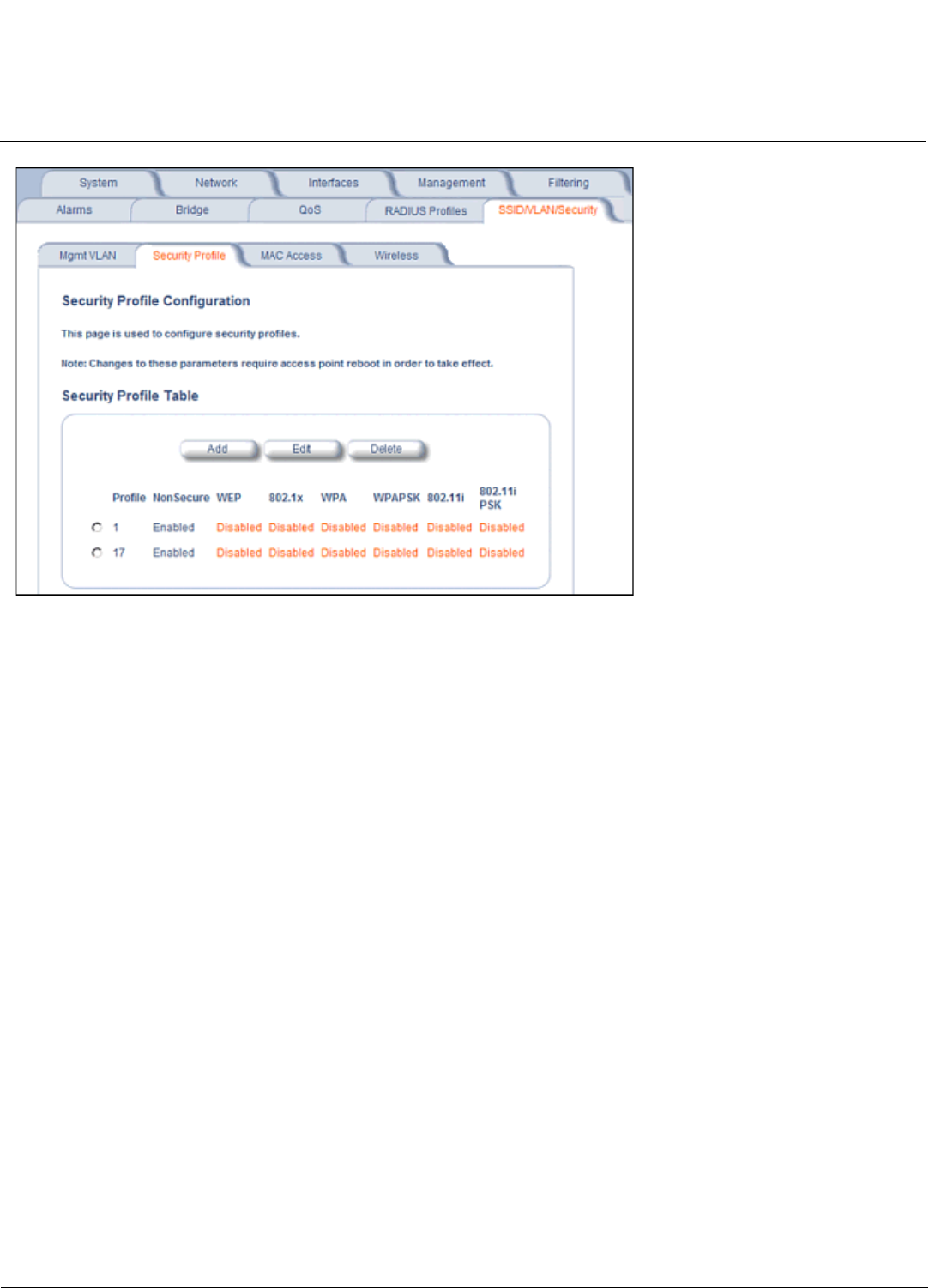
Advanced Configuration AP-700 User Guide
SSID/VLAN/Security
115
Figure 4-48 Security Profile Configuration
2. Click Add in the Security Profile Table to create a new entry. To modify an existing profile, select the profile and click
Edit. To delete an existing profile, select the profile and click Delete. You cannot delete a Security Profile used in an
SSID. Also, the first Security Profile cannot be deleted.
3. Configure one or more types of wireless stations (security modes) that are allowed access to the AP under the
security profile. The WEP/PSK parameters are separately configurable for each security mode. To enable a security
mode in the profile (Non Secure Station, WEP Station, 802.1x Station, WPA Station, WPA-PSK Station, 802.11i
(WPA2) Station, 802.11i-PSK Station), check the box next to the mode. See Figure 4-49.
If the security mode selected in a profile is WEP, WPA-PSK, or 802.11i-PSK, then you must configure the WEP or
Pre-Shared Keys.
NOTE: If an 802.1x client that has already been authenticated attempts to switch to WEP, or if a WEP client that has
already been connected attempts to switch to 802.1x, the AP will not allow the client to switch immediately. If
this happens, either reboot the AP or disable the client/roam to a new AP for five minutes, and then attempt to
reconnect to the AP. If the client is still unable to connect after waiting five minutes, reboot the AP.
4. Configure the parameters as follows for each enabled security mode. See Figure 4-49.
•Non Secure Station:
• Authentication Mode: None. The AP allows access to Stations without authentication.
— Non secure station should be used only with WEP or 802.1x security mode.
• Cipher: None
•WEP Station:
• Authentication Mode: None
• Cipher: WEP
• Encryption Key 0, Encryption Key 1, Encryption Key 2, Encryption Key 3
NOTE: When VLAN tagging is enabled, only Key 0 can be configured.
• Encryption Key Length: 64, 128, or 152 Bits.